Paul van Yperen's Blog, page 28
January 1, 2025
Ross Verlag, Part 16: Hänsom
Ross Verlag produced several series of interesting cigarette cards with film stars for the German tobacco industry. In the early 1930s, Ross published a few series for Hänsom cigarettes, manufactured by Jasmatzi Cigarettenfabrik G.M.b.H in Dresden. The small black and white cards give a view of the German film world in the final Weimar years. We chose 30 cigarette cards from different series with film directors, scenes from classic early sound films and portraits of fascinating actors. Many of them had to move from Germany when the Nazis took power in 1933.
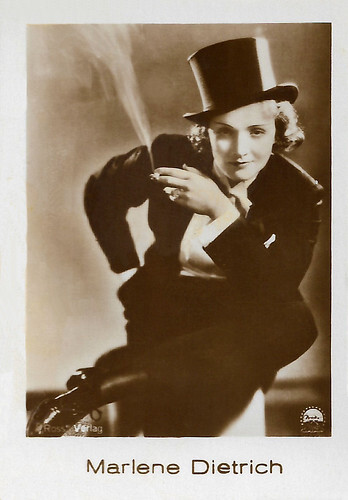
Small German card by Ross Verlag for Hänsom Cigaretten by Jasmatzi Cigaretten-Fabrik G.m.b.H., Dresden, Tonfilmseries 3, no. 358. Photo: Eugene Robert Richee / Paramount. Marlene Dietrich in Morocco (Josef von Sternberg, 1930).
Marlene Dietrich (1901-1992) was the first German actress who became successful in Hollywood. Throughout her long career, she constantly reinvented herself. In 1920s Berlin, she started as a cabaret singer, chorus girl, and film actress. In the 1930s, she became a Hollywood star, then a World War II frontline entertainer, and finally, she was an international stage show performer from the 1950s till the 1970s. Now we remember her as one of the icons of the 20th century.
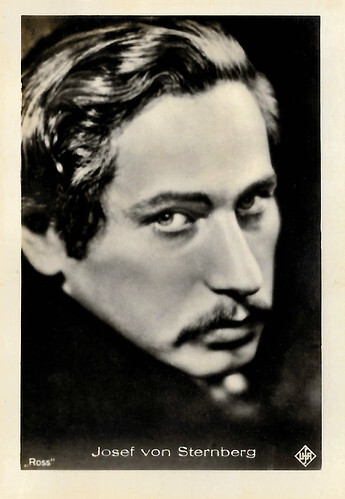
German cigarette card by Ross Verlag for Hänsom cigarettes by Jasmatzi Cigarettenfabrik G.M.b.H, Dresden, Film Series 4 'Aus tönenden Filmen' (From sound films), no. 505. Photo: Ufa.
Austrian-American film director Josef von Sternberg (1894-1969) is known as a great stylist, as the director of the prototypical Hollywood gangster film, Underworld (1927), and especially as the discoverer of Marlene Dietrich. He worked with her for the first time at the Ufa in Der blaue Engel/The Blue Angel (1930) and would subsequently make six more films with her in Hollywood. He was nominated for the Academy Award for Best Director for Morocco (1930) and Shanghai Express (1932). Along with Erich von Stroheim, Friedrich Wilhelm Murnau, Fritz Lang, Ernst Lubitsch and Billy Wilder, Von Sternberg belonged to the large group of German and Austrian film emigrants who helped to shape Hollywood cinema.
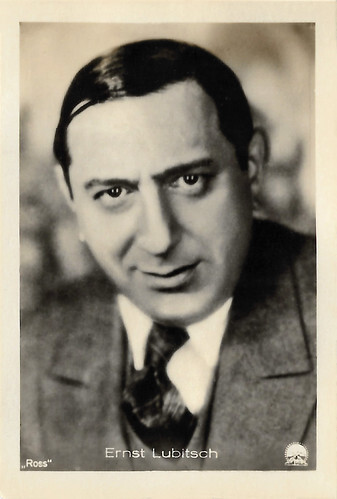
German cigarette card by Ross Verlag for Hänsom cigarettes by Jasmatzi Cigarettenfabrik G.M.b.H, Dresden, Film Series 4 'Aus tönenden Filmen' (From sound films), no. 506. Photo: Paramount.
Ernst Lubitsch (1892-1947) was a German-American actor, screenwriter, producer and film director. His urbane comedies of manners gave him the reputation of being Hollywood's most elegant and sophisticated director; as his prestige grew, his films were promoted as having ‘the Lubitsch touch.’ He was nominated three times for the Oscar for Best Director and in 1947, he received an Honorary Academy Award.
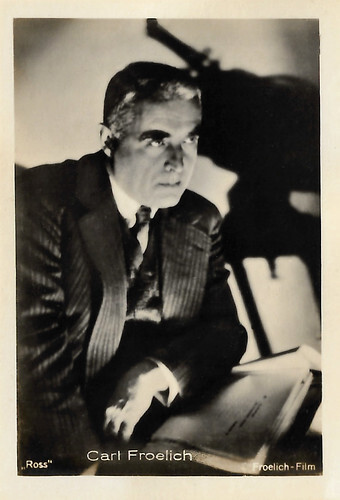
German cigarette card by Ross Verlag for Hänsom cigarettes by Jasmatzi Cigarettenfabrik G.M.b.H, Dresden, Film Series 4 'Aus tönenden Filmen' (From sound films), no. 508. Photo: Froelich-Film.
Carl Froelich (1875-1953) was a German film pioneer and film director, who made many silent films with Henny Porten and produced such classics as Die Brüder Karamasoff/The Brothers Karamazov (1922), the first German sound film, Die Nacht gehört uns/The Night Belongs To Us (1929) and the groundbreaking Mädchen in Uniform/Girls in Uniform (1931). In 1933, Froelich became a member of the National Socialist Party and later became President of the Reichsfilmkammer. After the end of the war, Froelich was arrested and in 1948 he was de-Nazified. Between 1912 and 1951 he made 77 films.
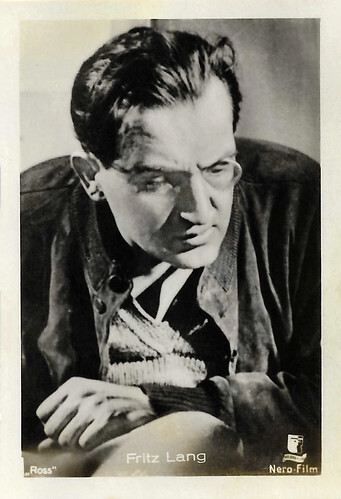
German cigarette card by Ross Verlag for Hänsom cigarettes by Jasmatzi Cigarettenfabrik G.M.b.H, Dresden, Film Series 4 'Aus tönenden Filmen' (From sound films), no. 509. Photo: Nero-Film.
Fritz Lang (1890-1976) was an Austrian-German-American filmmaker, screenwriter, and occasional film producer and actor. One of the best-known émigrés from Germany's school of Expressionism, he was dubbed the 'Master of Darkness' by the British Film Institute. Lang's most famous films include the groundbreaking futuristic Metropolis (1927) and the influential M (1931), a Film Noir precursor that he made before he moved to the United States. His other notable films include Dr. Mabuse, der Spieler/Dr. Mabuse the Gambler (1922), Die Nibelungen (1924), Fury (1936), You Only Live Once (1937), Hangmen Also Die! (1943), The Woman in the Window (1944), and The Big Heat (1953).
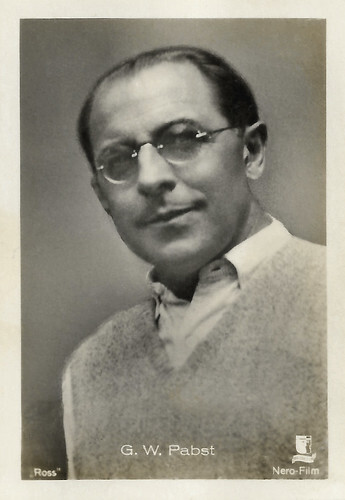
German cigarette card by Ross Verlag for Hänsom cigarettes by Jasmatzi Cigarettenfabrik G.M.b.H, Dresden, Film Series 4 'Aus tönenden Filmen' (From sound films), no. 510. Photo: Nero Film.
Austrian film director Georg Wilhelm Pabst (1885-1967) was together with Fritz Lang, Friedrich Wilhelm Murnau and Ernst Lubitsch one of the great film directors of the Weimar Republic of Germany. He worked in Germany, France, Italy and the US. Some of his best-known films deal with the situation of women in the Weimar Republic. His best-known films include Die freudlose Gasse (1925), Die Büchse der Pandora (1929), Die Dreigroschenoper (1931) and Kameradschaft (1931). During World War II, he made the films Komödianten (1941) and Paracelsus (1943) in Nazi Germany.
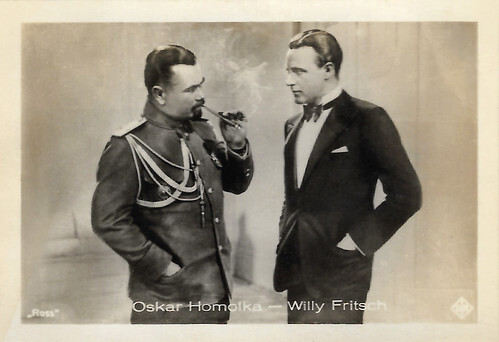
German cigarette card by Ross Verlag for Hänsom cigarettes by Jasmatzi Cigarettenfabrik G.M.b.H, Dresden, Film Series 4 'Aus tönenden Filmen' (From sound films), no. 519. Photo: Ufa. Oskar Homolka and Willy Fritsch in Im Geheimdienst/In the Employ of the Secret Service (Gustav Ucicky, 1931).
Austrian film and theatre actor Oskar Homolka (1898–1978) had a stocky appearance, bushy eyebrows and a rather Slavic-sounding name, which led many to believe he was Eastern European or Russian. His expressive face predestined him to play character roles as a scoundrel, pimp or communist spy. From the mid-1920s on, charming Willy Fritsch (1901-1973) replaced Bruno Kastner and Harry Liedtke as the darling of female cinemagoers in Germany. Fritsch became the immensely popular ‘Sunny Boy’ of the Ufa operettas of the 1930s and 1940s, and with his frequent co-star Lilian Harvey he formed the 'dream team of the German cinema'.
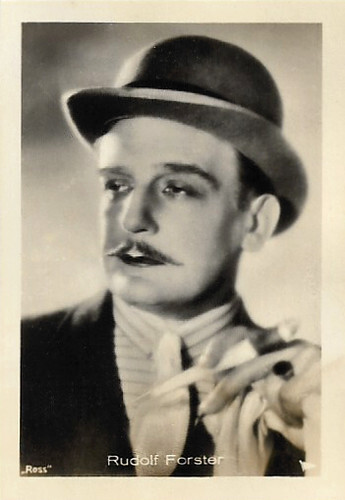
German cigarette card by Ross Verlag for Hänsom cigarettes by Jasmatzi Cigarettenfabrik G.M.b.H, Dresden, Film Series 4 'Aus tönenden Filmen' (From sound films), no. 533. Photo: National. Rudolf Forster in Die Dreigroschenoper/The Threepenny Opera (G.W. Pabst, 1931).
Austrian film actor Rudolf Forster (1884-1968) appeared in more than 100 films between 1914 and 1968. He was known for Zur Chronik von Grieshuus/Chronicles of the Gray House (1925), Die 3 Groschen-Oper/The Threepenny Opera (1931) and Das Glas Wasser/A Glass of Water (1960).
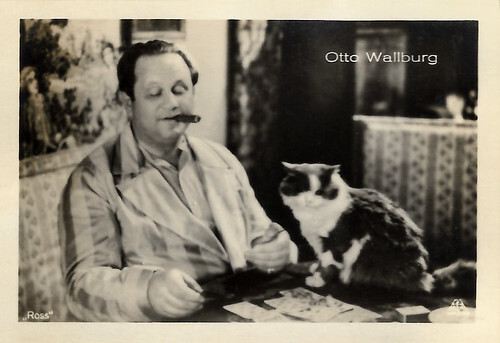
German cigarette card by Ross Verlag for Hänsom cigarettes by Jasmatzi Cigarettenfabrik G.M.b.H, Dresden, Film Series 4 'Aus tönenden Filmen' (From sound films), no. 536. Photo: Aafa-Film. Otto Wallburg in Lügen auf Rügen/The Isle of Lies (Victor Janson, 1932).
Otto Wallburg (1889-1944) was a popular actor of the Weimar cinema, who appeared in supporting roles as the overweight comedian. After the rise of the Nazis, the Jewish actor had to go into exile, first in Austria and later in the Netherlands. The Nazis murdered him in the Auschwitz concentration camp.
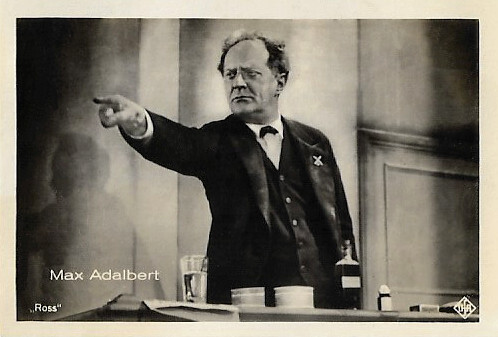
German cigarette card by Ross Verlag for Hänsom cigarettes by Jasmatzi Cigarettenfabrik G.M.b.H, Dresden, Film Series 4 'Aus tönenden Filmen' (From sound films), no. 572. Photo: Ufa. Max Adalbert in Das Ekel/The Scoundrel (Eugen Schüfftan, Franz Wenzler, 1931).
German stage and film actor Max Adalbert (1874-1933) was one of the great names of the German theatre at the beginning of the twentieth century. He was famous for his roles in comedies. His greatest success was the title role in the comedy Der Hauptmann von Köpenick/The Captain from Köpenick (1931) which he played on stage and in the cinema.
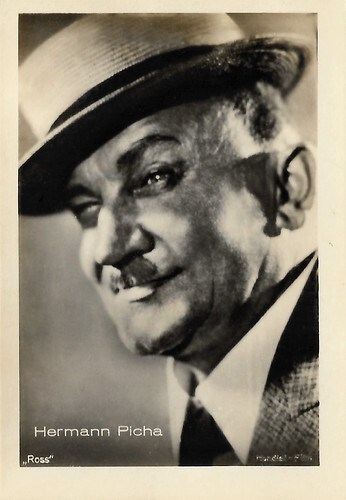
German cigarette card by Ross Verlag for Hänsom cigarettes by Jasmatzi Cigarettenfabrik G.M.b.H, Dresden, Film Series 4 'Aus tönenden Filmen' (From sound films), no. 573. Photo: Mondial Film.
German stage and film actor Hermann Picha (1865-1936) was very prolific in German cinema during the silent and early sound eras, appearing in over 300 short and feature films. Picha played a mixture of lead and supporting roles during his career. He played the title role in Schneider Wibbel/Wibbel the Tailor (Manfred Noa, 1920) and appeared in a supporting role in Fritz Lang's Expressionist fantasy classic Der müde Tod/Destiny (1921), inspired by the Indian folktale of Savitri.
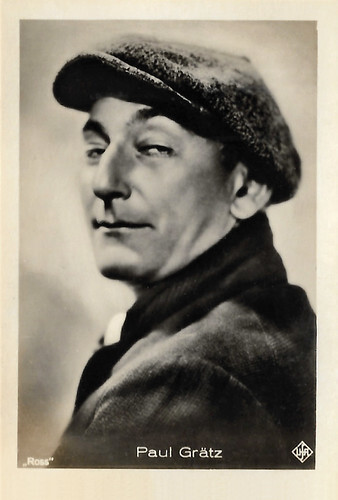
German cigarette card by Ross Verlag for Hänsom cigarettes by Jasmatzi Cigarettenfabrik G.M.b.H, Dresden, Film Series 4 'Aus tönenden Filmen' (From sound films), no. 576. Photo: Ufa. Paul Grätz in Das verlorene Paradies/The Lost Paradise (Philipp Lothar Mayring, 1931).
German stage actor Paul Graetz (1889-1937) often worked with stage director Max Reinhardt. He was a star in Berlin's cabaret. In films, Graetz played mostly comic and grotesque characters. The Jewish Graetz went into exile in 1933 and worked in London and Hollywood.
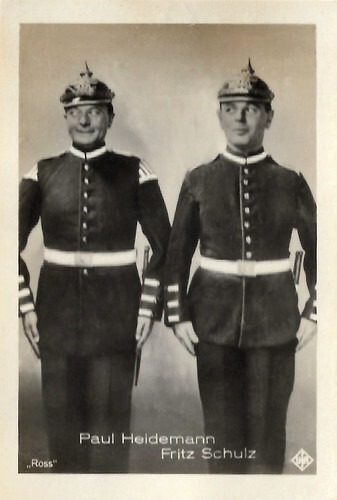
German cigarette card by Ross Verlag for Hänsom cigarettes by Jasmatzi Cigarettenfabrik G.M.b.H, Dresden, Film Series 4 'Aus tönenden Filmen' (From sound films), no. 601. Photo: Ufa. Paul Heidemann and Fritz Schulz in Dienst ist Dienst/Duty is Duty (Carl Boese 1931).
Paul Heidemann (1884-1968) was a German stage and screen actor, film director and film producer. He was famous for his comical parts. Austrian-born comic actor/director Fritz Schulz (1896-1972) appeared in more than one hundred films between 1917 and 1970. When the sound film arrived, he was one of the most popular stars of the Ufa. The rise of the Nazis broke his blooming career.
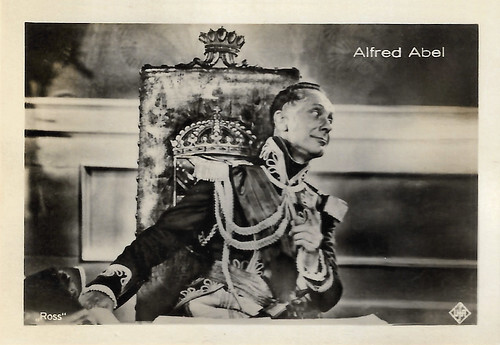
German cigarette card by Ross Verlag for Hänsom cigarettes by Jasmatzi Cigarettenfabrik G.M.b.H, Dresden/Ross Verlag, Film Series 4 'Aus tönenden Filmen' (From sound films), no. 614. Photo: Ufa. Alfred Abel in 1914, die letzten Tage vor dem Weltbrand/1914: The Last Days Before the War (Richard Oswald, 1931).
Alfred Abel (1879-1937) played in over 140 silent and sound films between 1913 and 1938. He is best known as the industrial Fredersen in Fritz Lang's Metropolis (1927).
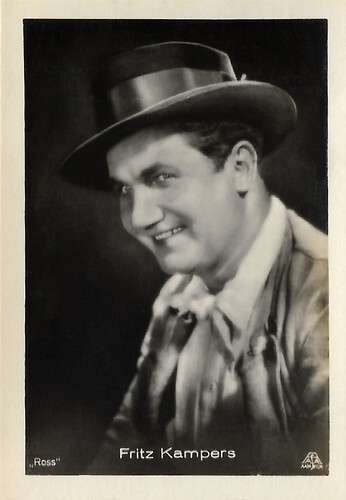
German cigarette card by Ross Verlag for Hänsom cigarettes by Jasmatzi Cigarettenfabrik G.M.b.H, Dresden, Film Series 4 'Aus tönenden Filmen' (From sound films), no. 627. Photo: Aafa-Film.
German actor and director Fritz Kampers (1891-1950) was a solidly built Bavarian character actor. In films from 1913, he was much in demand during the 1920s and 1930s. Kampers was often cast as robust or comic military types, or laconic, but good-hearted rustics in mountaineering or 'Heimat' films. He appeared in more than 260 films.
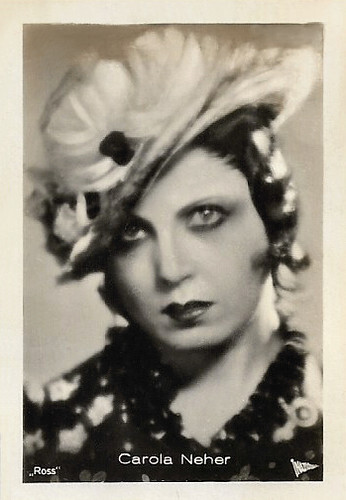
German cigarette card byRoss Verlag for Hänsom cigarettes by Jasmatzi Cigarettenfabrik G.M.b.H, Dresden, Film Series 4 'Aus tönenden Filmen' (From sound films), no. 633. Photo: National. Carola Neher in Die 3 Groschen-Oper/The Threepenny Opera (G.W. Pabst, 1931).
Carola Neher (1900-1942) was a talented and popular German stage actress and singer. She is now best known for her role as Polly Peachum in the film Die 3 Groschen-Oper/The Threepenny Opera (G.W. Pabst, 1931). After fleeing from the Nazis, she was falsely accused and convicted in the USSR of having engaged in anti-Soviet activities. In 1942, she died of typhoid in a prison.
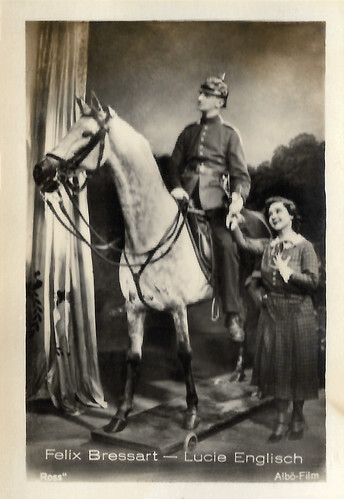
German cigarette card by Ross Verlag for Hänsom cigarettes by Jasmatzi Cigarettenfabrik G.M.b.H, Dresden, Film Series 4 'Aus tönenden Filmen' (From sound films), no. 534. Photo: Albö-Film. Felix Bressart and Lucie Englisch in Der Schrecken der Garnison/Terror of the Garrison (Carl Boese, 1931).
German stage and screen actor Felix Bressart (1892–1949) had to flee Germany after the Nazis seized power. He continued his film career in Austria and later in the US, where he became a popular character actor for MGM.
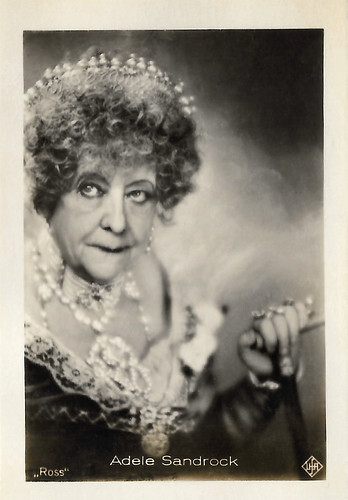
German cigarette card by Ross Verlag for Hänsom cigarettes by Jasmatzi Cigarettenfabrik G.M.b.H, Dresden, Film Series 4 'Aus tönenden Filmen' (From sound films), no. 635. Photo: Ufa. Adele Sandrock in Der Kongreß tanzt/The Congress Dances (Eric Charell, 1931).
Grand German-Dutch actress Adele Sandrock (1863-1937) had a successful theatrical career all over Europe. In Vienna, she had a stormy affair with the famous playwright Arthur Schnitzler and enjoyed triumphs as the diva of the modern playwrights. In the 1910s she became one of the first German film stars. After the introduction of sound, she emerged as a witty comedienne. She excelled as the intimidating elderly dragon, who could also be surprisingly funny and tactful.
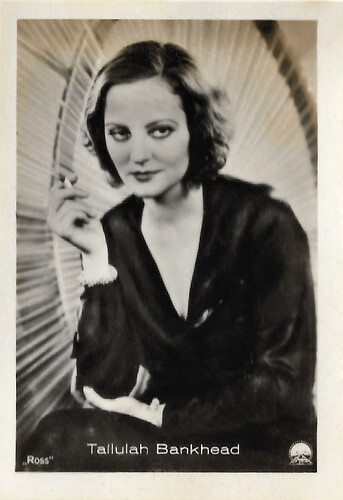
German cigarette card by Ross Verlag for Hänsom cigarettes by Jasmatzi Cigarettenfabrik G.M.b.H, Dresden, Film Series 4 'Aus tönenden Filmen' (From sound films), no. 648. Photo: Paramount.
American actress Tallulah Bankhead (1902-1968) was the most popular star of London's famed West End in the 1920s. After starring in several well-received plays, she gained the attention of Paramount Pictures executives and returned to the United States to try her hand at the film world. Tallulah's personality did not shine on film as Paramount executives had hoped. She appeared in such films as Devil and the Deep (1932) with Gary Cooper, Charles Laughton and newcomer Cary Grant, and Lifeboat (1944). While she made most of her fame on the stages of the world, the film industry and its history became richer because of her talent and her very colourful personality. Today her phrase, "Hello, Dahling" is known throughout the entertainment world.
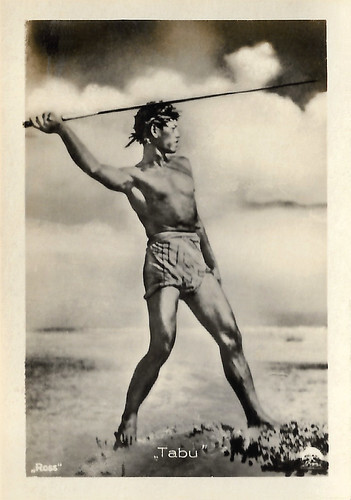
German cigarette card By Ross Verlag for Hänsom cigarettes by Jasmatzi Cigarettenfabrik G.M.b.H, Dresden, Film Series 4 'Aus tönenden Filmen' (From sound films), no. 649. Photo: Paramount. Matahi in Tabu/Tabu: A Story of the South Seas (Friedrich Wilhelm Murnau, 1931).
Friedrich Wilhelm Murnau (1888-1931) was a German film director who became world-famous as a maker of silent, expressionist films. Murnau's most famous films are Nosferatu, eine Symphonie des Grauens (1922), Der letzte Mann (1924), Faust (1926) and Sunrise: A Song of Two Humans (1927). He invented many revolutionary techniques that have since been very often imitated by others. His final film was Tabu/Tabu: A Story of the South Seas (1931).
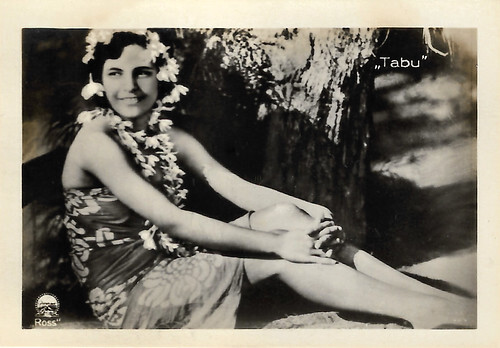
German cigarette card by Ross Verlag for Hänsom cigarettes by Jasmatzi Cigarettenfabrik G.M.b.H, Dresden, Film Series 4 'Aus tönenden Filmen' (From sound films), no. 650. Photo: Paramount. Reri in Tabu/Tabu: A Story of the South Seas (Friedrich Wilhelm Murnau, 1931).
Reri was born Anna Chevalier in 1912 in Bora-Bora, Tahiti. She was discovered by director Friedrich Wilhelm Murnau , who gave her the lead in his final film Tabu: A Story of the South Seas (1931). It is the tale of two young lovers on Bora Bora, the idyllic island in the South Pacific. Later she also appeared in the Polish film Czarna perla/Black Pearl (Michal Waszynski, 1934) and The Hurricane (John Ford, 1937). She died in 1977.
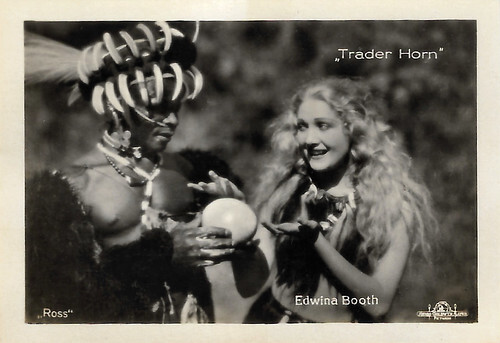
German cigarette card by Ross Verlag for Hänsom cigarettes by Jasmatzi Cigarettenfabrik G.M.b.H, Dresden, Film Series 4 'Aus tönenden Filmen' (From sound films), no. 653. Photo: MGM. Edwina Booth in Trader Horn (W.S. Van Dyke, 1931).
Trader Horn (1931) made Edwina Booth famous. Unfortunately, it also marked the beginning of a nightmare for the young actress, whose health was seriously impaired because of tropical ailments she contracted while filming the movie in Africa. Her once-promising career was over by 1933 and she soon disappeared from view in the second half of the 1930s.
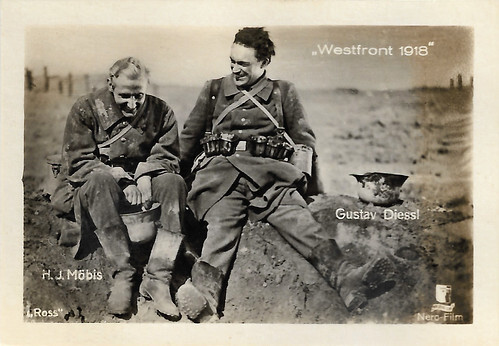
German cigarette card by Ross Verlag for Hänsom cigarettes by Jasmatzi Cigarettenfabrik G.M.b.H, Dresden, Film Series 4 'Aus tönenden Filmen' (From sound films), no. 663. Photo: Nero-Film. H.J. Möbis and Gustav Diessl in Westfront 1918 (G.W. Pabst, 1930).
Austrian film and stage actor Gustav Diessl (1899-1948) was the hero of the first Mountain film, Die weiße Hölle vom Piz Palü/The White Hell of Piz Palu (1929). This film and others by prolific director G.W. Pabst made him at the time an unusual sex symbol: the mature, quiet, somewhat difficult man who attracts women almost against his will. Under the Nazi regime, he was often cast as an exotic villain or a mysterious foreigner.
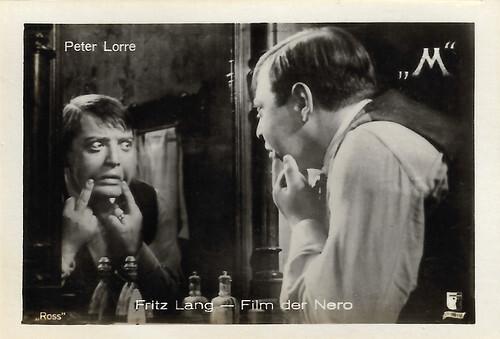
German cigarette card by Ross Verlag for Hänsom cigarettes by Jasmatzi Cigarettenfabrik G.M.b.H, Dresden, Film Series 4 'Aus tönenden Filmen' (From sound films), no. 664. Photo: Nero-Film. Peter Lorre in M – Eine Stadt sucht einen Mörder/M (Fritz Lang, 1931).
Peter Lorre (1904–1964) with his trademark large, popped eyes, his toothy grin and his raspy voice was an American actor of Jewish Austro-Hungarian descent. He was an international sensation as the psychopathic child murderer in Fritz Lang’s M – Eine Stadt sucht einen Mörder/M (1931).
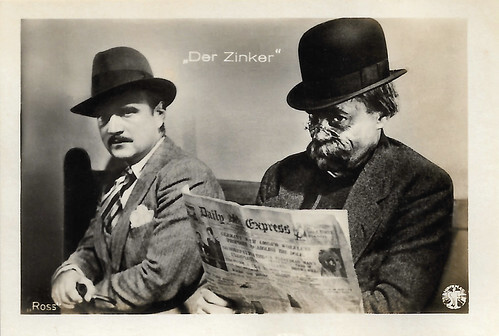
German cigarette card By Ross Verlag for Hänsom cigarettes by Jasmatzi Cigarettenfabrik G.M.b.H, Dresden, Film Series 4 'Aus tönenden Filmen' (From sound films), no. 666. Photo: Süd-Film (SF). Karl Ludwig Diehl in Der Zinker/The Informer (Karl Forest, Martin Fric, Karel Lamac, 1931).
German film actor Karl Ludwig Diehl (1896-1958) appeared in 66 films between 1924 and 1957. Although he is forgotten now, he was one of the most prominent German film actors of the 1930s and 1940s.
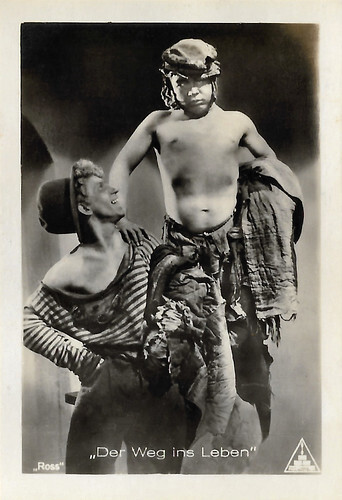
German cigarette card by Ross Verlag for Hänsom cigarettes by Jasmatzi Cigarettenfabrik G.M.b.H, Dresden, Film Series 4 'Aus tönenden Filmen' (From sound films), no. 668. Photo: Prometheus-Film. Scene from Putyovka v zhizn/Road to Life (Nikolai Ekk, 1931).
Putyovka v zhizn/Road to Life (Nikolai Ekk, 1931) was one of the first Soviet sound films—with an imaginative soundtrack far ahead of its time. This landmark film stars Mikhail Zharov, Nikolai Batalov, and Yvan Kyrlya. Stage actor Vasili Kachalov is the narrator. The film was a smash hit both in Russia and in the West, where its impact generated some dozen spin-offs on its theme of 'difficult' children.
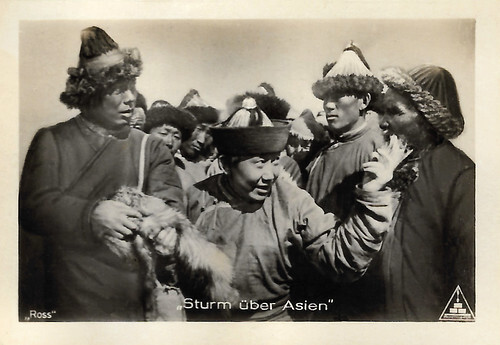
German cigarette card for Hänsom cigarettes by Jasmatzi Cigarettenfabrik G.M.b.H, Dresden/Ross Verlag, Film Series 4 'Aus tönenden Filmen' (From sound films), no. 669. Photo: Prometheus-Film. Scene from Potomok Chingis-Khana/Storm over Asia (Vsevolod Pudovkin, 1928).
Potomok Chingis-Khana/Потомок Чингисхана/Storm over Asia (Vsevolod Pudovkin, 1928) is a Soviet propaganda film written by Osip Brik and Ivan Novokshonov, and starring Valéry Inkijinoff. It is the final film in Pudovkin's 'revolutionary trilogy', alongside Mat/Mother (1926) and Konets Sankt-Peterburga/The End of St. Petersburg (1927).
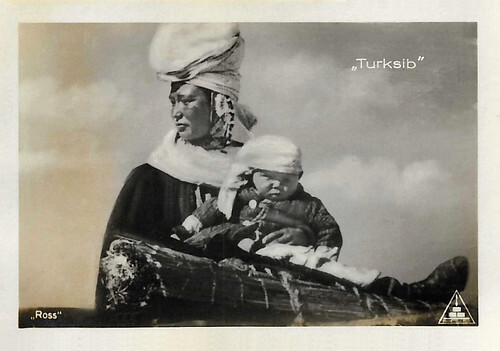
German cigarette card by Ross Verlag for Hänsom cigarettes by Jasmatzi Cigarettenfabrik G.M.b.H, Dresden, Film Series 4 'Aus tönenden Filmen' (From sound films), no. 670. Photo: Photo: Prometheus-Film. A scene from Turksib (Victor A. Turin, 1929).
The Soviet documentary film Turksib (Victor A. Turin, 1929) documents the building of the Turkestan–Siberia Railway, which connected Central Asia and Siberia. The creation of this monumental construction project was an important moment in Soviet history. The rail line stretched northeast from Tashkent to Almaty and on to Novosibirsk.
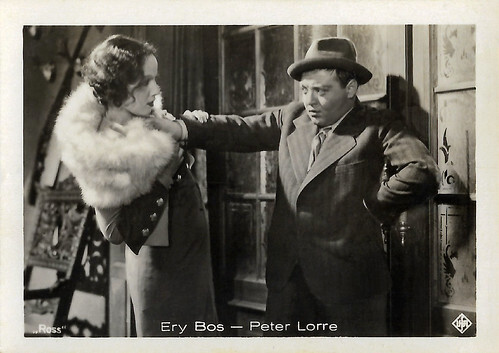
German collectors card by Ross Verlag in the series 'Hänsom Filmbilder for Jasmatzi Cigarettenfabrik G.m.b.H., Dresden, Serie V, Bild no. 84 (1-147). Photo: Ufa. Ery Bos and Peter Lorre in Schuss im Morgengrauen/A Shot at Dawn (Alfred Zeisler, 1932).
Dutch-German actress Ery Bos (1910-2005) had a short but productive film career in the early German sound film. From 1932 to 1934, she took part in a dozen films in only three years. Peter Lorre (1904–1964) with his trademark large, popped eyes, his toothy grin and his raspy voice was an American actor of Jewish Austro-Hungarian descent. He was an international sensation as the psychopathic child murderer in Fritz Lang’s M – Eine Stadt sucht einen Mörder/M (1931). He later became a popular actor in two British Hitchcock films and a series of Hollywood crime films and mysteries. Although he was frequently typecast as a sinister foreigner in the US, he also became the star of the successful Mr. Moto detective series.
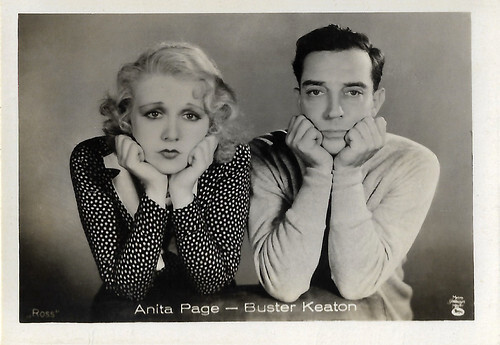
German cigarette card by Ross Verlag in the series 'Hänsom Filmbilder' for Jaszmatzi Cigarettenfabrik G.M.B.H., Dresden, Series V, no. 113 (of 147). Photo: Metro-Goldwyn-Mayer. Anita Page and Buster Keaton in Free and Easy (Edward Sedgwick, 1930).
Beautiful Anita Page (1910–2008) was one of Hollywood's most popular leading ladies during the last years of the silent screen and the first years of the sound era. According to MGM, she received the most fan mail then and her nickname was "the girl with the most beautiful face in Hollywood". Stone-faced Buster Keaton (1895-1966) was one of the three greatest comedians of Silent Hollywood.

Small German card by Ross Verlag for Hänsom Cigaretten by Jasmatzi Cigaretten-Fabrik G.m.b.H., Dresden, Tonfilmseries 3, no. 358. Photo: Eugene Robert Richee / Paramount. Marlene Dietrich in Morocco (Josef von Sternberg, 1930).
Marlene Dietrich (1901-1992) was the first German actress who became successful in Hollywood. Throughout her long career, she constantly reinvented herself. In 1920s Berlin, she started as a cabaret singer, chorus girl, and film actress. In the 1930s, she became a Hollywood star, then a World War II frontline entertainer, and finally, she was an international stage show performer from the 1950s till the 1970s. Now we remember her as one of the icons of the 20th century.

German cigarette card by Ross Verlag for Hänsom cigarettes by Jasmatzi Cigarettenfabrik G.M.b.H, Dresden, Film Series 4 'Aus tönenden Filmen' (From sound films), no. 505. Photo: Ufa.
Austrian-American film director Josef von Sternberg (1894-1969) is known as a great stylist, as the director of the prototypical Hollywood gangster film, Underworld (1927), and especially as the discoverer of Marlene Dietrich. He worked with her for the first time at the Ufa in Der blaue Engel/The Blue Angel (1930) and would subsequently make six more films with her in Hollywood. He was nominated for the Academy Award for Best Director for Morocco (1930) and Shanghai Express (1932). Along with Erich von Stroheim, Friedrich Wilhelm Murnau, Fritz Lang, Ernst Lubitsch and Billy Wilder, Von Sternberg belonged to the large group of German and Austrian film emigrants who helped to shape Hollywood cinema.

German cigarette card by Ross Verlag for Hänsom cigarettes by Jasmatzi Cigarettenfabrik G.M.b.H, Dresden, Film Series 4 'Aus tönenden Filmen' (From sound films), no. 506. Photo: Paramount.
Ernst Lubitsch (1892-1947) was a German-American actor, screenwriter, producer and film director. His urbane comedies of manners gave him the reputation of being Hollywood's most elegant and sophisticated director; as his prestige grew, his films were promoted as having ‘the Lubitsch touch.’ He was nominated three times for the Oscar for Best Director and in 1947, he received an Honorary Academy Award.

German cigarette card by Ross Verlag for Hänsom cigarettes by Jasmatzi Cigarettenfabrik G.M.b.H, Dresden, Film Series 4 'Aus tönenden Filmen' (From sound films), no. 508. Photo: Froelich-Film.
Carl Froelich (1875-1953) was a German film pioneer and film director, who made many silent films with Henny Porten and produced such classics as Die Brüder Karamasoff/The Brothers Karamazov (1922), the first German sound film, Die Nacht gehört uns/The Night Belongs To Us (1929) and the groundbreaking Mädchen in Uniform/Girls in Uniform (1931). In 1933, Froelich became a member of the National Socialist Party and later became President of the Reichsfilmkammer. After the end of the war, Froelich was arrested and in 1948 he was de-Nazified. Between 1912 and 1951 he made 77 films.

German cigarette card by Ross Verlag for Hänsom cigarettes by Jasmatzi Cigarettenfabrik G.M.b.H, Dresden, Film Series 4 'Aus tönenden Filmen' (From sound films), no. 509. Photo: Nero-Film.
Fritz Lang (1890-1976) was an Austrian-German-American filmmaker, screenwriter, and occasional film producer and actor. One of the best-known émigrés from Germany's school of Expressionism, he was dubbed the 'Master of Darkness' by the British Film Institute. Lang's most famous films include the groundbreaking futuristic Metropolis (1927) and the influential M (1931), a Film Noir precursor that he made before he moved to the United States. His other notable films include Dr. Mabuse, der Spieler/Dr. Mabuse the Gambler (1922), Die Nibelungen (1924), Fury (1936), You Only Live Once (1937), Hangmen Also Die! (1943), The Woman in the Window (1944), and The Big Heat (1953).

German cigarette card by Ross Verlag for Hänsom cigarettes by Jasmatzi Cigarettenfabrik G.M.b.H, Dresden, Film Series 4 'Aus tönenden Filmen' (From sound films), no. 510. Photo: Nero Film.
Austrian film director Georg Wilhelm Pabst (1885-1967) was together with Fritz Lang, Friedrich Wilhelm Murnau and Ernst Lubitsch one of the great film directors of the Weimar Republic of Germany. He worked in Germany, France, Italy and the US. Some of his best-known films deal with the situation of women in the Weimar Republic. His best-known films include Die freudlose Gasse (1925), Die Büchse der Pandora (1929), Die Dreigroschenoper (1931) and Kameradschaft (1931). During World War II, he made the films Komödianten (1941) and Paracelsus (1943) in Nazi Germany.

German cigarette card by Ross Verlag for Hänsom cigarettes by Jasmatzi Cigarettenfabrik G.M.b.H, Dresden, Film Series 4 'Aus tönenden Filmen' (From sound films), no. 519. Photo: Ufa. Oskar Homolka and Willy Fritsch in Im Geheimdienst/In the Employ of the Secret Service (Gustav Ucicky, 1931).
Austrian film and theatre actor Oskar Homolka (1898–1978) had a stocky appearance, bushy eyebrows and a rather Slavic-sounding name, which led many to believe he was Eastern European or Russian. His expressive face predestined him to play character roles as a scoundrel, pimp or communist spy. From the mid-1920s on, charming Willy Fritsch (1901-1973) replaced Bruno Kastner and Harry Liedtke as the darling of female cinemagoers in Germany. Fritsch became the immensely popular ‘Sunny Boy’ of the Ufa operettas of the 1930s and 1940s, and with his frequent co-star Lilian Harvey he formed the 'dream team of the German cinema'.

German cigarette card by Ross Verlag for Hänsom cigarettes by Jasmatzi Cigarettenfabrik G.M.b.H, Dresden, Film Series 4 'Aus tönenden Filmen' (From sound films), no. 533. Photo: National. Rudolf Forster in Die Dreigroschenoper/The Threepenny Opera (G.W. Pabst, 1931).
Austrian film actor Rudolf Forster (1884-1968) appeared in more than 100 films between 1914 and 1968. He was known for Zur Chronik von Grieshuus/Chronicles of the Gray House (1925), Die 3 Groschen-Oper/The Threepenny Opera (1931) and Das Glas Wasser/A Glass of Water (1960).

German cigarette card by Ross Verlag for Hänsom cigarettes by Jasmatzi Cigarettenfabrik G.M.b.H, Dresden, Film Series 4 'Aus tönenden Filmen' (From sound films), no. 536. Photo: Aafa-Film. Otto Wallburg in Lügen auf Rügen/The Isle of Lies (Victor Janson, 1932).
Otto Wallburg (1889-1944) was a popular actor of the Weimar cinema, who appeared in supporting roles as the overweight comedian. After the rise of the Nazis, the Jewish actor had to go into exile, first in Austria and later in the Netherlands. The Nazis murdered him in the Auschwitz concentration camp.

German cigarette card by Ross Verlag for Hänsom cigarettes by Jasmatzi Cigarettenfabrik G.M.b.H, Dresden, Film Series 4 'Aus tönenden Filmen' (From sound films), no. 572. Photo: Ufa. Max Adalbert in Das Ekel/The Scoundrel (Eugen Schüfftan, Franz Wenzler, 1931).
German stage and film actor Max Adalbert (1874-1933) was one of the great names of the German theatre at the beginning of the twentieth century. He was famous for his roles in comedies. His greatest success was the title role in the comedy Der Hauptmann von Köpenick/The Captain from Köpenick (1931) which he played on stage and in the cinema.

German cigarette card by Ross Verlag for Hänsom cigarettes by Jasmatzi Cigarettenfabrik G.M.b.H, Dresden, Film Series 4 'Aus tönenden Filmen' (From sound films), no. 573. Photo: Mondial Film.
German stage and film actor Hermann Picha (1865-1936) was very prolific in German cinema during the silent and early sound eras, appearing in over 300 short and feature films. Picha played a mixture of lead and supporting roles during his career. He played the title role in Schneider Wibbel/Wibbel the Tailor (Manfred Noa, 1920) and appeared in a supporting role in Fritz Lang's Expressionist fantasy classic Der müde Tod/Destiny (1921), inspired by the Indian folktale of Savitri.

German cigarette card by Ross Verlag for Hänsom cigarettes by Jasmatzi Cigarettenfabrik G.M.b.H, Dresden, Film Series 4 'Aus tönenden Filmen' (From sound films), no. 576. Photo: Ufa. Paul Grätz in Das verlorene Paradies/The Lost Paradise (Philipp Lothar Mayring, 1931).
German stage actor Paul Graetz (1889-1937) often worked with stage director Max Reinhardt. He was a star in Berlin's cabaret. In films, Graetz played mostly comic and grotesque characters. The Jewish Graetz went into exile in 1933 and worked in London and Hollywood.

German cigarette card by Ross Verlag for Hänsom cigarettes by Jasmatzi Cigarettenfabrik G.M.b.H, Dresden, Film Series 4 'Aus tönenden Filmen' (From sound films), no. 601. Photo: Ufa. Paul Heidemann and Fritz Schulz in Dienst ist Dienst/Duty is Duty (Carl Boese 1931).
Paul Heidemann (1884-1968) was a German stage and screen actor, film director and film producer. He was famous for his comical parts. Austrian-born comic actor/director Fritz Schulz (1896-1972) appeared in more than one hundred films between 1917 and 1970. When the sound film arrived, he was one of the most popular stars of the Ufa. The rise of the Nazis broke his blooming career.

German cigarette card by Ross Verlag for Hänsom cigarettes by Jasmatzi Cigarettenfabrik G.M.b.H, Dresden/Ross Verlag, Film Series 4 'Aus tönenden Filmen' (From sound films), no. 614. Photo: Ufa. Alfred Abel in 1914, die letzten Tage vor dem Weltbrand/1914: The Last Days Before the War (Richard Oswald, 1931).
Alfred Abel (1879-1937) played in over 140 silent and sound films between 1913 and 1938. He is best known as the industrial Fredersen in Fritz Lang's Metropolis (1927).

German cigarette card by Ross Verlag for Hänsom cigarettes by Jasmatzi Cigarettenfabrik G.M.b.H, Dresden, Film Series 4 'Aus tönenden Filmen' (From sound films), no. 627. Photo: Aafa-Film.
German actor and director Fritz Kampers (1891-1950) was a solidly built Bavarian character actor. In films from 1913, he was much in demand during the 1920s and 1930s. Kampers was often cast as robust or comic military types, or laconic, but good-hearted rustics in mountaineering or 'Heimat' films. He appeared in more than 260 films.

German cigarette card byRoss Verlag for Hänsom cigarettes by Jasmatzi Cigarettenfabrik G.M.b.H, Dresden, Film Series 4 'Aus tönenden Filmen' (From sound films), no. 633. Photo: National. Carola Neher in Die 3 Groschen-Oper/The Threepenny Opera (G.W. Pabst, 1931).
Carola Neher (1900-1942) was a talented and popular German stage actress and singer. She is now best known for her role as Polly Peachum in the film Die 3 Groschen-Oper/The Threepenny Opera (G.W. Pabst, 1931). After fleeing from the Nazis, she was falsely accused and convicted in the USSR of having engaged in anti-Soviet activities. In 1942, she died of typhoid in a prison.

German cigarette card by Ross Verlag for Hänsom cigarettes by Jasmatzi Cigarettenfabrik G.M.b.H, Dresden, Film Series 4 'Aus tönenden Filmen' (From sound films), no. 534. Photo: Albö-Film. Felix Bressart and Lucie Englisch in Der Schrecken der Garnison/Terror of the Garrison (Carl Boese, 1931).
German stage and screen actor Felix Bressart (1892–1949) had to flee Germany after the Nazis seized power. He continued his film career in Austria and later in the US, where he became a popular character actor for MGM.

German cigarette card by Ross Verlag for Hänsom cigarettes by Jasmatzi Cigarettenfabrik G.M.b.H, Dresden, Film Series 4 'Aus tönenden Filmen' (From sound films), no. 635. Photo: Ufa. Adele Sandrock in Der Kongreß tanzt/The Congress Dances (Eric Charell, 1931).
Grand German-Dutch actress Adele Sandrock (1863-1937) had a successful theatrical career all over Europe. In Vienna, she had a stormy affair with the famous playwright Arthur Schnitzler and enjoyed triumphs as the diva of the modern playwrights. In the 1910s she became one of the first German film stars. After the introduction of sound, she emerged as a witty comedienne. She excelled as the intimidating elderly dragon, who could also be surprisingly funny and tactful.

German cigarette card by Ross Verlag for Hänsom cigarettes by Jasmatzi Cigarettenfabrik G.M.b.H, Dresden, Film Series 4 'Aus tönenden Filmen' (From sound films), no. 648. Photo: Paramount.
American actress Tallulah Bankhead (1902-1968) was the most popular star of London's famed West End in the 1920s. After starring in several well-received plays, she gained the attention of Paramount Pictures executives and returned to the United States to try her hand at the film world. Tallulah's personality did not shine on film as Paramount executives had hoped. She appeared in such films as Devil and the Deep (1932) with Gary Cooper, Charles Laughton and newcomer Cary Grant, and Lifeboat (1944). While she made most of her fame on the stages of the world, the film industry and its history became richer because of her talent and her very colourful personality. Today her phrase, "Hello, Dahling" is known throughout the entertainment world.

German cigarette card By Ross Verlag for Hänsom cigarettes by Jasmatzi Cigarettenfabrik G.M.b.H, Dresden, Film Series 4 'Aus tönenden Filmen' (From sound films), no. 649. Photo: Paramount. Matahi in Tabu/Tabu: A Story of the South Seas (Friedrich Wilhelm Murnau, 1931).
Friedrich Wilhelm Murnau (1888-1931) was a German film director who became world-famous as a maker of silent, expressionist films. Murnau's most famous films are Nosferatu, eine Symphonie des Grauens (1922), Der letzte Mann (1924), Faust (1926) and Sunrise: A Song of Two Humans (1927). He invented many revolutionary techniques that have since been very often imitated by others. His final film was Tabu/Tabu: A Story of the South Seas (1931).

German cigarette card by Ross Verlag for Hänsom cigarettes by Jasmatzi Cigarettenfabrik G.M.b.H, Dresden, Film Series 4 'Aus tönenden Filmen' (From sound films), no. 650. Photo: Paramount. Reri in Tabu/Tabu: A Story of the South Seas (Friedrich Wilhelm Murnau, 1931).
Reri was born Anna Chevalier in 1912 in Bora-Bora, Tahiti. She was discovered by director Friedrich Wilhelm Murnau , who gave her the lead in his final film Tabu: A Story of the South Seas (1931). It is the tale of two young lovers on Bora Bora, the idyllic island in the South Pacific. Later she also appeared in the Polish film Czarna perla/Black Pearl (Michal Waszynski, 1934) and The Hurricane (John Ford, 1937). She died in 1977.

German cigarette card by Ross Verlag for Hänsom cigarettes by Jasmatzi Cigarettenfabrik G.M.b.H, Dresden, Film Series 4 'Aus tönenden Filmen' (From sound films), no. 653. Photo: MGM. Edwina Booth in Trader Horn (W.S. Van Dyke, 1931).
Trader Horn (1931) made Edwina Booth famous. Unfortunately, it also marked the beginning of a nightmare for the young actress, whose health was seriously impaired because of tropical ailments she contracted while filming the movie in Africa. Her once-promising career was over by 1933 and she soon disappeared from view in the second half of the 1930s.

German cigarette card by Ross Verlag for Hänsom cigarettes by Jasmatzi Cigarettenfabrik G.M.b.H, Dresden, Film Series 4 'Aus tönenden Filmen' (From sound films), no. 663. Photo: Nero-Film. H.J. Möbis and Gustav Diessl in Westfront 1918 (G.W. Pabst, 1930).
Austrian film and stage actor Gustav Diessl (1899-1948) was the hero of the first Mountain film, Die weiße Hölle vom Piz Palü/The White Hell of Piz Palu (1929). This film and others by prolific director G.W. Pabst made him at the time an unusual sex symbol: the mature, quiet, somewhat difficult man who attracts women almost against his will. Under the Nazi regime, he was often cast as an exotic villain or a mysterious foreigner.

German cigarette card by Ross Verlag for Hänsom cigarettes by Jasmatzi Cigarettenfabrik G.M.b.H, Dresden, Film Series 4 'Aus tönenden Filmen' (From sound films), no. 664. Photo: Nero-Film. Peter Lorre in M – Eine Stadt sucht einen Mörder/M (Fritz Lang, 1931).
Peter Lorre (1904–1964) with his trademark large, popped eyes, his toothy grin and his raspy voice was an American actor of Jewish Austro-Hungarian descent. He was an international sensation as the psychopathic child murderer in Fritz Lang’s M – Eine Stadt sucht einen Mörder/M (1931).

German cigarette card By Ross Verlag for Hänsom cigarettes by Jasmatzi Cigarettenfabrik G.M.b.H, Dresden, Film Series 4 'Aus tönenden Filmen' (From sound films), no. 666. Photo: Süd-Film (SF). Karl Ludwig Diehl in Der Zinker/The Informer (Karl Forest, Martin Fric, Karel Lamac, 1931).
German film actor Karl Ludwig Diehl (1896-1958) appeared in 66 films between 1924 and 1957. Although he is forgotten now, he was one of the most prominent German film actors of the 1930s and 1940s.

German cigarette card by Ross Verlag for Hänsom cigarettes by Jasmatzi Cigarettenfabrik G.M.b.H, Dresden, Film Series 4 'Aus tönenden Filmen' (From sound films), no. 668. Photo: Prometheus-Film. Scene from Putyovka v zhizn/Road to Life (Nikolai Ekk, 1931).
Putyovka v zhizn/Road to Life (Nikolai Ekk, 1931) was one of the first Soviet sound films—with an imaginative soundtrack far ahead of its time. This landmark film stars Mikhail Zharov, Nikolai Batalov, and Yvan Kyrlya. Stage actor Vasili Kachalov is the narrator. The film was a smash hit both in Russia and in the West, where its impact generated some dozen spin-offs on its theme of 'difficult' children.

German cigarette card for Hänsom cigarettes by Jasmatzi Cigarettenfabrik G.M.b.H, Dresden/Ross Verlag, Film Series 4 'Aus tönenden Filmen' (From sound films), no. 669. Photo: Prometheus-Film. Scene from Potomok Chingis-Khana/Storm over Asia (Vsevolod Pudovkin, 1928).
Potomok Chingis-Khana/Потомок Чингисхана/Storm over Asia (Vsevolod Pudovkin, 1928) is a Soviet propaganda film written by Osip Brik and Ivan Novokshonov, and starring Valéry Inkijinoff. It is the final film in Pudovkin's 'revolutionary trilogy', alongside Mat/Mother (1926) and Konets Sankt-Peterburga/The End of St. Petersburg (1927).

German cigarette card by Ross Verlag for Hänsom cigarettes by Jasmatzi Cigarettenfabrik G.M.b.H, Dresden, Film Series 4 'Aus tönenden Filmen' (From sound films), no. 670. Photo: Photo: Prometheus-Film. A scene from Turksib (Victor A. Turin, 1929).
The Soviet documentary film Turksib (Victor A. Turin, 1929) documents the building of the Turkestan–Siberia Railway, which connected Central Asia and Siberia. The creation of this monumental construction project was an important moment in Soviet history. The rail line stretched northeast from Tashkent to Almaty and on to Novosibirsk.

German collectors card by Ross Verlag in the series 'Hänsom Filmbilder for Jasmatzi Cigarettenfabrik G.m.b.H., Dresden, Serie V, Bild no. 84 (1-147). Photo: Ufa. Ery Bos and Peter Lorre in Schuss im Morgengrauen/A Shot at Dawn (Alfred Zeisler, 1932).
Dutch-German actress Ery Bos (1910-2005) had a short but productive film career in the early German sound film. From 1932 to 1934, she took part in a dozen films in only three years. Peter Lorre (1904–1964) with his trademark large, popped eyes, his toothy grin and his raspy voice was an American actor of Jewish Austro-Hungarian descent. He was an international sensation as the psychopathic child murderer in Fritz Lang’s M – Eine Stadt sucht einen Mörder/M (1931). He later became a popular actor in two British Hitchcock films and a series of Hollywood crime films and mysteries. Although he was frequently typecast as a sinister foreigner in the US, he also became the star of the successful Mr. Moto detective series.

German cigarette card by Ross Verlag in the series 'Hänsom Filmbilder' for Jaszmatzi Cigarettenfabrik G.M.B.H., Dresden, Series V, no. 113 (of 147). Photo: Metro-Goldwyn-Mayer. Anita Page and Buster Keaton in Free and Easy (Edward Sedgwick, 1930).
Beautiful Anita Page (1910–2008) was one of Hollywood's most popular leading ladies during the last years of the silent screen and the first years of the sound era. According to MGM, she received the most fan mail then and her nickname was "the girl with the most beautiful face in Hollywood". Stone-faced Buster Keaton (1895-1966) was one of the three greatest comedians of Silent Hollywood.
Published on January 01, 2025 22:00
December 31, 2024
Stars who passed away in 2024
On the first day of 2025, EFSP remembers the stars of the international cinema we had to say farewell to in 2024. Thank you, for your films and postcards. We salute you!
4 January 2024: Glynis Johns

Spanish postcard by Archivo Bermejo, no. C 293.
Husky voiced Welsh-born stage and film actress, dancer, pianist and singer Glynis Johns (1923-2024) was best known for her film roles as a mermaid in the British comedy Miranda (1948) and as suffragette mother Winifred Banks in Walt Disney's Mary Poppins (1964). On Broadway, she created the role of Desiree Armfeldt in 'A Little Night Music', for which she won a Tony Award.
4 January 2024: David Soul
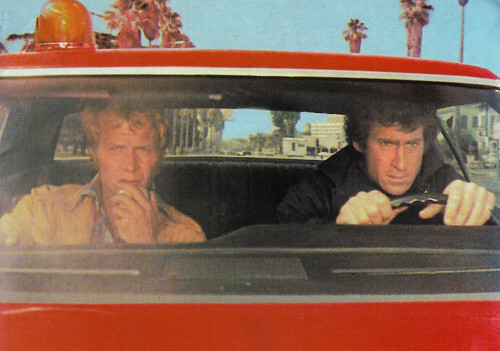
British postcard by Klasik Kards, London, sent by mail in 1988. Photo: Robert H. Cain Media Star Archive / ABC, Inc. David Soul (left) and Paul Michael Glaser in the TV Series Starsky and Hutch (1975-1979).
American-British actor and singer David Soul achieved pop icon status as handsome, blond-haired, blue-eyed Detective Kenneth Hutchinson on the cult 'buddy cop' TV series Starsky and Hutch (1975-1979). His other notable roles included Joshua Bolt on the TV series Here Come the Brides (1968-1970) and vampire hunter Ben Mears in the TV movie Salem's Lot (1979) opposite James Mason. Soul also had a very successful singing career recording several albums, with worldwide number-one hit singles including 'Silver Lady and 'Don't Give Up on Us Baby'.
14 January 2024: Elisabeth Trissenaar
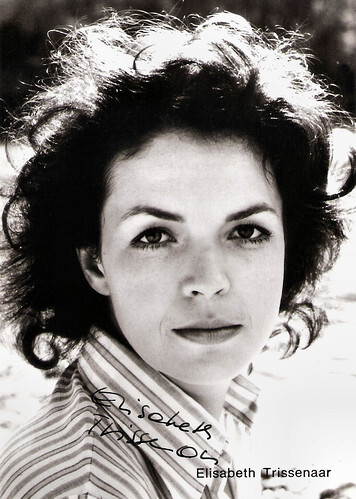
German postcard by Franz Josef Rüdel, Filmpostkartenverlag, Hamburg. Photo: Ingrid v. Paleske, München.
Austrian actress Elisabeth Trissenaar (1944-2024) was best known for her roles in Rainer Werner Fassbinder's film Die Ehe der Maria Braun (1979) and his 14-part miniseries Berlin Alexanderplatz (1980). She also appeared in the West German-Dutch film Charlotte (1981), Andrzej Wajda's drama Eine Liebe in Deutschland/A Love in Germany (1983) and the Oscar-nominated war drama Bittere Ernte/Angry Harvest (1985) with Armin Müller-Stahl.
29 January 2024: Sandra Milo
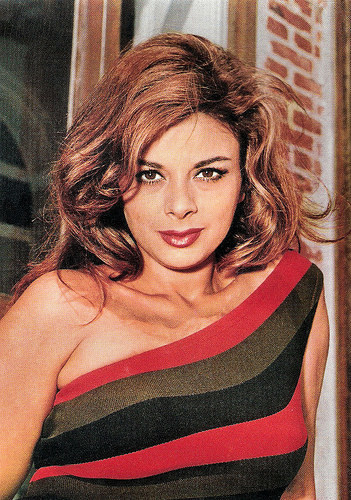
Italian postcard by Rotalfoto, no. 98.
Italian actress Sandra Milo (1933-2024) was best known for her roles in Federico Fellini's 8½ (1963) and Giulietta degli spiriti/Juliet of the Spirits (1965), but she also worked with the famous directors Antonio Pietrangeli and Roberto Rossellini. She won the Silver Ribbon Best Supporting Actress award for both 8½ and Juliet of the Spirits. Sandra Milo was 90.
2 February 2024: Don Murray
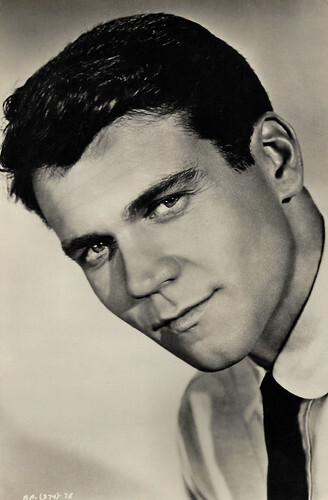
Spanish postcard by Archivo Bermejo, no. 7317. Photo: 20th Century Fox. Don Murray in A Hatful of Rain (Fred Zinnemann, 1957).
American actor Don Murray (1928-2024) was best known for his breakout performance in the film Bus Stop (1956), with Marilyn Monroe. His role earned him a nomination for the Academy Award for Best Supporting Actor. His other films include A Hatful of Rain (1957) and Conquest of the Planet of the Apes (1972). Murray was 94.
13 February 2024: Johanna von Koczian
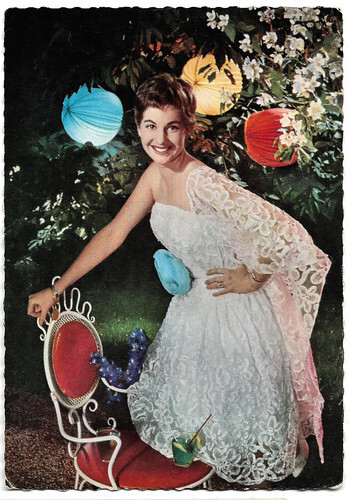
West German postcard by UFA, Berlin-Tempelhof, no. CK-323. Photo: Ringpress / Vogelmann.
During the late 1950s and early 1960s, German actress, singer and author Johanna von Koczian (1933-2024) was one of Germany’s most popular film stars. Later, she evolved into a stage actress, a popular Schlager singer, a TV presenter, and a successful author of novels and children's books. Johanna von Koczian was 90.
15 February 2024: Gérard Barray
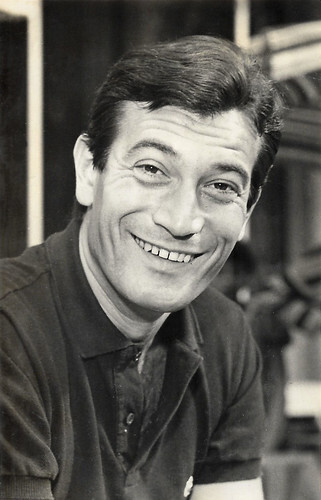
Czech collector card by Pressfoto, Praha (Prague), 1964, no. S 58/7.
French film and television actor Gérard Barray (1931-2024) was once called 'the most handsome man in the world' and became one of the swashbuckling heroes of French cinema. During the 1960s, he starred as D’Artagnan and Scaramouche but also starred in many Eurospy films. He married his Spanish co-star, flamenco dancer Teresa Lorca, and settled in Andalusia. Barray was 92.
21 February 2024: Micheline Presle
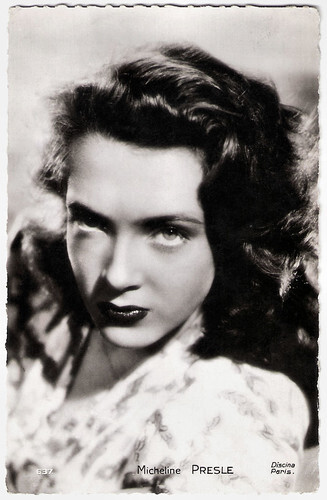
French postcard by Collection Chantal, Paris, no. 637. Photo: Discina, Paris.
French actress Micheline Presle (1922-2024) passed away at 101. In the 1940s and 1950s, she formed the queen trio of French cinema with Michèle Morgan and Danielle Darrieux. The chic and elegant star gained worldwide attention for Le diable au corps/Devil in the Flesh (Claude Autant-Lara, 1947). The success of this film also earned Presle three roles in a Hollywood production, under the name Micheline Prelle. Over nine decades, La Presle made more than one hundred and fifty films.
25 March 2024: Fritz Wepper
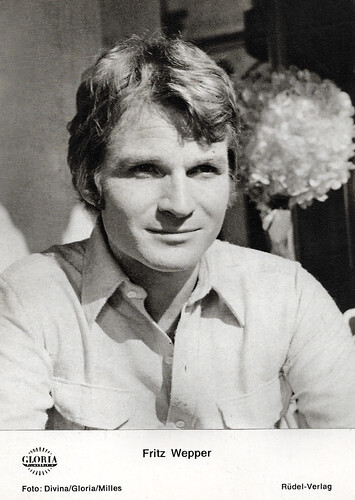
West German postcard by Rüdel-Verlag, Hamburg, no. 5177. Photo: Divina / Gloria / Milles. Fritz Wepper in Nachbarn sind zum Ärgern da/Neighbors are there to annoy you (Peter Weck, 1970).
German television and film actor Fritz Wepper (1941-2024) died at the age of 82. In 1972, he played an important supporting role in Bob Fosse's classic musical Cabaret. He became an international cult figure as inspector Harry Klein, first in the Krimi series Der Kommissar/The Commissioner (1969–1976) and later in another popular Krimi series Derrick (1974-1998). He also won several German TV awards, including one for his role in the series Um Himmels Willen/For Heaven's Sake (2002-2021).
31 March 2024: Barbara Rush
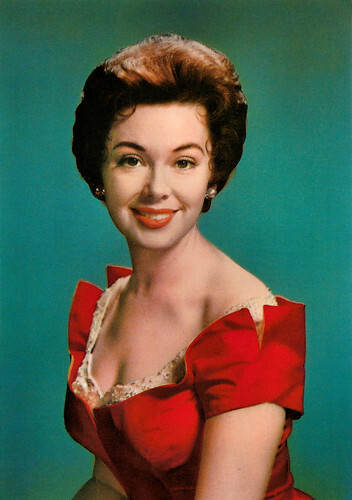
Italian postcard by Rotalfoto. Milano, no. N. 120.
American actress Barbara Rush (1927-2024) was the epitome of poise, charm, style, and grace in Hollywood films of the 1950s. In 1954, she won the Golden Globe Award as Most Promising Female Newcomer for the Science-Fiction film It Came from Outer Space (1953). She played the female lead in such films as The Young Philadelphians (1959), The Young Lions (1958), and Hombre (1967). Later in her career, Rush guest-starred on TV in such series as Peyton Place, All My Children and 7th Heaven.
30 March 2024: Gezá Tordy
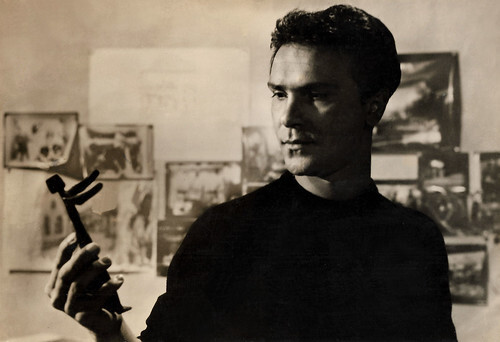
East German postcard by VEB Progress Film-Vertrieb, Berlin, no. 2691, 1966. Gezá Tordy in Ketten haltak meg/Two died (György Palásthy, 1966).
Hungarian actor and director Géza Tordy (1938-2024) passed away in Budapest at the age of 85. The distinguished artist was the winner of the Kossuth Prize winner and the Jászai Mari Prize.
3 April 2024: Vera Tschechowa
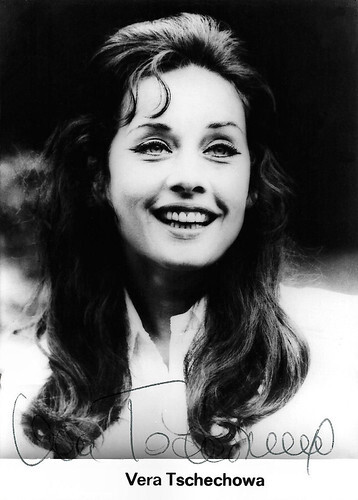
Vintage autograph card.
German film and television actress Vera Tschechowa (1940-2024) passed away in Berlin at 83. Her grandfather was the Russian Oscar-nominated actor Michael Chekhov who was the nephew of author Anton Chekhov. Her grandmother was legendary film star Olga Tschechowa. The elegant, green-eyed actress appeared in over 50 films since 1957.
24 April 2024: Margaret Lee
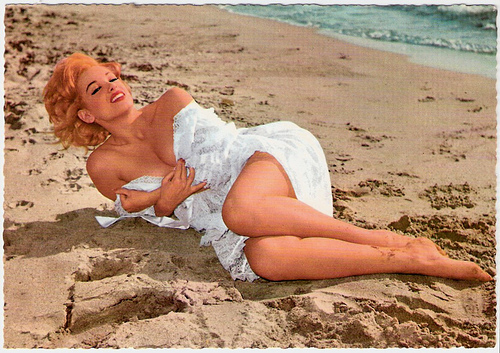
German postcard by Krüger, no. 902/361. Photo: Georg Michalke.
Cool and beautiful Margaret Lee (1943) passed away. She posed as a glamorous starlet for many international magazines throughout the 1960s. Between 1962 and 1983 the British-born actress co-starred in over 70 European films. She was 80.
30 April 2024: Duane Eddy
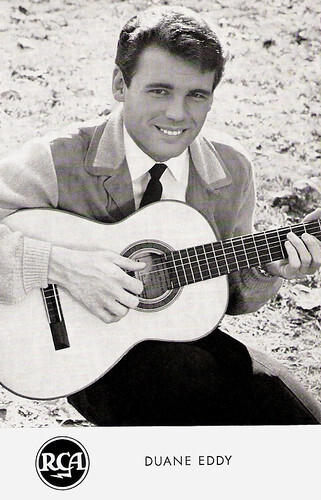
West German promotion card by RCA Schallplatten. Photo: Teldec / RCA.
American guitarist Duane Eddy died of cancer at the age of 86. He had instrumental hits like 'Rebel Rouser', 'Peter Gunn', 'Cannonball' and 'Forty Miles of Bad Road'. He was called 'King of Twang', because of the distinctive reverb of his guitar. With his twangy way of playing, he brought a new sound to rock and roll and inspired generations of colleagues, from George Harrison and The Shadows to Bruce Springsteen. His music can be heard in films like Natural Born Killers (1994), Forrest Gump (1994) and Broken Arrow (1996).
1 June 2024: Ruth-Maria Kubitschek
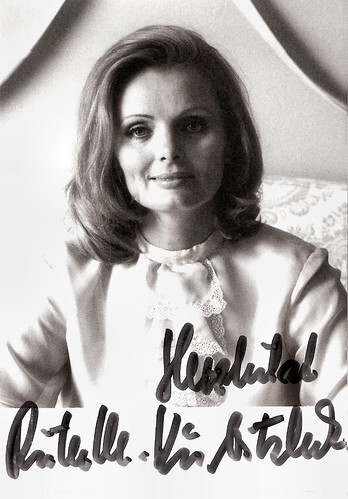
West German autograph card by TURA.
In a career spanning around six decades, Czech-born, German-Swiss actress Ruth-Maria Kubitschek (1931-2024) appeared in over 160 film and television productions. She became known to television audiences as Annette von Soettingen, alias ‘Spatzl’, in Monaco Franze - Der ewige Stenz (1983), as newspaper publisher Friederike von Unruh in Kir Royal (1986) and as Margot Balbeck in Das Erbe der Guldenburgs (1987). Ruth-Maria Kubitschek was 92.
1 June 2024: Philippe Leroy
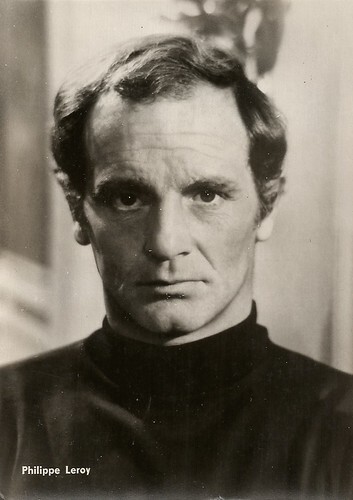
East-German Starfoto by VEB Progress Filmvertrieb, Berlin. The postcard refers to the Italo-Franco-Spanish film Sette uomini d'oro/Seven Golden Men (Marco Vicario, 1965) and the Italian film La notte è fatta per... rubare/Night Was Made for Stealing (Giorgio Capitani, 1968).
French actor Philippe Leroy (1930-2024) appeared in over 150 films from 1960. He was nominated for a BAFTA Award for his debut performance in Jacques Becker’s Le trou/The Hole (1960). He worked in France, but Leroy acted mainly in Italy where his name remains linked to the TV series Sandokan (1976), and La vita di Leonardo da Vinci/The Life of Leonardo da Vinci (1971). He was also known as the co-star of Rossana Podestà in the films Sette uomini d'oro/Seven Golden Men (1965) and the sequel Il grande colpo dei 7 uomini d'oro/The Great Strike of the 7 Golden Men (1966).
2 June 2024: Janis Paige
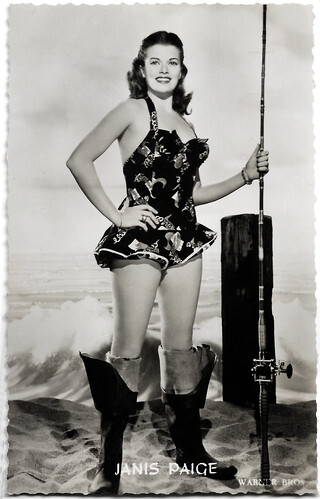
Vintage postcard. Photo: Warner Bros.
American film, musical theatre, and television actress Janis Paige (1922-2024) passed away at the age of 101. With a career spanning over 60 years, she was one of the last surviving stars from the Golden Age of Hollywood. Paige felt out of place in her early Hollywood films. She became a star on Broadway and then returned to Hollywood for a second film career. Beginning in the mid-fifties, she would also make numerous television appearances, as well as star in her sitcom It's Always Jan.
11 June 2024: Françoise Hardy
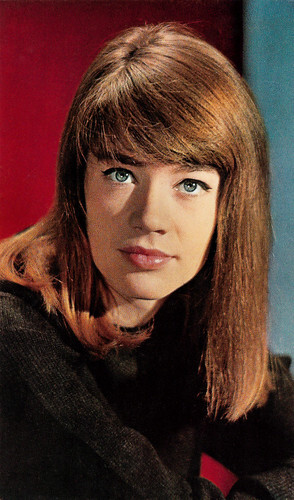
French postcard by E.D.U.G., offered by Corvisart, Epinal, no. 287. Photo: Sam Lévin.
French singer, actress and astrologer Françoise Hardy (1944-2024) was the original Yé-yé girl with her trademark jeans and leather jacket. She was one of the most popular French music stars of the 1960s and occasionally appeared in international films. She represented Monaco at the Eurovision Song Contest in 1963 and placed 6th. Hardy died after years of illness - she suffered from lymphoma and laryngeal cancer - at the age of 80. She remains an icon of fashion, music and style.
18 June 2024: Anouk Aimée
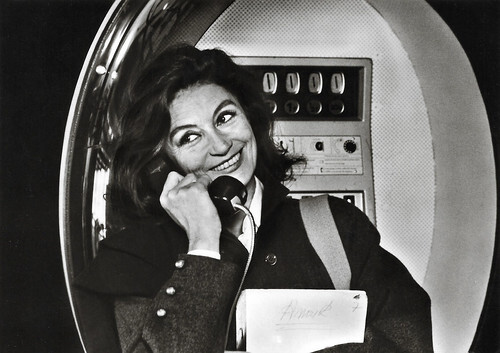
Big East-German card by Progress Film-Verleih.
Glamorous French film actress Anouk Aimée (1932-2024) appeared in 70 films since 1947 and worked with many talented directors. She had major international successes in the 1960s with Lola (1961) and Un homme et une femme/A Man and a Woman (1966) in which she defined a new kind of modern heroine. Anouk Aimée was 92.
20 June 2024: Donald Sutherland
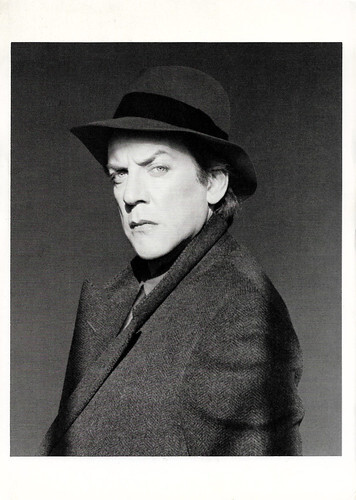
American postcard by Fotofolio, N.Y., N.Y., no. RM28. Photo: Robert Mapplethorpe. Caption: Donald Sutherland, 1983.
Canadian actor Donald Sutherland (1935-2024) rose to fame after starring in films including M*A*S*H (1970), Klute (1971), Don't Look Now (1973), Fellini's Casanova (1976), and 1900 (1976). During his long film career, he won two Golden Globe Awards, for the television films Citizen X (1995) and Path to War (2002), and an Emmy Award for the former. In 2017, he received an Honorary Oscar for his contributions to cinema. Sutherland was 88.
5 July 2024: Yvonne Furneaux
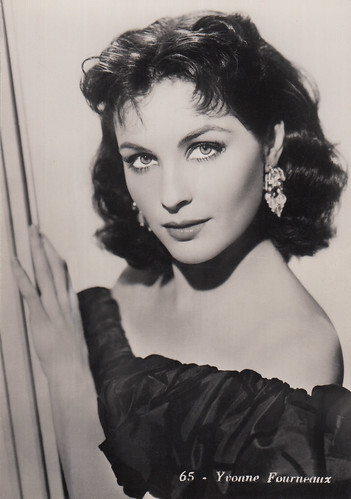
Italian postcard by Turismofoto, no. 65. Collection: Marlene Pilaete.
French-British actress Yvonne Furneaux (1926-2024) was a graduate of the Royal Academy of Dramatic Art. She worked with notable filmmakers like Peter Brook, Federico Fellini, Roman Polanski, Michelangelo Antonioni, and Claude Chabrol, but also appeared in several genre productions. Furneaux died of complications from a stroke at the age of 98.
11 July 2024: Shelley Duvall
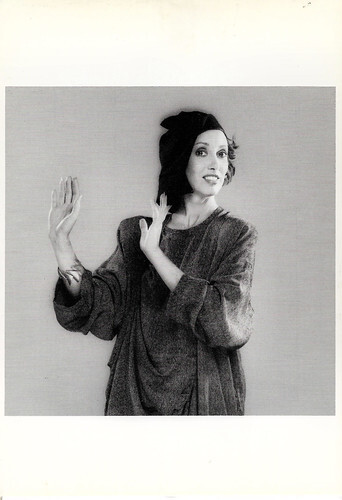
American postcard by Fotofolio, N.Y., N.Y., no. RM25 Photo: Robert Mapplethorpe. Caption: Shelley Duvall, 1984.
Shelley Duvall (1949-2024) died of diabetes at the age of 75. The American actress will always be remembered for that one, almost inhumanly heavy role in Stanley Kubrick's horror classic The Shining (1980). She had to walk 127 times backwards up the stairs of that labyrinthine haunted hotel while sobbing and waving a baseball bat at her insane husband, played by Jack Nicholson with his diabolical grimace. But Duvall's film life counted many more memorable roles.
13 July 2024: Shannen Doherty
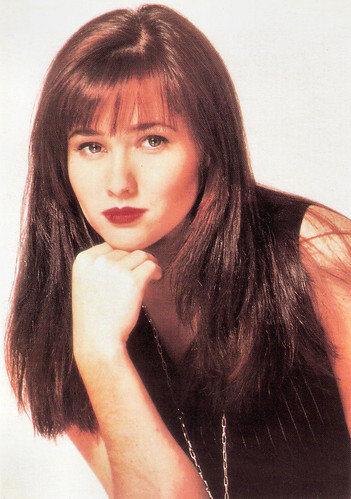
Vintage postcard.
American actress Shannen Doherty (1971-2024) starred in the teen comedies Girls Just Want to Have Fun (1985) alongside Sarah Jessica Parker and Helen Hunt and Heathers (1988), starring Winona Ryder. Her real success came in 1990, at the age of 19, when she was cast in Aaron Spelling's long-running hit series, Beverly Hills, 90210 (1990-1994) as Brenda Walsh, the twin sister of Brandon Walsh, played by Jason Priestley. It made her a household name. Afterwards, she continued her work in mediocre films and such TV series as Charmed (1998), North Shore (2004-2005) and Breaking Up with Shannen Doherty (2006).
15 July 2024: Wieteke van Dort
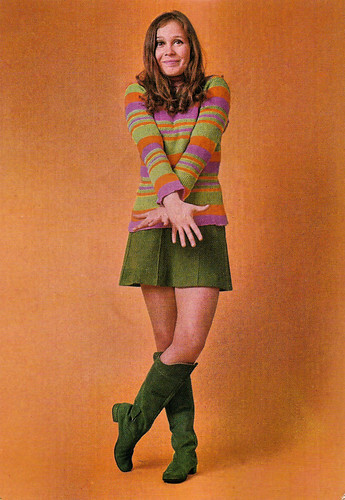
Dutch autograph card.
Wieteke van Dort (1943-2024) died of cancer at the age of 81. She appeared in legendary children's programmes on Dutch TV as an actress and singer. Throughout her life, she carried her childhood in the Dutch East Indies with her, culminating in her creation of Aunt Lien. She also appeared in several Dutch films.
1 August 2024: Pina Bottin
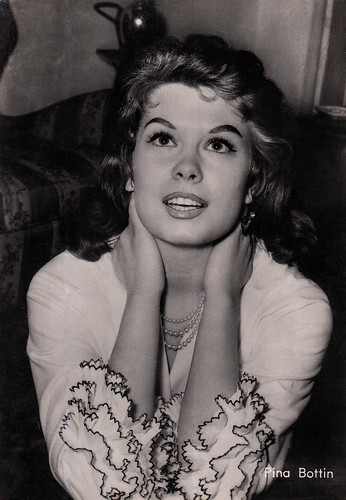
Italian postcard by Bromostampa Milano, no 207. Collection: Marlene Pilaete.
Italian actress Pina Bottin (1933–2024) worked in various Italian films and television programs from 1953 to 1970. On 1 August 2024, it was announced that she died at her home in the Sacra Famiglia neighbourhood of Padua at the age of 91.
14 August 2024: Gena Rowlands
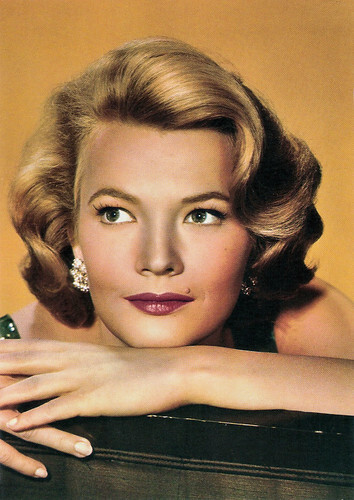
Italian postcard by Rotalfoto, Milano, no. N. 155.
American actress Gena Rowlands died in Indian Wells, Southern California. Rowlands played roles in theatre, television series and the cinema. She was nominated for an Oscar for her roles in A Woman Under the Influence (1974) and Gloria (1980), both directed by her husband, John Cassavetes. Gena Rowlands was 94.
18 August 2024: Alain Delon
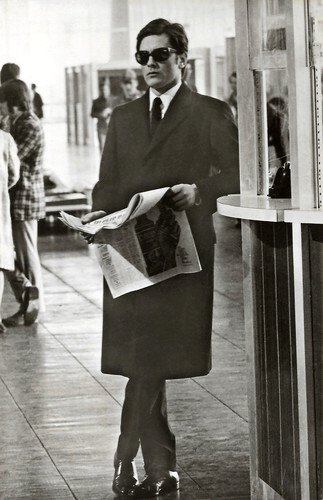
Romanian postcard by Casa Filmului Acin, no. 428. Alain Delon in Le clan des Siciliens/The Sicilian Clan (Henri Verneuil, 1969).
French film star Alain Delon (1935) died at the age of 88. He was the breathtakingly good-looking James Dean of European cinema in the late 1950s and early 1960s. He proved in such films as Plein soleil/Purple Noon (René Clément, 1960), Rocco e i suoi fratelli/Rocco and his Brothers (Luchino Visconti, 1960) and L'eclisse/The Eclypse (Michelangelo Antonioni, 1962) that he was also a magnificent actor. Delon later starred in a series of popular gangster films by directors like Henri Verneuil, Jacques Deray and Jean-Pierre Melville.
18 August 2024: Boris Bystrov
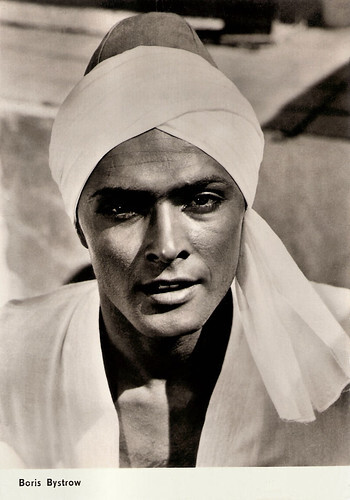
East German postcard by VEB Progress Film-Vertrieb, Berlin, no. 3005. Boris Bystrov in Volshebnaya lampa Aladdina/Aladdin's Magic Lamp (Boris Rytsarev, 1967).
Russian actor and voice actor Boris Bystrov (1945–2024) had his breakthrough as Aladdin in the famous Soviet fairy tale film Volshebnaya lampa Aladdina/Aladdin's Magic Lamp (1967). Later he was known as the Russian voice of Homer Simpson.
2 September 2024: James Darren
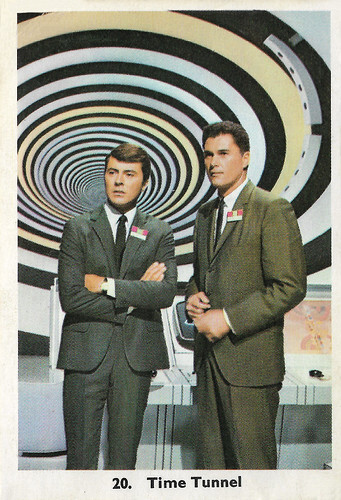
Vintage collectors card, no. 20. James Darren and Robert Colbert in the TV series The Time Tunnel (1966), created by Irwin Allen. Two scientists with a secret time travel project find themselves trapped in the time stream and appearing in notable periods of history.
American actor and singer James Darren (1936-2024) died in Los Angeles, California. His acting work for film and television includes more than 50 productions. He was 88.
8 September 2024: Pim de la Parra
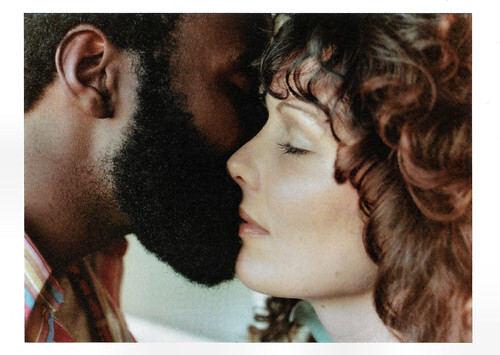
Dutch postcard by Eye Filmmuseum, Amsterdam. Photo: Scorpio Films BV Collection Eye Filmmuseum. Willeke van Ammelrooy and Borger Breeveld in Wan Pipel/One People (Pim de la Parra, 1976).
Surinamese-Dutch director Pim de la Parra (1940-2024) died in Paramaribo after a short illness, at the age of 84. He was the director of such films as Bezeten - Het gat in de muur/Obsessions (1969) and Wan Pipel (1976).
9 September 2024: Caterina Valente
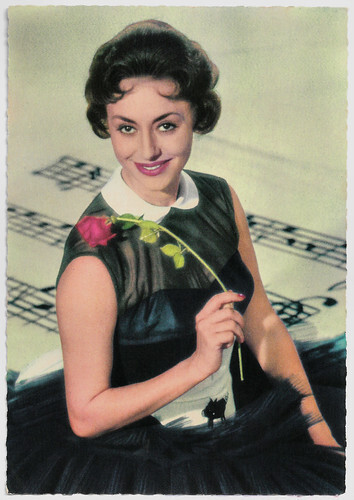
West German postcard by ISV, no. N 10. Photo: CCC / Grimm.
Italian singer, dancer and actress Caterina Valente (1931) passed away at 93. In the late 1950s and early 1960s, she was the queen of the German Schlager music. Her popularity was global, and she played and sang in fifteen films. The Guinness Book of World Records recognised her as Europe's most successful female recording artist, with over 1350 albums to her credit.
13 September 2024: Franca Bettoia
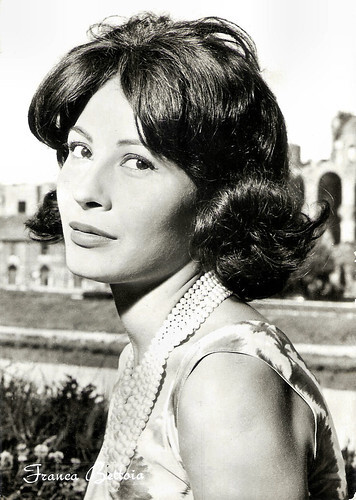
Italian postcard by Rotalfoto, Milano, no. 897.
Italian actress Franca Bettoia (1936-2024) starred in several Italian films of the 1950s and 1960s. Bettoia was best known for the chilling Sci-Fi/Horror tale L'Ultimo uomo della Terra/The Last Man on Earth (1964) and as the wife of Ugo Tognazzi. She was 88.
20 September 2024: Kathryn Grant
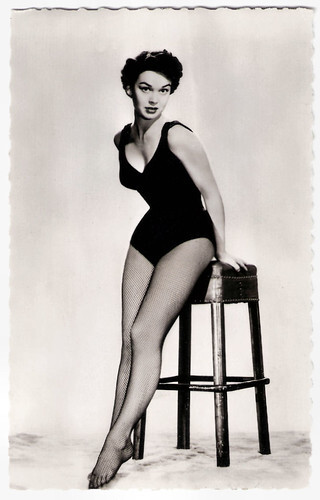
French postcard by Editions P.I., no. 835, offered by Les Carbones Korès 'Carboplane'. Photo: Browning Studio / H.P.S.
American actress Kathryn Grant (1933-2024) was a pert, vivacious and stunning brunette, who later became the wife of Bing Crosby.
27 September 2024: Maggie Smith
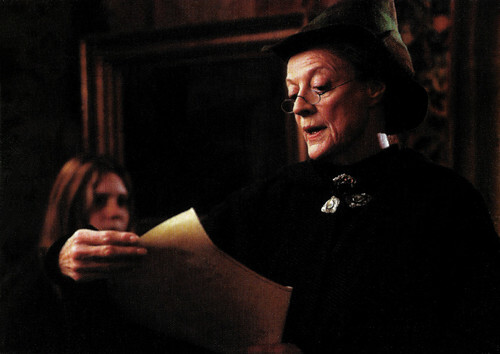
French postcard by Editions Mango, 2002. Photo: Warner Bros. Maggie Smith in Harry Potter and the Chamber of Secrets (Chris Columbus, 2002).
Oscar-winning star of stage and screen Dame Maggie Smith (1934-2024) was known for her sharp tongue on screen and off during a varied and acclaimed career that spanned eight decades. She performed in over sixty films and television series. In the Harry Potter films (2001–2011), she played the acerbic Professor Minerva McGonagall, famous for her pointed witch's hat and stern manner with the young wizards at Hogwarts.
29 September 2024: Kris Kristofferson
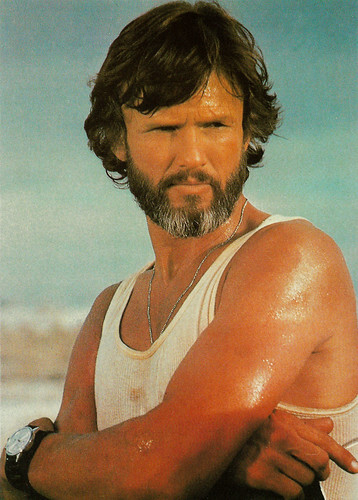
Italian postcard by Vitorius, Roma, no. VR 427. Kris Kristofferson in Convoy (Sam Peckinpah, 1978).
American singer and actor Kris Kristofferson died at his home in Maui, Hawaii, aged 88. The prolific artist with his trademark beard and long hair was a major star in both Nashville and Hollywood. He wrote songs for hundreds of other artists, including 'Me and Bobby McGee' for Janis Joplin and 'Sunday Morning Coming Down' for Johnny Cash. In the mid-1970s, he worked with film directors including Martin Scorsese and Sam Peckinpah, and won a Golden Globe for his work opposite Barbra Streisand in the 1976 remake of A Star Is Born. Kristofferson retired in 2021 after a six-decade career.
3 October 2024: Michel Blanc
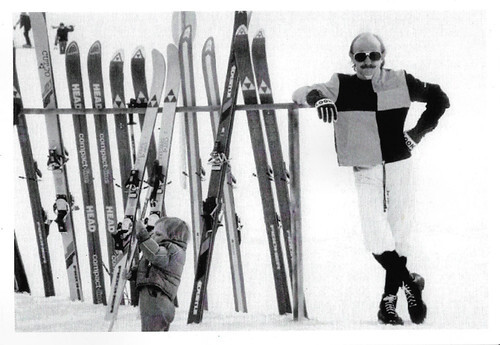
French postcard by INPI. Michel Blanc in Les Bronzés font du ski/French Fried Vacation 2 (Patrice Leconte, 1979).
French film star, writer and director Michel Blanc (1952-2024) died after a severe allergic shock during a medical examination. Blanc suffered a heart attack and died that evening in a Paris hospital. Blanch was best known for French films Les Bronzés/French Fried Vacation (1978) and Monsieur Hire (1989). With his trademark bald head and moustache, he brought a comic quality to even his saddest characters including losers and hypochondriacs. He was 72.
9 October 2024: Elisa Montés
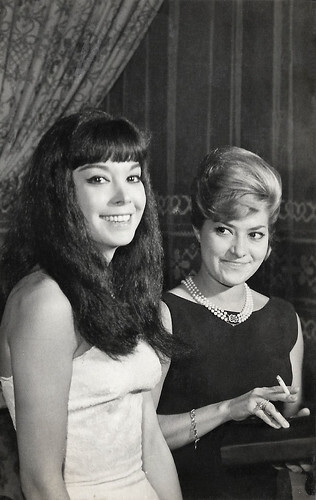
Small Czech collectors card by Pressfoto, Praha (Prague), 1964, no. 56/10. Elisa Montés (left) with Conchita Bautista at the Karlovy Vary International Film Festival.
One of the most successful Spanish actresses, Elisa Montés (1934-2024) died, two months before her 90th birthday. After her film debut in 1954, she played angelic ingenues of prudish wives in Spanish films. During the 1960s, she played in several international co-productions including Spaghetti Westerns, shot in Almería. She became a household name in Spain with the immensely popular TV series Verano Azul/Blue Summer (1981-1982).
10 October 2024: Véronique Zuber
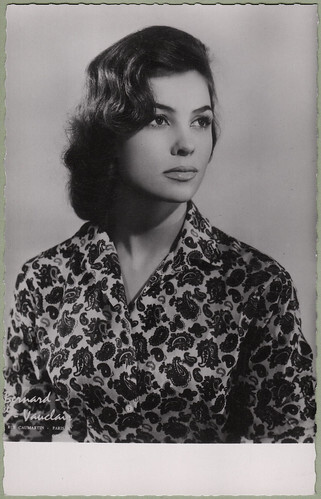
French postcard by Editions P.I., Paris, no 861. Collection: Marlene Pilaete.
French model and actress Véronique Zuber (1936-2024) was elected Miss France in 1955. She had a short film career before her marriage to fashion designer Ted Lapidus. Zuber died in Saint-Brice-sous-Forêt at the age of 88.
17 October 2024: Mitzi Gaynor
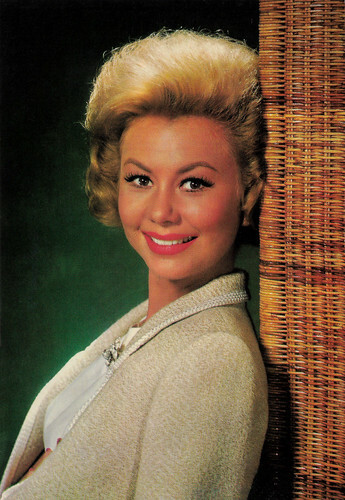
Spanish postcard by Postal Oscarcolor, S.L., no. 8.
Bright-eyed American actress, singer, and dancer Mitzi Gaynor (1931-2024) was a leading lady in light musicals, including There's No Business Like Show Business (1954), which featured Irving Berlin's music and starred Ethel Merman, and South Pacific (1958), based on the musical by Rodgers and Hammerstein. Mitzi Gaynor was 93.
23 October 2024: Jack Jones
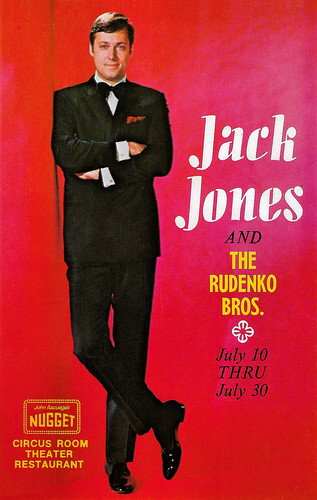
American postcard by Mike Roberts Color Production, Berkeley, California, no. SC12281. Jack Jones performed at John Ascuegel's Nugget, Sparks (East Reno), Nevada. Jones appeared here with The Rudenko Bros. from 10 till 30 July, year unknown.
American pop and jazz singer and actor Jack Jones (1938-2024) passed away in Rancho Mirage, California. He had a long, successful career in music and won two Grammy Awards and received five nominations for Grammys, but he was best known to international audiences for the title music of the TV series The Love Boat.
8 November 2024: Geneviève Grad
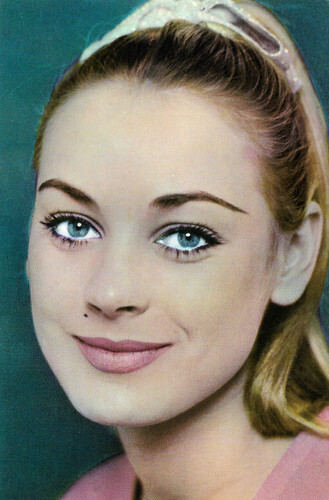
Romanian postcard by Casa Filmului Acin, no. 119.
French actress Geneviève Grad (1944-2024) was best known as the beautiful blonde daughter of Louis de Funès in the first three films of the Gendarme of Saint-Tropez series of the 1960s. In the late 1960s, she made some erotic films.
26 November 2024: Karin Baal
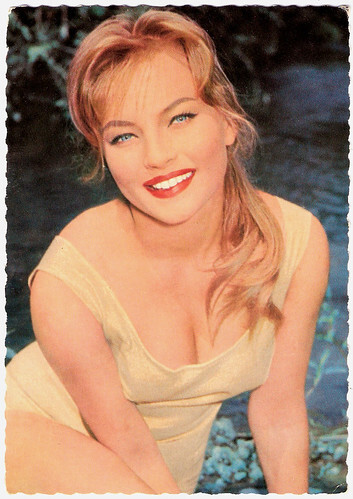
German postcard by Universum-Film Aktiengesellschaft (Ufa), Berlin-Tempelhof, no. CK 392. Retail price: 30 Pfg. Photo: Georg Michalke / Ufa.
German film actress Karin Baal (1940-2024) appeared in over 90 films. Baal started as a teenage rebel in the cult film Die Halbstarken (1956) and became one of the brightest stars of the Wirtschaftswunder cinema. She was 84.
28 November 2024: Silvia Pinal
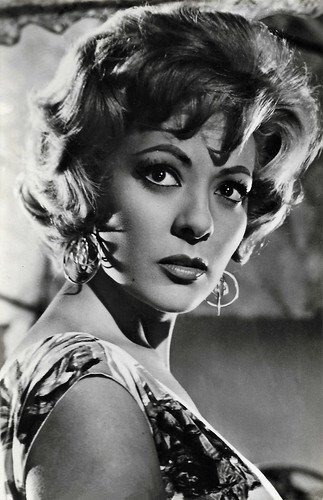
Spanish postcard by Archivo Bermejo, no 782. Photo: As Films. Silvia Pinal in Maribel y la extraña familia / Maribel and the Strange Family (José María Forqué, 1960).
Legendary Mexican actress Silvia Pinal (1931-2024) was the last remaining diva of the Golden Era of Mexican cinema (1936-1956). Pinal achieved international recognition with Luis Buñuel's film trilogy Viridiana (1961), El ángel exterminador (1962) and Simón del desierto (1965). Silvia Pinal was 93.
5 December 2024: Christel Bodenstein

East German postcard by VEB Progress Film-Vertrieb, Berlin, no. 3106, 1968. Photo: Balinski.
German film and television actress Christel Bodenstein (1938-2024) appeared in many East German (GDR) productions and is best known for her leading role as the beautiful but haughty princess in the fairytale film Das singende, klingende Bäumchen/The Singing Ringing Tree (1957). She was 86.
17 December 2024: Marisa Paredes
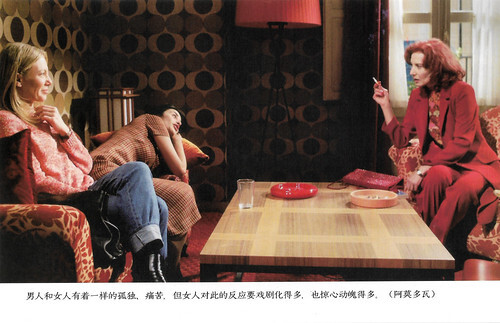
Chinese postcard. Cecilia Roth, Marisa Paredes and Penelope Cruz in Todo sobre mi madre / All About My Mother (Pedro Almodóvar, 1999).
Spanish actress Marisa Paredes (1946-2024) died in Madrid from heart failure. She was a legend of Spanish cinema and acted in 75 films. She will be best remembered for the five films she starred in directed by Pedro Almodóvar. Paredes was 78.
27 December 2024: Olivia Hussey
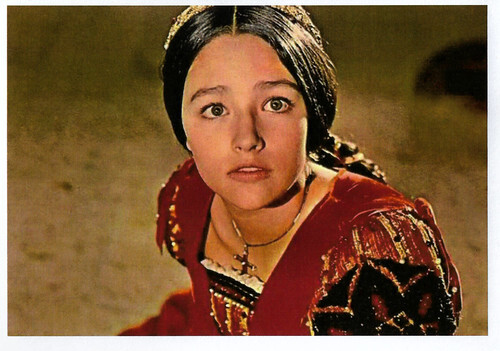
Italian postcard. Olivia Hussey in Romeo and Juliet (Franco Zeffirelli, 1968).
British actress Olivia Hussey (1951-2024) acted in over 40 films. In 1968, she got a leading role in the film adaptation of 'Romeo and Juliet' by Franco Zeffirelli. She was chosen out of 500 other actresses. For this, she won a David di Donatello, the Italian national film award, in 1969. Other memorable performances include those in Jesus of Nazareth (1977) and Death on the Nile (1978), among others. She is also known for her role in the TV series Ivanhoe (1982). Hussey died in Burvabnk, at the age of 73, following a recurrence of her breast cancer.
4 January 2024: Glynis Johns

Spanish postcard by Archivo Bermejo, no. C 293.
Husky voiced Welsh-born stage and film actress, dancer, pianist and singer Glynis Johns (1923-2024) was best known for her film roles as a mermaid in the British comedy Miranda (1948) and as suffragette mother Winifred Banks in Walt Disney's Mary Poppins (1964). On Broadway, she created the role of Desiree Armfeldt in 'A Little Night Music', for which she won a Tony Award.
4 January 2024: David Soul

British postcard by Klasik Kards, London, sent by mail in 1988. Photo: Robert H. Cain Media Star Archive / ABC, Inc. David Soul (left) and Paul Michael Glaser in the TV Series Starsky and Hutch (1975-1979).
American-British actor and singer David Soul achieved pop icon status as handsome, blond-haired, blue-eyed Detective Kenneth Hutchinson on the cult 'buddy cop' TV series Starsky and Hutch (1975-1979). His other notable roles included Joshua Bolt on the TV series Here Come the Brides (1968-1970) and vampire hunter Ben Mears in the TV movie Salem's Lot (1979) opposite James Mason. Soul also had a very successful singing career recording several albums, with worldwide number-one hit singles including 'Silver Lady and 'Don't Give Up on Us Baby'.
14 January 2024: Elisabeth Trissenaar

German postcard by Franz Josef Rüdel, Filmpostkartenverlag, Hamburg. Photo: Ingrid v. Paleske, München.
Austrian actress Elisabeth Trissenaar (1944-2024) was best known for her roles in Rainer Werner Fassbinder's film Die Ehe der Maria Braun (1979) and his 14-part miniseries Berlin Alexanderplatz (1980). She also appeared in the West German-Dutch film Charlotte (1981), Andrzej Wajda's drama Eine Liebe in Deutschland/A Love in Germany (1983) and the Oscar-nominated war drama Bittere Ernte/Angry Harvest (1985) with Armin Müller-Stahl.
29 January 2024: Sandra Milo

Italian postcard by Rotalfoto, no. 98.
Italian actress Sandra Milo (1933-2024) was best known for her roles in Federico Fellini's 8½ (1963) and Giulietta degli spiriti/Juliet of the Spirits (1965), but she also worked with the famous directors Antonio Pietrangeli and Roberto Rossellini. She won the Silver Ribbon Best Supporting Actress award for both 8½ and Juliet of the Spirits. Sandra Milo was 90.
2 February 2024: Don Murray

Spanish postcard by Archivo Bermejo, no. 7317. Photo: 20th Century Fox. Don Murray in A Hatful of Rain (Fred Zinnemann, 1957).
American actor Don Murray (1928-2024) was best known for his breakout performance in the film Bus Stop (1956), with Marilyn Monroe. His role earned him a nomination for the Academy Award for Best Supporting Actor. His other films include A Hatful of Rain (1957) and Conquest of the Planet of the Apes (1972). Murray was 94.
13 February 2024: Johanna von Koczian

West German postcard by UFA, Berlin-Tempelhof, no. CK-323. Photo: Ringpress / Vogelmann.
During the late 1950s and early 1960s, German actress, singer and author Johanna von Koczian (1933-2024) was one of Germany’s most popular film stars. Later, she evolved into a stage actress, a popular Schlager singer, a TV presenter, and a successful author of novels and children's books. Johanna von Koczian was 90.
15 February 2024: Gérard Barray

Czech collector card by Pressfoto, Praha (Prague), 1964, no. S 58/7.
French film and television actor Gérard Barray (1931-2024) was once called 'the most handsome man in the world' and became one of the swashbuckling heroes of French cinema. During the 1960s, he starred as D’Artagnan and Scaramouche but also starred in many Eurospy films. He married his Spanish co-star, flamenco dancer Teresa Lorca, and settled in Andalusia. Barray was 92.
21 February 2024: Micheline Presle

French postcard by Collection Chantal, Paris, no. 637. Photo: Discina, Paris.
French actress Micheline Presle (1922-2024) passed away at 101. In the 1940s and 1950s, she formed the queen trio of French cinema with Michèle Morgan and Danielle Darrieux. The chic and elegant star gained worldwide attention for Le diable au corps/Devil in the Flesh (Claude Autant-Lara, 1947). The success of this film also earned Presle three roles in a Hollywood production, under the name Micheline Prelle. Over nine decades, La Presle made more than one hundred and fifty films.
25 March 2024: Fritz Wepper

West German postcard by Rüdel-Verlag, Hamburg, no. 5177. Photo: Divina / Gloria / Milles. Fritz Wepper in Nachbarn sind zum Ärgern da/Neighbors are there to annoy you (Peter Weck, 1970).
German television and film actor Fritz Wepper (1941-2024) died at the age of 82. In 1972, he played an important supporting role in Bob Fosse's classic musical Cabaret. He became an international cult figure as inspector Harry Klein, first in the Krimi series Der Kommissar/The Commissioner (1969–1976) and later in another popular Krimi series Derrick (1974-1998). He also won several German TV awards, including one for his role in the series Um Himmels Willen/For Heaven's Sake (2002-2021).
31 March 2024: Barbara Rush

Italian postcard by Rotalfoto. Milano, no. N. 120.
American actress Barbara Rush (1927-2024) was the epitome of poise, charm, style, and grace in Hollywood films of the 1950s. In 1954, she won the Golden Globe Award as Most Promising Female Newcomer for the Science-Fiction film It Came from Outer Space (1953). She played the female lead in such films as The Young Philadelphians (1959), The Young Lions (1958), and Hombre (1967). Later in her career, Rush guest-starred on TV in such series as Peyton Place, All My Children and 7th Heaven.
30 March 2024: Gezá Tordy

East German postcard by VEB Progress Film-Vertrieb, Berlin, no. 2691, 1966. Gezá Tordy in Ketten haltak meg/Two died (György Palásthy, 1966).
Hungarian actor and director Géza Tordy (1938-2024) passed away in Budapest at the age of 85. The distinguished artist was the winner of the Kossuth Prize winner and the Jászai Mari Prize.
3 April 2024: Vera Tschechowa

Vintage autograph card.
German film and television actress Vera Tschechowa (1940-2024) passed away in Berlin at 83. Her grandfather was the Russian Oscar-nominated actor Michael Chekhov who was the nephew of author Anton Chekhov. Her grandmother was legendary film star Olga Tschechowa. The elegant, green-eyed actress appeared in over 50 films since 1957.
24 April 2024: Margaret Lee

German postcard by Krüger, no. 902/361. Photo: Georg Michalke.
Cool and beautiful Margaret Lee (1943) passed away. She posed as a glamorous starlet for many international magazines throughout the 1960s. Between 1962 and 1983 the British-born actress co-starred in over 70 European films. She was 80.
30 April 2024: Duane Eddy

West German promotion card by RCA Schallplatten. Photo: Teldec / RCA.
American guitarist Duane Eddy died of cancer at the age of 86. He had instrumental hits like 'Rebel Rouser', 'Peter Gunn', 'Cannonball' and 'Forty Miles of Bad Road'. He was called 'King of Twang', because of the distinctive reverb of his guitar. With his twangy way of playing, he brought a new sound to rock and roll and inspired generations of colleagues, from George Harrison and The Shadows to Bruce Springsteen. His music can be heard in films like Natural Born Killers (1994), Forrest Gump (1994) and Broken Arrow (1996).
1 June 2024: Ruth-Maria Kubitschek

West German autograph card by TURA.
In a career spanning around six decades, Czech-born, German-Swiss actress Ruth-Maria Kubitschek (1931-2024) appeared in over 160 film and television productions. She became known to television audiences as Annette von Soettingen, alias ‘Spatzl’, in Monaco Franze - Der ewige Stenz (1983), as newspaper publisher Friederike von Unruh in Kir Royal (1986) and as Margot Balbeck in Das Erbe der Guldenburgs (1987). Ruth-Maria Kubitschek was 92.
1 June 2024: Philippe Leroy

East-German Starfoto by VEB Progress Filmvertrieb, Berlin. The postcard refers to the Italo-Franco-Spanish film Sette uomini d'oro/Seven Golden Men (Marco Vicario, 1965) and the Italian film La notte è fatta per... rubare/Night Was Made for Stealing (Giorgio Capitani, 1968).
French actor Philippe Leroy (1930-2024) appeared in over 150 films from 1960. He was nominated for a BAFTA Award for his debut performance in Jacques Becker’s Le trou/The Hole (1960). He worked in France, but Leroy acted mainly in Italy where his name remains linked to the TV series Sandokan (1976), and La vita di Leonardo da Vinci/The Life of Leonardo da Vinci (1971). He was also known as the co-star of Rossana Podestà in the films Sette uomini d'oro/Seven Golden Men (1965) and the sequel Il grande colpo dei 7 uomini d'oro/The Great Strike of the 7 Golden Men (1966).
2 June 2024: Janis Paige

Vintage postcard. Photo: Warner Bros.
American film, musical theatre, and television actress Janis Paige (1922-2024) passed away at the age of 101. With a career spanning over 60 years, she was one of the last surviving stars from the Golden Age of Hollywood. Paige felt out of place in her early Hollywood films. She became a star on Broadway and then returned to Hollywood for a second film career. Beginning in the mid-fifties, she would also make numerous television appearances, as well as star in her sitcom It's Always Jan.
11 June 2024: Françoise Hardy

French postcard by E.D.U.G., offered by Corvisart, Epinal, no. 287. Photo: Sam Lévin.
French singer, actress and astrologer Françoise Hardy (1944-2024) was the original Yé-yé girl with her trademark jeans and leather jacket. She was one of the most popular French music stars of the 1960s and occasionally appeared in international films. She represented Monaco at the Eurovision Song Contest in 1963 and placed 6th. Hardy died after years of illness - she suffered from lymphoma and laryngeal cancer - at the age of 80. She remains an icon of fashion, music and style.
18 June 2024: Anouk Aimée

Big East-German card by Progress Film-Verleih.
Glamorous French film actress Anouk Aimée (1932-2024) appeared in 70 films since 1947 and worked with many talented directors. She had major international successes in the 1960s with Lola (1961) and Un homme et une femme/A Man and a Woman (1966) in which she defined a new kind of modern heroine. Anouk Aimée was 92.
20 June 2024: Donald Sutherland

American postcard by Fotofolio, N.Y., N.Y., no. RM28. Photo: Robert Mapplethorpe. Caption: Donald Sutherland, 1983.
Canadian actor Donald Sutherland (1935-2024) rose to fame after starring in films including M*A*S*H (1970), Klute (1971), Don't Look Now (1973), Fellini's Casanova (1976), and 1900 (1976). During his long film career, he won two Golden Globe Awards, for the television films Citizen X (1995) and Path to War (2002), and an Emmy Award for the former. In 2017, he received an Honorary Oscar for his contributions to cinema. Sutherland was 88.
5 July 2024: Yvonne Furneaux

Italian postcard by Turismofoto, no. 65. Collection: Marlene Pilaete.
French-British actress Yvonne Furneaux (1926-2024) was a graduate of the Royal Academy of Dramatic Art. She worked with notable filmmakers like Peter Brook, Federico Fellini, Roman Polanski, Michelangelo Antonioni, and Claude Chabrol, but also appeared in several genre productions. Furneaux died of complications from a stroke at the age of 98.
11 July 2024: Shelley Duvall

American postcard by Fotofolio, N.Y., N.Y., no. RM25 Photo: Robert Mapplethorpe. Caption: Shelley Duvall, 1984.
Shelley Duvall (1949-2024) died of diabetes at the age of 75. The American actress will always be remembered for that one, almost inhumanly heavy role in Stanley Kubrick's horror classic The Shining (1980). She had to walk 127 times backwards up the stairs of that labyrinthine haunted hotel while sobbing and waving a baseball bat at her insane husband, played by Jack Nicholson with his diabolical grimace. But Duvall's film life counted many more memorable roles.
13 July 2024: Shannen Doherty

Vintage postcard.
American actress Shannen Doherty (1971-2024) starred in the teen comedies Girls Just Want to Have Fun (1985) alongside Sarah Jessica Parker and Helen Hunt and Heathers (1988), starring Winona Ryder. Her real success came in 1990, at the age of 19, when she was cast in Aaron Spelling's long-running hit series, Beverly Hills, 90210 (1990-1994) as Brenda Walsh, the twin sister of Brandon Walsh, played by Jason Priestley. It made her a household name. Afterwards, she continued her work in mediocre films and such TV series as Charmed (1998), North Shore (2004-2005) and Breaking Up with Shannen Doherty (2006).
15 July 2024: Wieteke van Dort

Dutch autograph card.
Wieteke van Dort (1943-2024) died of cancer at the age of 81. She appeared in legendary children's programmes on Dutch TV as an actress and singer. Throughout her life, she carried her childhood in the Dutch East Indies with her, culminating in her creation of Aunt Lien. She also appeared in several Dutch films.
1 August 2024: Pina Bottin

Italian postcard by Bromostampa Milano, no 207. Collection: Marlene Pilaete.
Italian actress Pina Bottin (1933–2024) worked in various Italian films and television programs from 1953 to 1970. On 1 August 2024, it was announced that she died at her home in the Sacra Famiglia neighbourhood of Padua at the age of 91.
14 August 2024: Gena Rowlands

Italian postcard by Rotalfoto, Milano, no. N. 155.
American actress Gena Rowlands died in Indian Wells, Southern California. Rowlands played roles in theatre, television series and the cinema. She was nominated for an Oscar for her roles in A Woman Under the Influence (1974) and Gloria (1980), both directed by her husband, John Cassavetes. Gena Rowlands was 94.
18 August 2024: Alain Delon

Romanian postcard by Casa Filmului Acin, no. 428. Alain Delon in Le clan des Siciliens/The Sicilian Clan (Henri Verneuil, 1969).
French film star Alain Delon (1935) died at the age of 88. He was the breathtakingly good-looking James Dean of European cinema in the late 1950s and early 1960s. He proved in such films as Plein soleil/Purple Noon (René Clément, 1960), Rocco e i suoi fratelli/Rocco and his Brothers (Luchino Visconti, 1960) and L'eclisse/The Eclypse (Michelangelo Antonioni, 1962) that he was also a magnificent actor. Delon later starred in a series of popular gangster films by directors like Henri Verneuil, Jacques Deray and Jean-Pierre Melville.
18 August 2024: Boris Bystrov

East German postcard by VEB Progress Film-Vertrieb, Berlin, no. 3005. Boris Bystrov in Volshebnaya lampa Aladdina/Aladdin's Magic Lamp (Boris Rytsarev, 1967).
Russian actor and voice actor Boris Bystrov (1945–2024) had his breakthrough as Aladdin in the famous Soviet fairy tale film Volshebnaya lampa Aladdina/Aladdin's Magic Lamp (1967). Later he was known as the Russian voice of Homer Simpson.
2 September 2024: James Darren

Vintage collectors card, no. 20. James Darren and Robert Colbert in the TV series The Time Tunnel (1966), created by Irwin Allen. Two scientists with a secret time travel project find themselves trapped in the time stream and appearing in notable periods of history.
American actor and singer James Darren (1936-2024) died in Los Angeles, California. His acting work for film and television includes more than 50 productions. He was 88.
8 September 2024: Pim de la Parra

Dutch postcard by Eye Filmmuseum, Amsterdam. Photo: Scorpio Films BV Collection Eye Filmmuseum. Willeke van Ammelrooy and Borger Breeveld in Wan Pipel/One People (Pim de la Parra, 1976).
Surinamese-Dutch director Pim de la Parra (1940-2024) died in Paramaribo after a short illness, at the age of 84. He was the director of such films as Bezeten - Het gat in de muur/Obsessions (1969) and Wan Pipel (1976).
9 September 2024: Caterina Valente

West German postcard by ISV, no. N 10. Photo: CCC / Grimm.
Italian singer, dancer and actress Caterina Valente (1931) passed away at 93. In the late 1950s and early 1960s, she was the queen of the German Schlager music. Her popularity was global, and she played and sang in fifteen films. The Guinness Book of World Records recognised her as Europe's most successful female recording artist, with over 1350 albums to her credit.
13 September 2024: Franca Bettoia

Italian postcard by Rotalfoto, Milano, no. 897.
Italian actress Franca Bettoia (1936-2024) starred in several Italian films of the 1950s and 1960s. Bettoia was best known for the chilling Sci-Fi/Horror tale L'Ultimo uomo della Terra/The Last Man on Earth (1964) and as the wife of Ugo Tognazzi. She was 88.
20 September 2024: Kathryn Grant

French postcard by Editions P.I., no. 835, offered by Les Carbones Korès 'Carboplane'. Photo: Browning Studio / H.P.S.
American actress Kathryn Grant (1933-2024) was a pert, vivacious and stunning brunette, who later became the wife of Bing Crosby.
27 September 2024: Maggie Smith

French postcard by Editions Mango, 2002. Photo: Warner Bros. Maggie Smith in Harry Potter and the Chamber of Secrets (Chris Columbus, 2002).
Oscar-winning star of stage and screen Dame Maggie Smith (1934-2024) was known for her sharp tongue on screen and off during a varied and acclaimed career that spanned eight decades. She performed in over sixty films and television series. In the Harry Potter films (2001–2011), she played the acerbic Professor Minerva McGonagall, famous for her pointed witch's hat and stern manner with the young wizards at Hogwarts.
29 September 2024: Kris Kristofferson

Italian postcard by Vitorius, Roma, no. VR 427. Kris Kristofferson in Convoy (Sam Peckinpah, 1978).
American singer and actor Kris Kristofferson died at his home in Maui, Hawaii, aged 88. The prolific artist with his trademark beard and long hair was a major star in both Nashville and Hollywood. He wrote songs for hundreds of other artists, including 'Me and Bobby McGee' for Janis Joplin and 'Sunday Morning Coming Down' for Johnny Cash. In the mid-1970s, he worked with film directors including Martin Scorsese and Sam Peckinpah, and won a Golden Globe for his work opposite Barbra Streisand in the 1976 remake of A Star Is Born. Kristofferson retired in 2021 after a six-decade career.
3 October 2024: Michel Blanc

French postcard by INPI. Michel Blanc in Les Bronzés font du ski/French Fried Vacation 2 (Patrice Leconte, 1979).
French film star, writer and director Michel Blanc (1952-2024) died after a severe allergic shock during a medical examination. Blanc suffered a heart attack and died that evening in a Paris hospital. Blanch was best known for French films Les Bronzés/French Fried Vacation (1978) and Monsieur Hire (1989). With his trademark bald head and moustache, he brought a comic quality to even his saddest characters including losers and hypochondriacs. He was 72.
9 October 2024: Elisa Montés

Small Czech collectors card by Pressfoto, Praha (Prague), 1964, no. 56/10. Elisa Montés (left) with Conchita Bautista at the Karlovy Vary International Film Festival.
One of the most successful Spanish actresses, Elisa Montés (1934-2024) died, two months before her 90th birthday. After her film debut in 1954, she played angelic ingenues of prudish wives in Spanish films. During the 1960s, she played in several international co-productions including Spaghetti Westerns, shot in Almería. She became a household name in Spain with the immensely popular TV series Verano Azul/Blue Summer (1981-1982).
10 October 2024: Véronique Zuber

French postcard by Editions P.I., Paris, no 861. Collection: Marlene Pilaete.
French model and actress Véronique Zuber (1936-2024) was elected Miss France in 1955. She had a short film career before her marriage to fashion designer Ted Lapidus. Zuber died in Saint-Brice-sous-Forêt at the age of 88.
17 October 2024: Mitzi Gaynor

Spanish postcard by Postal Oscarcolor, S.L., no. 8.
Bright-eyed American actress, singer, and dancer Mitzi Gaynor (1931-2024) was a leading lady in light musicals, including There's No Business Like Show Business (1954), which featured Irving Berlin's music and starred Ethel Merman, and South Pacific (1958), based on the musical by Rodgers and Hammerstein. Mitzi Gaynor was 93.
23 October 2024: Jack Jones

American postcard by Mike Roberts Color Production, Berkeley, California, no. SC12281. Jack Jones performed at John Ascuegel's Nugget, Sparks (East Reno), Nevada. Jones appeared here with The Rudenko Bros. from 10 till 30 July, year unknown.
American pop and jazz singer and actor Jack Jones (1938-2024) passed away in Rancho Mirage, California. He had a long, successful career in music and won two Grammy Awards and received five nominations for Grammys, but he was best known to international audiences for the title music of the TV series The Love Boat.
8 November 2024: Geneviève Grad

Romanian postcard by Casa Filmului Acin, no. 119.
French actress Geneviève Grad (1944-2024) was best known as the beautiful blonde daughter of Louis de Funès in the first three films of the Gendarme of Saint-Tropez series of the 1960s. In the late 1960s, she made some erotic films.
26 November 2024: Karin Baal

German postcard by Universum-Film Aktiengesellschaft (Ufa), Berlin-Tempelhof, no. CK 392. Retail price: 30 Pfg. Photo: Georg Michalke / Ufa.
German film actress Karin Baal (1940-2024) appeared in over 90 films. Baal started as a teenage rebel in the cult film Die Halbstarken (1956) and became one of the brightest stars of the Wirtschaftswunder cinema. She was 84.
28 November 2024: Silvia Pinal

Spanish postcard by Archivo Bermejo, no 782. Photo: As Films. Silvia Pinal in Maribel y la extraña familia / Maribel and the Strange Family (José María Forqué, 1960).
Legendary Mexican actress Silvia Pinal (1931-2024) was the last remaining diva of the Golden Era of Mexican cinema (1936-1956). Pinal achieved international recognition with Luis Buñuel's film trilogy Viridiana (1961), El ángel exterminador (1962) and Simón del desierto (1965). Silvia Pinal was 93.
5 December 2024: Christel Bodenstein

East German postcard by VEB Progress Film-Vertrieb, Berlin, no. 3106, 1968. Photo: Balinski.
German film and television actress Christel Bodenstein (1938-2024) appeared in many East German (GDR) productions and is best known for her leading role as the beautiful but haughty princess in the fairytale film Das singende, klingende Bäumchen/The Singing Ringing Tree (1957). She was 86.
17 December 2024: Marisa Paredes

Chinese postcard. Cecilia Roth, Marisa Paredes and Penelope Cruz in Todo sobre mi madre / All About My Mother (Pedro Almodóvar, 1999).
Spanish actress Marisa Paredes (1946-2024) died in Madrid from heart failure. She was a legend of Spanish cinema and acted in 75 films. She will be best remembered for the five films she starred in directed by Pedro Almodóvar. Paredes was 78.
27 December 2024: Olivia Hussey

Italian postcard. Olivia Hussey in Romeo and Juliet (Franco Zeffirelli, 1968).
British actress Olivia Hussey (1951-2024) acted in over 40 films. In 1968, she got a leading role in the film adaptation of 'Romeo and Juliet' by Franco Zeffirelli. She was chosen out of 500 other actresses. For this, she won a David di Donatello, the Italian national film award, in 1969. Other memorable performances include those in Jesus of Nazareth (1977) and Death on the Nile (1978), among others. She is also known for her role in the TV series Ivanhoe (1982). Hussey died in Burvabnk, at the age of 73, following a recurrence of her breast cancer.
Published on December 31, 2024 22:00
Ross Verlag
The Postcards
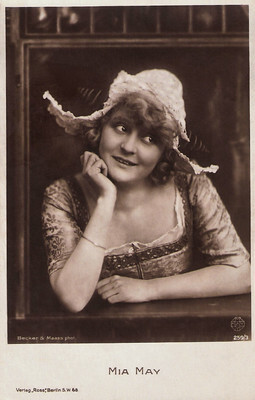
• Ross Verlag, Part 1: The Beginning
• Ross Verlag, Part 2: The Triumph of Silent Hollywood
• Ross Verlag, Part 3: The Last Years of Weimar
• Ross Verlag, Part 4: Hollywood Talks
• Ross Verlag, Part 5: The Final Years
• Ross Verlag, Part 6: Film-Foto-Verlag
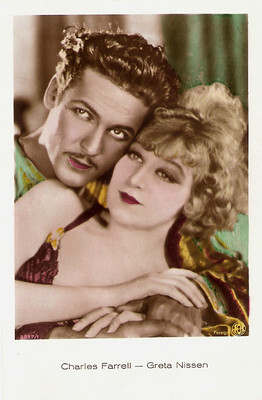
• Ross Verlag, Part 7: How Ross expanded
• Ross Verlag, Part 8: Ross Verlag in Colour
• Ross Verlag, Part 9: W.J. Mörlins
• Ross Verlag, Part 10: Das Programm von Heute
• Ross Verlag, Part 11: Foreign in the UK
• Ross Verlag, Part 12: Edition Ross
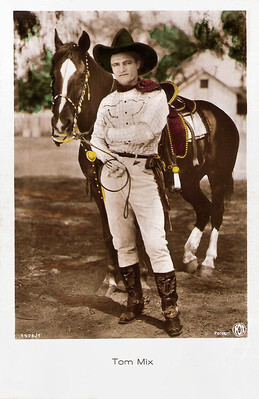
The Collector Cards
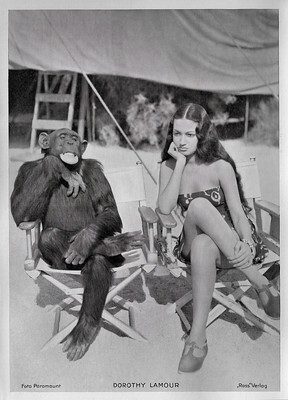
• Ross Verlag, Part 13: XXL cards
• Ross Verlag, Part 14: Unsere bunten Filmbilder
• Ross Verlag, Part 15: Moderne Schönheitsgalerie
• Ross Verlag, Part 16: Hänsom
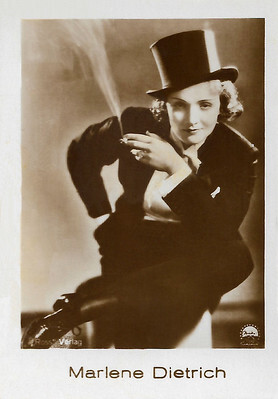
The Website
• Ross Verlag Movie Star Postcards .
•
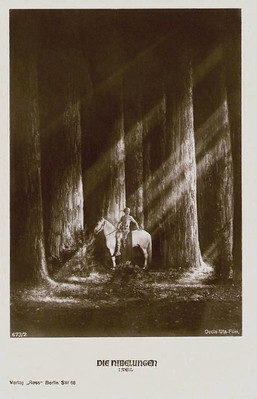
With thanks to Jean Ritsema and Mark Goffee.

• Ross Verlag, Part 1: The Beginning
• Ross Verlag, Part 2: The Triumph of Silent Hollywood
• Ross Verlag, Part 3: The Last Years of Weimar
• Ross Verlag, Part 4: Hollywood Talks
• Ross Verlag, Part 5: The Final Years
• Ross Verlag, Part 6: Film-Foto-Verlag

• Ross Verlag, Part 7: How Ross expanded
• Ross Verlag, Part 8: Ross Verlag in Colour
• Ross Verlag, Part 9: W.J. Mörlins
• Ross Verlag, Part 10: Das Programm von Heute
• Ross Verlag, Part 11: Foreign in the UK
• Ross Verlag, Part 12: Edition Ross

The Collector Cards

• Ross Verlag, Part 13: XXL cards
• Ross Verlag, Part 14: Unsere bunten Filmbilder
• Ross Verlag, Part 15: Moderne Schönheitsgalerie
• Ross Verlag, Part 16: Hänsom

The Website
• Ross Verlag Movie Star Postcards .
•

With thanks to Jean Ritsema and Mark Goffee.
Published on December 31, 2024 15:00
December 29, 2024
Directed by Frank Capra
Frank Capra (1897-1991) was one of the most important Hollywood directors of the 1930s and 1940s. He often made tragicomedies in the context of the Great Depression, which - always on the side of the ‘little man’ - took a stand on social and societal issues. His name lives on through four classics: It Happened One Night (1934), Mr Deeds Goes to Town (1936), Mr Smith Goes to Washington (1939) and It's a Wonderful Life (1947). Columbia became a major production company in the 1930s due to the success of Capra's films. When later films could no longer build on his earlier successes, he retired in 1964 after 54 films.
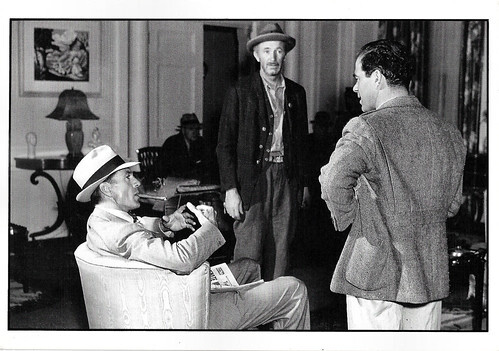
French postcard in the Entr'acte series by Éditions Asphodèle, Mâcon, no. 004/3. Collection: B. Courtel / D.R. Gary Cooper , Walter Brennan, and Frank Capra on the set of Meet John Doe (Frank Capra, 1940). Caption: Conference between Gary Cooper, Water Brennan and director Frank Capra.
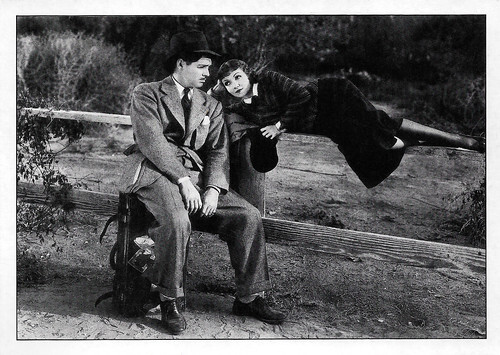
French postcard by Edition a la Carte. Photo: Filmhistorisches Bildarchiv Peter W. Engelmeier. Claudette Colbert and Clark Gable in It Happened One Night (Frank Capra, 1934).
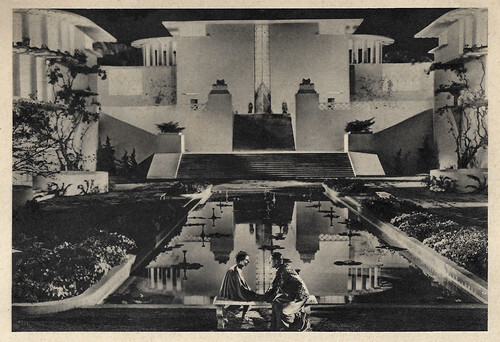
Italian postcard by Vecchioni & Guadagno, Roma. Photo: Columbia EIA. Ronald Colman and Jane Wyatt in Lost Horizon (Frank Capra, 1937). The Italian title was orizzonte perduto.
Developing into a comedy specialist
Francesco Rosario ‘Frank’ Capra was born in 1897 in Bisacquino, a village near Palermo in Sicily, Italy. He was the youngest of seven - surviving - children of the fruit picker Salvatore Capra and his wife Rosaria ‘Sara’ née Nicolosi. In 1903, his family moved with to Los Angeles, California, when he was five years old. The family had to spend the thirteen-day voyage across the Atlantic in cheap steerage because of a lack of money, and Capra later described the misery there as one of his worst life experiences.
His father worked as a fruit picker, as he had done in Italy. While attending school, Frank had to earn money on the side as a paperboy for ten years. Capra finished high school after ten years and studied chemical engineering at the Throop Institute, later the California Institute for Technology. During World War I, he served in the army, but contracted Spanish flu and was discharged.
After the war, he began working as an extra in films, after which he gained experience editing and directing short films. At the age of 24, Capra made the 32-minute documentary La Visita Dell'Incrociatore Italiano Libya a San Francisco. It documents the visit of the Italian naval vessel Libya to San Francisco and the reception given to the ship's crew by San Francisco's L'Italia Virtus Club. This was his first contact with film, although the short documentary did not bring him any attention or success.
In 1923, he married Helen Howell. The following year, he was hired by Hal Roach as a screenwriter for Our Gang films. Capra wanted to be a director, but Roach refused, after which Capra resigned. He started working for Mack Sennett in 1925. Sennett had him write screenplays for films starring Harry Langdon. Langdon's comic character was characterised by boundless slowness, naivety and innocence, which is why he was usually unable to cope with the big, hard world. Capra, who was developing into a comedy specialist, played a part in Langdon's rise to become one of Hollywood's most successful comedians in the mid-1920s. After Landon left Sennett and moved to First National to make feature films, Capora was also sacked by Sennett.
He was hired as a gag writer by Harry Langdon, working on Langdon's first First National feature-length film, Tramp, Tramp, Tramp (Harry Edwards, 1926). It did well at the box office, but the film had run over budget, and director Harry Edwards was sacked. For his next picture, The Strong Man (Frank Capra, 1926), Langdon promoted Capra to director, boosting his salary to $750 per week. The film was a hit, but trouble was brewing because Langdon was increasingly believing his own press. Langdon was compared to Charlie Chaplin , Harold Lloyd and Buster Keaton . After the shooting of Long Pants (Frank Capra, 1927), Capra and Langdon had a falling out and the successful duo parted ways. Capra made another silent comedy film for First National, For the Love of Mike (Frank Capra, 1927), about three bickering godfathers—a German, a Jew, and an Irishman — in which Claudette Colbert , who was still virtually unknown at the time, also had a role. This now-lost film was met with poor reviews and Capra did not receive another contract with First National.
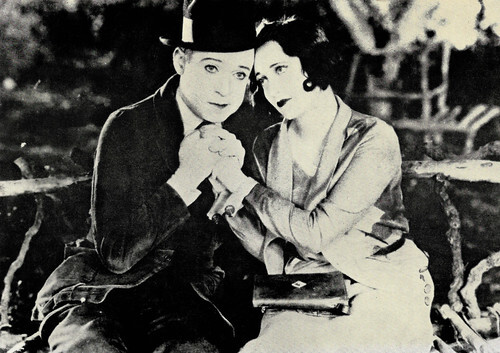
French postcard by François Nugeron, Paris. Photo: Collection Snark. Harry Langdon and Joan Crawford in Tramp, Tramp, Tramp (Harry Edwards, 1926), based on a screenplay by Frank Capra. The French film title was Plein des bottes.
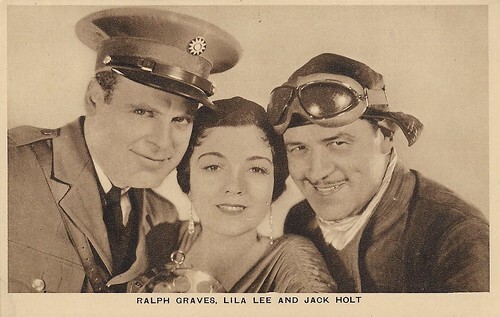
Vintage collectors card. Photo: Columbia. Jack Holt , Lila Lee and Ralph Graves in Flight (Frank Capra, 1929).
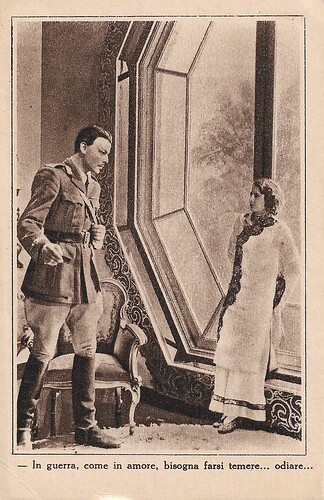
Italian postcard by S.A. Arte della Stampa, Roma. Photo: Columbia. Nils Asther and Barbara Stanwyck in The Bitter Tea of General Yen (Frank Capra, 1933). Caption: In war, as in love, you need to be feared... hated... The card wears an ink stamp for the Cinema Italia in Genoa. The Italian release title was L'amaro tè del generale Yen.
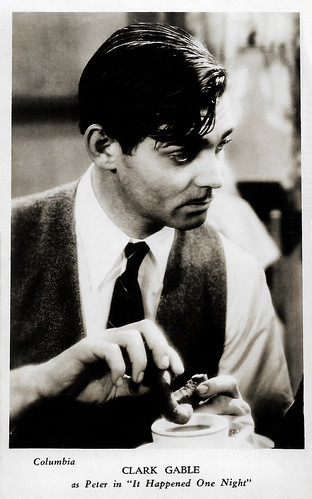
British postcard. Photo: Columbia. Clark Gable as Peter in It Happened One Night (Frank Capra, 1934).
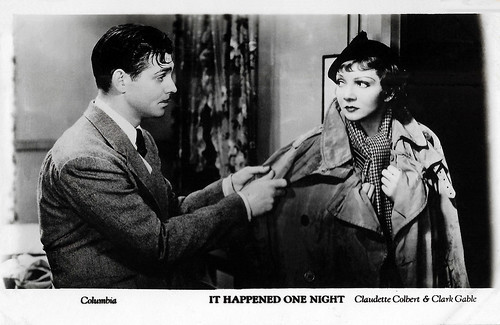
British postcard in the Film Shots Series by Film Weekly. Photo: Columbia. Clark Gable and Claudette Colbert in It Happened One Night (Frank Capra, 1934).
Capra's name above the title
In 1928, Frank Capra was hired by producer Harry Cohn to help his film studio Columbia Pictures produce new, full-length feature films, to compete with the major studios. At the time, Columbia was one of the so-called Poverty Row film studios in Hollywood, but Columbia wanted to gain in importance and size and catch up. Capra made a total of twenty films for Columbia Pictures, nine of them in his first year. Most of Capra's nine films in 1928 turned out to be very successful, so Cohn increased his salary from USD 1,000 per film to an annual salary of USD 25,000. Cohn also put Capra's name above the title of his films, a first for the movie industry. Capra's first sound film was the drama The Younger Generation (Frank Capra, 1929), a part-talkie starring Ricardo Cortez . In this drama, Cortez plays the son of a Jewish family in New York who denies his Jewish roots to remain in favour with his girlfriend. At the end of the 1920s, sound film arrived in Hollywood. Capra welcomed this. In the production of his first sound films, his engineering studies were an advantage. He quickly became accustomed to the technical innovations of sound film.
He started to work with cameraman Joseph Walker and they worked together on a total of 18 films, Capra also regularly hired screenwriter Robert Riskin who wrote the witty and sharp dialogue in many of Capra's films. The two became Hollywood's most acclaimed director/writer team. After notable successes such as the adventure film Flight (Frank Capra, 1931) and above all the comedy Platinum Blonde (Frank Capra, 1931), which significantly advanced Jean Harlow 's career, Capra made the comedy Lady for a Day (Frank Capra, 1933). The 75-year-old May Robson plays a poor apple seller who disguises herself as a lady. Despite the rather unusual leading actress, the film was nominated for four Oscars, including in the Best Director category for Capra. Although he did not win, Lady for a Day is considered Capra's first big hit, and it was also Columbia's first film to be nominated for an Oscar for Best Film.
The following year saw his first major milestone. The romantic comedy It Happened One Night (1934), starring Clark Gable and Claudette Colbert , was a huge success. It Happened One Night was the first film to win the five major Oscars, namely Best Picture, Best Direction (for Capra), Best Male Lead (for Gable), Best Female Lead (for Colbert) and Best Screenplay (for Riskin). Claudette Colbert plays a spoilt millionaire heiress who flees from her father to a snobbish lover. Along the way, she gets to know the misery of ordinary people in the Great Depression but also falls in love with a down-to-earth reporter ( Clark Gable ). Despite this actual comic plot, Capra also shows the problems of the average American citizen during the Great Depression. It Happened One Night is now regarded as the founding film of the screwball comedy par excellence and propelled Columbia Pictures into the ranks of the major Hollywood studios.
In the following years, Frank Capra made a series of comedies, such as Mr Deeds Goes to Town (1936), Lost Horizon (1937), You Can't Take It with You (1938) and Mr Smith Goes to Washington (1939). All these films were nominated for several Oscars, including for Best Picture. Many of these films were about ‘the little man who fought against the system’. In Mr Deeds Goes to Town (Frank Capra, 1936), Gary Cooper plays a fortune-card poet, a kindly, naïve country bumpkin who inherits a million-dollar fortune. He does a lot of good with his money before his money-grubbing and fraudulent lawyers try to declare him insane. Capra won his second Oscar for Best Director for Mr Deeds Goes to Town. The adventure film Lost Horizon (Frank Capra, 1937) with Ronald Colman , was based on a utopian novel by James Hilton. Lost Horizon differed from Capra's previous films and was shot for the then-high sum of 1.5 million US dollars. The film was set in an exotic, beautifully utopian valley in the Himalayas and the film's sets were therefore extremely elaborate.
On 5 May 1936, Capra, now the highest-paid director in Hollywood, hosted the 1936 Academy Awards. Capra was honoured with his third Oscar for Best Director in five years for the comedy You Can’t Take It With You (Frank Capra, 1938), which also won the Oscar for Best Film of the Year. Jean Arthur and James Stewart star as a pair of young lovers whose very different families - one of tough businessmen, the other of alternative eccentrics - get to know each other. Capra also cast Stewart in many of his later films. In 1939, Capra made one of his best-known films, the political satire Mr Smith Goes to Washington (Frank Capra, 1939), again starring Arthur and Stewart. Capra made Stewart a Hollywood star with his films. In Mr Smith Goes to Washington (1939), Capra's patriotism is evident, showing the individual in the democratic system fighting against rampant corruption in politics. Upon its release, the film was popular with critics and audiences, but the US ambassador to Great Britain at the time, Joseph P. Kennedy, asked Columbia boss Harry Cohn that the film should not be shown in Europe. Capra and Cohn ignored the criticism.
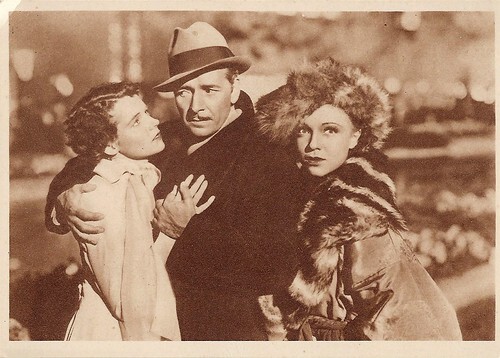
Italian postcard by Vecchioni & Guadagno, Roma. Photo: Columbia EIA. Ronald Colman , Jane Wyatt and Margo in Lost Horizon (Frank Capra, 1937). Art director Stephen Goosson won an Academy Award in 1938 for this film. The convent of Shangri-La was built in Streamline Moderne style at the Columbia lot in Burbank.
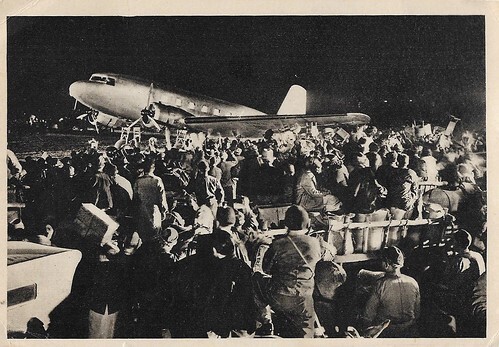
Italian postcard by Vecchioni & Guadagno, Roma. Photo: Columbia EIA. Still from Lost Horizon (Frank Capra, 1937). Art director Stephen Goosson won an Academy Award in 1938 for this film.
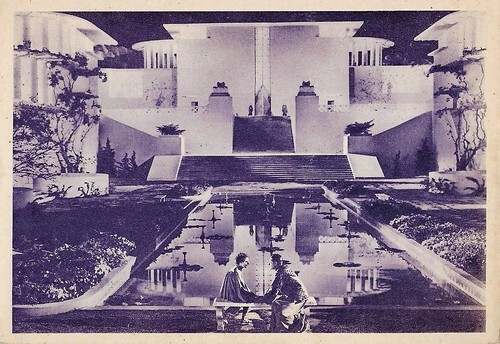
Italian postcard by Vecchioni & Guadagno, Roma. Photo: Columbia EIA. Ronald Colman and Jane Wyatt in Lost Horizon (Frank Capra, 1937).
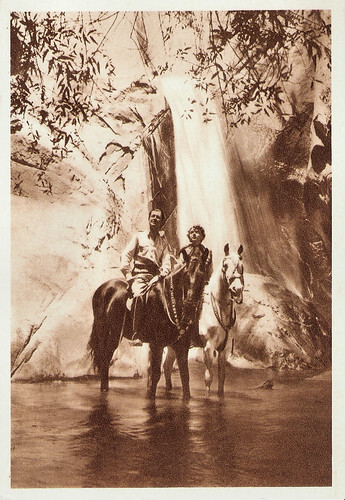
Italian postcard by Vecchioni & Guadagno, Roma. Photo: Columbia EIA. Ronald Colman and Jane Wyatt in Lost Horizon (Frank Capra, 1937).
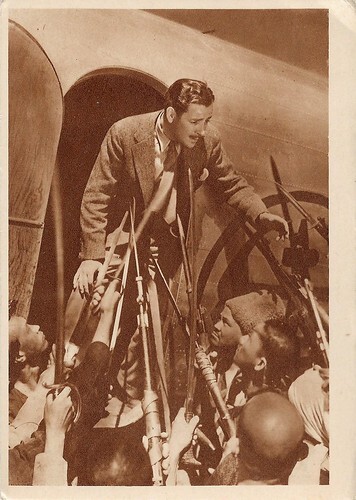
Italian postcard by Vecchioni & Guadagno, Roma. Photo: Columbia EIA. Ronald Colman in Lost Horizon (Frank Capra, 1937).
Why we fight
Frank Capra left Columbia and made his next two films at Warner Bros. His first film there was Meet John Doe (Frank Capra, 1941). Gary Cooper plays a former baseball player who wanders the country without work or money before he is proclaimed "John Doe" by news reporters and mutates into a hero of the masses. Released shortly before the USA entered the Second World War, Meet John Doe again shows patriotic traits. Also, the film contains a message against fascism: an unscrupulous and obviously fascist industrialist with dictatorial intentions uses John Doe for his own purposes and wants to become president.
Capra also made the comedy Arsenic and Old Lace with Cary Grant , which was not released until 1944. The black comedy then received excellent reviews and was also successful with audiences. Just four days after the attack on Pearl Harbor on 7 December 1941, Capra joined the US Army with the rank of major and gave up his Hollywood career for the time being.
Over the next few years, he was involved in shooting numerous war documentaries for America in the service of the United States Army Pictorial Service. His seven-part, award-winning documentary series Why We Fight (1942-1945) explained why the US soldiers went to war for their country and their goals. For the first film in the series, Prelude to War (1942), Capra received an Oscar. Capra saw the series as a response to Leni Riefenstahl's Nazi propaganda film Triumph des Willens/Triumph of the Will (1935) and it was a great success.
With Walt Disney 's help, he also produced a total of 28 three- to five-minute black-and-white cartoons about ‘Private Snafu’, which were used for educational purposes in the armed forces. Colonel Frank Capra was awarded the Army Distinguished Service Medal. After the war, he started Liberty Pictures with William Wyler and George Stevens. His best-known film, the Christmas classic It's a Wonderful Life (Frank Capra, 1946) with James Stewart and Donna Reed , was a big flop in cinemas, but later found its audience on television. Except for It's a Wonderful Life, other post-war films could not reach the level of his pre-war films, and the filmmaker struggled to reach new audiences. In 1961, he made his last film, Pocketful of Miracles (Frank Capra, 1961) with Glenn Ford and Bette Davis . In 1971, he published his autobiography ‘The Name Above the Title’. He was also involved in documentaries.
In 1991, Frank Capra died in his sleep of a heart attack in La Quinta, California. He was 94 years old. He was interred at Coachella Valley Public Cemetery in Coachella, California. Capra married the actress Helen Howell in 1923 and they divorced in 1928. In the same year, he married Lucille Warner. The marriage, which ended in 1984 with Warner's death, produced one daughter and three sons - one son died as an infant. Another son was the film producer Frank Capra Junior, whose son is the assistant director Frank Capra III. Frank Capra was nominated six times for the Oscar for Best Direction, eventually winning it three times, for It Happened One Night (in 1935), Mr Deeds Goes to Town (in 1937) and You Can't Take It with You (in 1939). For the first and last, he also won the Academy Award for Best Picture. In 1947, he won a Golden Globe for directing It's a Wonderful Life.
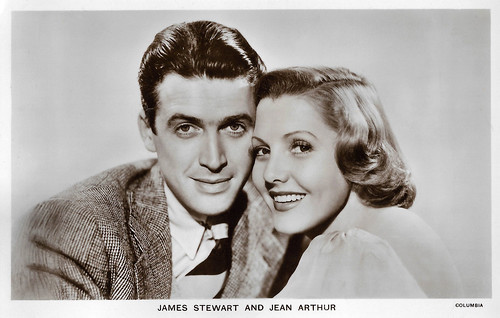
British postcard in the Film Partners Series, London, no. P 265. Photo: Columbia. James Stewart and Jean Arthur in You Can't Take It with You (Frank Capra, 1938).
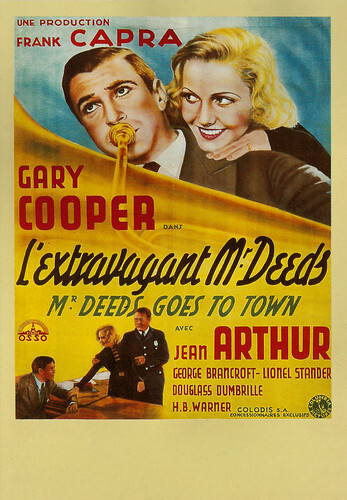
French postcard in the Collection Télérama, la mémoire du cinéma, no. 128 by Editions Zreik, Paris. Image: French affiche by Osso for Mr. Deeds Goes To Town (Frank Capra, 1936). The French film title was L'extravagant Mr. Deeds.
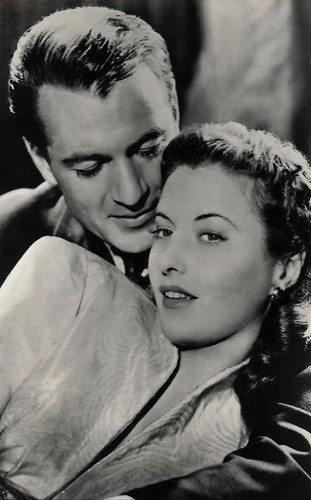
Spanish postcard by SOBE, no. 499. Sent by mail in 1949. Photo: Barbara Stanwyck and Gary Cooper in Meet John Doe (Frank Capra, 1941).
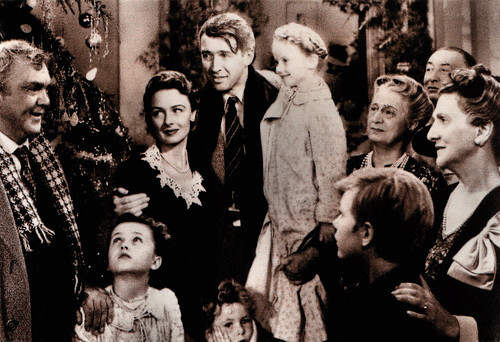
American postcard in The Ludlow Collection by Classico San Francisco, no. 136-308. James Stewart , Donna Reed , Beulah Bondi, Carol Coombs, Karolyn Grimes and Thomas Mitchell in It's a Wonderful Life (Frank Capra, 1946).
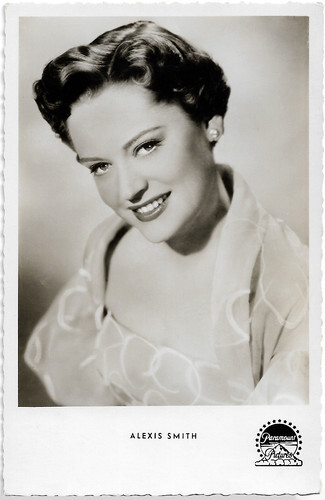
West German postcard by Kunst und Bild, Berlin W., no. A 362. Photo: Paramount. Alexis Smith in Here Comes the Groom (Frank Capra, 1951).
Sources: (IMDb), Wikipedia (Dutch, German and English) and .

French postcard in the Entr'acte series by Éditions Asphodèle, Mâcon, no. 004/3. Collection: B. Courtel / D.R. Gary Cooper , Walter Brennan, and Frank Capra on the set of Meet John Doe (Frank Capra, 1940). Caption: Conference between Gary Cooper, Water Brennan and director Frank Capra.

French postcard by Edition a la Carte. Photo: Filmhistorisches Bildarchiv Peter W. Engelmeier. Claudette Colbert and Clark Gable in It Happened One Night (Frank Capra, 1934).

Italian postcard by Vecchioni & Guadagno, Roma. Photo: Columbia EIA. Ronald Colman and Jane Wyatt in Lost Horizon (Frank Capra, 1937). The Italian title was orizzonte perduto.
Developing into a comedy specialist
Francesco Rosario ‘Frank’ Capra was born in 1897 in Bisacquino, a village near Palermo in Sicily, Italy. He was the youngest of seven - surviving - children of the fruit picker Salvatore Capra and his wife Rosaria ‘Sara’ née Nicolosi. In 1903, his family moved with to Los Angeles, California, when he was five years old. The family had to spend the thirteen-day voyage across the Atlantic in cheap steerage because of a lack of money, and Capra later described the misery there as one of his worst life experiences.
His father worked as a fruit picker, as he had done in Italy. While attending school, Frank had to earn money on the side as a paperboy for ten years. Capra finished high school after ten years and studied chemical engineering at the Throop Institute, later the California Institute for Technology. During World War I, he served in the army, but contracted Spanish flu and was discharged.
After the war, he began working as an extra in films, after which he gained experience editing and directing short films. At the age of 24, Capra made the 32-minute documentary La Visita Dell'Incrociatore Italiano Libya a San Francisco. It documents the visit of the Italian naval vessel Libya to San Francisco and the reception given to the ship's crew by San Francisco's L'Italia Virtus Club. This was his first contact with film, although the short documentary did not bring him any attention or success.
In 1923, he married Helen Howell. The following year, he was hired by Hal Roach as a screenwriter for Our Gang films. Capra wanted to be a director, but Roach refused, after which Capra resigned. He started working for Mack Sennett in 1925. Sennett had him write screenplays for films starring Harry Langdon. Langdon's comic character was characterised by boundless slowness, naivety and innocence, which is why he was usually unable to cope with the big, hard world. Capra, who was developing into a comedy specialist, played a part in Langdon's rise to become one of Hollywood's most successful comedians in the mid-1920s. After Landon left Sennett and moved to First National to make feature films, Capora was also sacked by Sennett.
He was hired as a gag writer by Harry Langdon, working on Langdon's first First National feature-length film, Tramp, Tramp, Tramp (Harry Edwards, 1926). It did well at the box office, but the film had run over budget, and director Harry Edwards was sacked. For his next picture, The Strong Man (Frank Capra, 1926), Langdon promoted Capra to director, boosting his salary to $750 per week. The film was a hit, but trouble was brewing because Langdon was increasingly believing his own press. Langdon was compared to Charlie Chaplin , Harold Lloyd and Buster Keaton . After the shooting of Long Pants (Frank Capra, 1927), Capra and Langdon had a falling out and the successful duo parted ways. Capra made another silent comedy film for First National, For the Love of Mike (Frank Capra, 1927), about three bickering godfathers—a German, a Jew, and an Irishman — in which Claudette Colbert , who was still virtually unknown at the time, also had a role. This now-lost film was met with poor reviews and Capra did not receive another contract with First National.

French postcard by François Nugeron, Paris. Photo: Collection Snark. Harry Langdon and Joan Crawford in Tramp, Tramp, Tramp (Harry Edwards, 1926), based on a screenplay by Frank Capra. The French film title was Plein des bottes.

Vintage collectors card. Photo: Columbia. Jack Holt , Lila Lee and Ralph Graves in Flight (Frank Capra, 1929).

Italian postcard by S.A. Arte della Stampa, Roma. Photo: Columbia. Nils Asther and Barbara Stanwyck in The Bitter Tea of General Yen (Frank Capra, 1933). Caption: In war, as in love, you need to be feared... hated... The card wears an ink stamp for the Cinema Italia in Genoa. The Italian release title was L'amaro tè del generale Yen.

British postcard. Photo: Columbia. Clark Gable as Peter in It Happened One Night (Frank Capra, 1934).

British postcard in the Film Shots Series by Film Weekly. Photo: Columbia. Clark Gable and Claudette Colbert in It Happened One Night (Frank Capra, 1934).
Capra's name above the title
In 1928, Frank Capra was hired by producer Harry Cohn to help his film studio Columbia Pictures produce new, full-length feature films, to compete with the major studios. At the time, Columbia was one of the so-called Poverty Row film studios in Hollywood, but Columbia wanted to gain in importance and size and catch up. Capra made a total of twenty films for Columbia Pictures, nine of them in his first year. Most of Capra's nine films in 1928 turned out to be very successful, so Cohn increased his salary from USD 1,000 per film to an annual salary of USD 25,000. Cohn also put Capra's name above the title of his films, a first for the movie industry. Capra's first sound film was the drama The Younger Generation (Frank Capra, 1929), a part-talkie starring Ricardo Cortez . In this drama, Cortez plays the son of a Jewish family in New York who denies his Jewish roots to remain in favour with his girlfriend. At the end of the 1920s, sound film arrived in Hollywood. Capra welcomed this. In the production of his first sound films, his engineering studies were an advantage. He quickly became accustomed to the technical innovations of sound film.
He started to work with cameraman Joseph Walker and they worked together on a total of 18 films, Capra also regularly hired screenwriter Robert Riskin who wrote the witty and sharp dialogue in many of Capra's films. The two became Hollywood's most acclaimed director/writer team. After notable successes such as the adventure film Flight (Frank Capra, 1931) and above all the comedy Platinum Blonde (Frank Capra, 1931), which significantly advanced Jean Harlow 's career, Capra made the comedy Lady for a Day (Frank Capra, 1933). The 75-year-old May Robson plays a poor apple seller who disguises herself as a lady. Despite the rather unusual leading actress, the film was nominated for four Oscars, including in the Best Director category for Capra. Although he did not win, Lady for a Day is considered Capra's first big hit, and it was also Columbia's first film to be nominated for an Oscar for Best Film.
The following year saw his first major milestone. The romantic comedy It Happened One Night (1934), starring Clark Gable and Claudette Colbert , was a huge success. It Happened One Night was the first film to win the five major Oscars, namely Best Picture, Best Direction (for Capra), Best Male Lead (for Gable), Best Female Lead (for Colbert) and Best Screenplay (for Riskin). Claudette Colbert plays a spoilt millionaire heiress who flees from her father to a snobbish lover. Along the way, she gets to know the misery of ordinary people in the Great Depression but also falls in love with a down-to-earth reporter ( Clark Gable ). Despite this actual comic plot, Capra also shows the problems of the average American citizen during the Great Depression. It Happened One Night is now regarded as the founding film of the screwball comedy par excellence and propelled Columbia Pictures into the ranks of the major Hollywood studios.
In the following years, Frank Capra made a series of comedies, such as Mr Deeds Goes to Town (1936), Lost Horizon (1937), You Can't Take It with You (1938) and Mr Smith Goes to Washington (1939). All these films were nominated for several Oscars, including for Best Picture. Many of these films were about ‘the little man who fought against the system’. In Mr Deeds Goes to Town (Frank Capra, 1936), Gary Cooper plays a fortune-card poet, a kindly, naïve country bumpkin who inherits a million-dollar fortune. He does a lot of good with his money before his money-grubbing and fraudulent lawyers try to declare him insane. Capra won his second Oscar for Best Director for Mr Deeds Goes to Town. The adventure film Lost Horizon (Frank Capra, 1937) with Ronald Colman , was based on a utopian novel by James Hilton. Lost Horizon differed from Capra's previous films and was shot for the then-high sum of 1.5 million US dollars. The film was set in an exotic, beautifully utopian valley in the Himalayas and the film's sets were therefore extremely elaborate.
On 5 May 1936, Capra, now the highest-paid director in Hollywood, hosted the 1936 Academy Awards. Capra was honoured with his third Oscar for Best Director in five years for the comedy You Can’t Take It With You (Frank Capra, 1938), which also won the Oscar for Best Film of the Year. Jean Arthur and James Stewart star as a pair of young lovers whose very different families - one of tough businessmen, the other of alternative eccentrics - get to know each other. Capra also cast Stewart in many of his later films. In 1939, Capra made one of his best-known films, the political satire Mr Smith Goes to Washington (Frank Capra, 1939), again starring Arthur and Stewart. Capra made Stewart a Hollywood star with his films. In Mr Smith Goes to Washington (1939), Capra's patriotism is evident, showing the individual in the democratic system fighting against rampant corruption in politics. Upon its release, the film was popular with critics and audiences, but the US ambassador to Great Britain at the time, Joseph P. Kennedy, asked Columbia boss Harry Cohn that the film should not be shown in Europe. Capra and Cohn ignored the criticism.

Italian postcard by Vecchioni & Guadagno, Roma. Photo: Columbia EIA. Ronald Colman , Jane Wyatt and Margo in Lost Horizon (Frank Capra, 1937). Art director Stephen Goosson won an Academy Award in 1938 for this film. The convent of Shangri-La was built in Streamline Moderne style at the Columbia lot in Burbank.

Italian postcard by Vecchioni & Guadagno, Roma. Photo: Columbia EIA. Still from Lost Horizon (Frank Capra, 1937). Art director Stephen Goosson won an Academy Award in 1938 for this film.

Italian postcard by Vecchioni & Guadagno, Roma. Photo: Columbia EIA. Ronald Colman and Jane Wyatt in Lost Horizon (Frank Capra, 1937).

Italian postcard by Vecchioni & Guadagno, Roma. Photo: Columbia EIA. Ronald Colman and Jane Wyatt in Lost Horizon (Frank Capra, 1937).

Italian postcard by Vecchioni & Guadagno, Roma. Photo: Columbia EIA. Ronald Colman in Lost Horizon (Frank Capra, 1937).
Why we fight
Frank Capra left Columbia and made his next two films at Warner Bros. His first film there was Meet John Doe (Frank Capra, 1941). Gary Cooper plays a former baseball player who wanders the country without work or money before he is proclaimed "John Doe" by news reporters and mutates into a hero of the masses. Released shortly before the USA entered the Second World War, Meet John Doe again shows patriotic traits. Also, the film contains a message against fascism: an unscrupulous and obviously fascist industrialist with dictatorial intentions uses John Doe for his own purposes and wants to become president.
Capra also made the comedy Arsenic and Old Lace with Cary Grant , which was not released until 1944. The black comedy then received excellent reviews and was also successful with audiences. Just four days after the attack on Pearl Harbor on 7 December 1941, Capra joined the US Army with the rank of major and gave up his Hollywood career for the time being.
Over the next few years, he was involved in shooting numerous war documentaries for America in the service of the United States Army Pictorial Service. His seven-part, award-winning documentary series Why We Fight (1942-1945) explained why the US soldiers went to war for their country and their goals. For the first film in the series, Prelude to War (1942), Capra received an Oscar. Capra saw the series as a response to Leni Riefenstahl's Nazi propaganda film Triumph des Willens/Triumph of the Will (1935) and it was a great success.
With Walt Disney 's help, he also produced a total of 28 three- to five-minute black-and-white cartoons about ‘Private Snafu’, which were used for educational purposes in the armed forces. Colonel Frank Capra was awarded the Army Distinguished Service Medal. After the war, he started Liberty Pictures with William Wyler and George Stevens. His best-known film, the Christmas classic It's a Wonderful Life (Frank Capra, 1946) with James Stewart and Donna Reed , was a big flop in cinemas, but later found its audience on television. Except for It's a Wonderful Life, other post-war films could not reach the level of his pre-war films, and the filmmaker struggled to reach new audiences. In 1961, he made his last film, Pocketful of Miracles (Frank Capra, 1961) with Glenn Ford and Bette Davis . In 1971, he published his autobiography ‘The Name Above the Title’. He was also involved in documentaries.
In 1991, Frank Capra died in his sleep of a heart attack in La Quinta, California. He was 94 years old. He was interred at Coachella Valley Public Cemetery in Coachella, California. Capra married the actress Helen Howell in 1923 and they divorced in 1928. In the same year, he married Lucille Warner. The marriage, which ended in 1984 with Warner's death, produced one daughter and three sons - one son died as an infant. Another son was the film producer Frank Capra Junior, whose son is the assistant director Frank Capra III. Frank Capra was nominated six times for the Oscar for Best Direction, eventually winning it three times, for It Happened One Night (in 1935), Mr Deeds Goes to Town (in 1937) and You Can't Take It with You (in 1939). For the first and last, he also won the Academy Award for Best Picture. In 1947, he won a Golden Globe for directing It's a Wonderful Life.

British postcard in the Film Partners Series, London, no. P 265. Photo: Columbia. James Stewart and Jean Arthur in You Can't Take It with You (Frank Capra, 1938).

French postcard in the Collection Télérama, la mémoire du cinéma, no. 128 by Editions Zreik, Paris. Image: French affiche by Osso for Mr. Deeds Goes To Town (Frank Capra, 1936). The French film title was L'extravagant Mr. Deeds.

Spanish postcard by SOBE, no. 499. Sent by mail in 1949. Photo: Barbara Stanwyck and Gary Cooper in Meet John Doe (Frank Capra, 1941).

American postcard in The Ludlow Collection by Classico San Francisco, no. 136-308. James Stewart , Donna Reed , Beulah Bondi, Carol Coombs, Karolyn Grimes and Thomas Mitchell in It's a Wonderful Life (Frank Capra, 1946).

West German postcard by Kunst und Bild, Berlin W., no. A 362. Photo: Paramount. Alexis Smith in Here Comes the Groom (Frank Capra, 1951).
Sources: (IMDb), Wikipedia (Dutch, German and English) and .
Published on December 29, 2024 22:00
December 28, 2024
La Collectionneuse: Costume by Travis Banton
Hollywood costume designer Travis Banton was born in Waco, Texas, on 18 August 1894. He studied at the Arts Students League and the New York School of Fine and Applied Arts. He worked for movies for the first time when he designed part of Norma Talmadge’s wardrobe for Poppy (1917). After the War, he worked at the fashion houses of Lucile and Madame Frances. He designed Mary Pickford’s wedding dress when she married Douglas Fairbanks in 1920. In 1924, he signed with Paramount, where he became chief designer in 1929 when Howard Greer left. At the time, he dressed such stars as Clara Bow, Evelyn Brent, Anna May Wong, Carole Lombard, Claudette Colbert, Mae West, ...
However, the star Travis Banton is most associated with is Marlene Dietrich . The actress, who was once wittily described by Hitchcock as "a professional costume designer", closely collaborated with him to create an unforgettable glamourous image. Travis Banton knew that even the most extreme creations would look good on her. As Margaret J. Bailey, author of the book 'Those Glorious Glamour Years', wrote: "Garments outrageous on anyone else were carried routinely by Dietrich. No other actress could sustain the heavy glamour load several of her outfits conveyed".
Travis Banton stayed at Paramount until 1938. He then worked for 20th Century Fox (1939-1941) and for Universal (1945-1948). In the 1950s, he notably designed Rosalind Russell ’s costumes for the Broadway play 'Auntie Mame' (1956-1958). He passed away on 2 February 1958. Edith Head, who succeeded Travis Banton as head of the Paramount costume design department, allegedly said about him: "He was a marvellous designer. Any talent I might have would have lain undiscovered if he hadn’t lighted the way for me. In my opinion, he was the greatest."
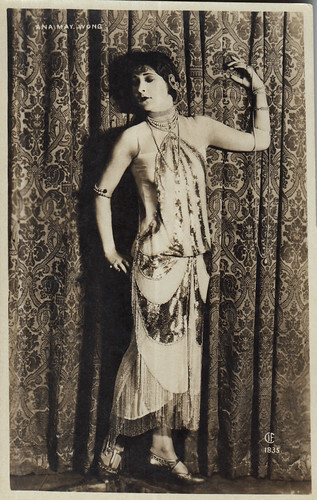
Mexican postcard by CIF, no. 1835. Thais Valdemar (wrongly captioned as Anna May Wong ) in The Dressmaker from Paris (Paul Bern, 1925).
At the time this dress was described as: "A tight-fitting gown of flesh colour silk, embroidered with pearls, diamonds and gold spangles, and edged with crystal fringes."
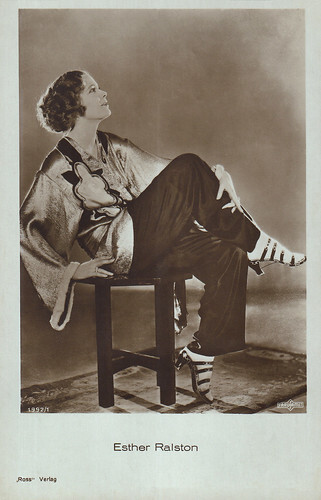
German postcard by Ross Verlag, no. 1992/1, 1927-1928. Photo: Parufamet. Esther Ralston in Fashions for Women (Dorothy Arzner, 1927).
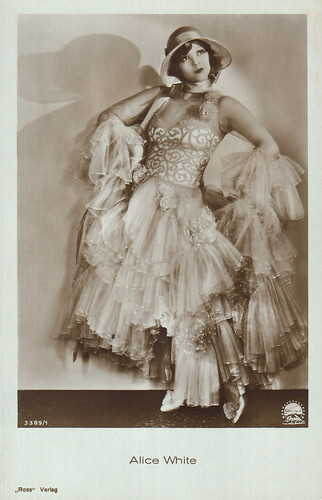
German postcard by Ross Verlag, no. 3389/1, 1928-1929. Photo: Paramount Pictures. Alice White in Gentlemen Prefer Blondes (Malcolm St. Clair, 1928).
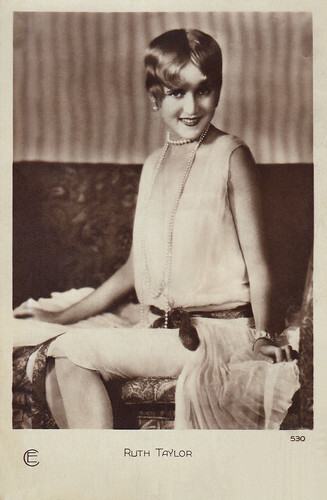
French postcard by Cinémagazine, Paris, no. 530. Ruth Taylor in Gentlemen Prefer Blondes (Malcolm St. Clair, 1928).
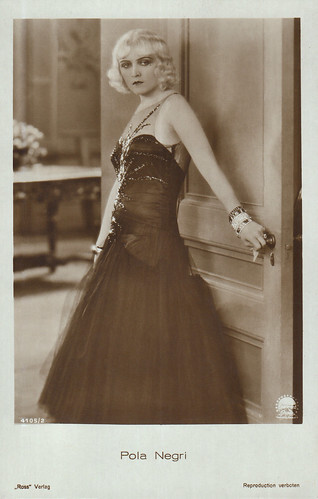
German postcard by Ross Verlag, no. 4105/2, 1929-1930. Photo: Paramount Pictures. Pola Negri in Three Sinners (Rowland V. Lee, 1928).
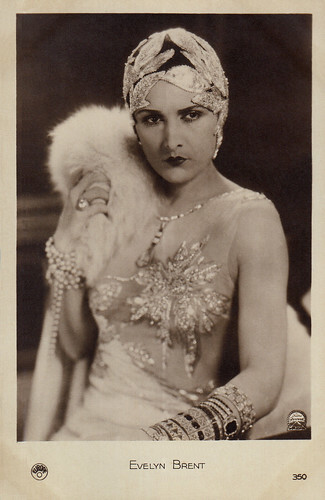
French postcard by Europe, no. 350. Photo: Paramount Pictures. Evelyn Brent in His Tiger Lady (Hobart Henley, 1928).
“The gown is worn over a silver tissue slip and is heavily embroidered with brilliants and crystal. It has large wing sleeves and bands of crystal fall from the brilliant fastening, in front. The turban of silver with which Miss Brent covers her hair adds the ultra chic touch to an elaborate costume.” (from an article published in December 1928 in the Australian Sunday Times).
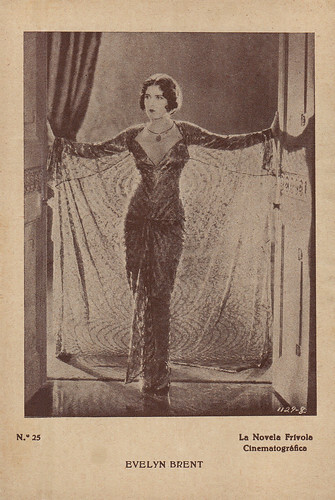
Spanish postcard by La Novela Frivola Cinematografica, no. 25. Evelyn Brent in His Tiger Lady (Hobart Henley, 1928).
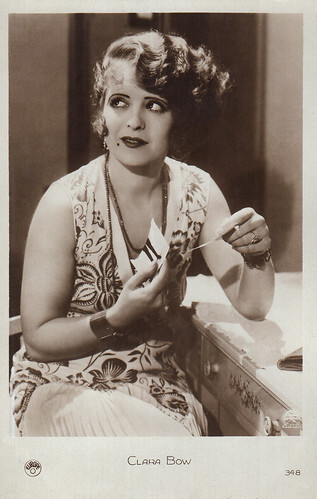
French postcard by Europe, no. 348. Clara Bow in The Fleet’s In (Malcolm St. Clair, 1929).
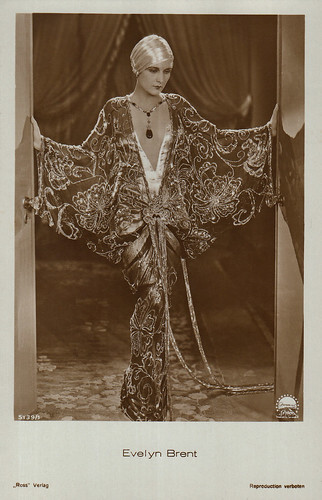
German postcard by Ross Verlag, no. 5139/1, 1930-1931. Photo: Paramount Pictures. Evelyn Brent on a publicity portrait for Interference (Lothar Mendes, Roy Pomeroy, 1928).
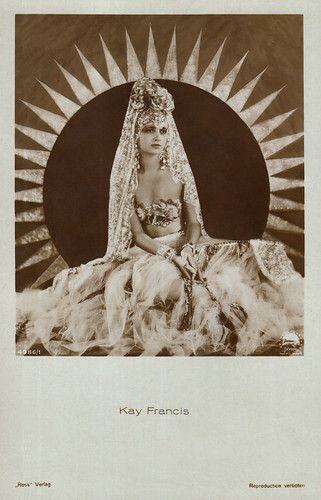
German postcard by Ross Verlag, no. 4986/1, 1929-1930. Photo: Paramount Pictures. Kay Francis in Behind the Make-Up (Robert Milton, 1930).
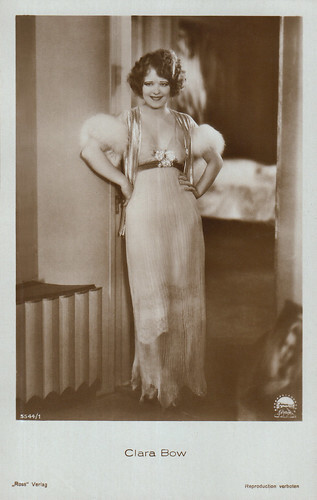
German postcard by Ross Verlag, no. 5544/1, 1930-1931. Photo: Paramount. Clara Bow in Her Wedding Night (Frank Tuttle, 1930).
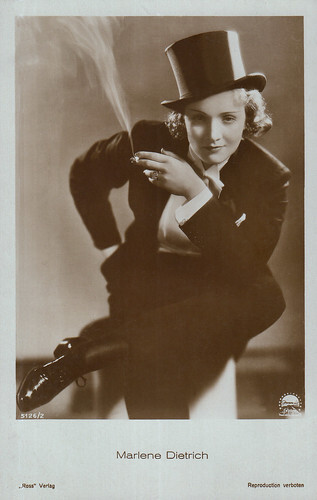
German postcard by Ross Verlag, no. 5126/2, 1930-1931. Photo: Paramount. Marlene Dietrich in Morocco (Josef von Sternberg, 1930).
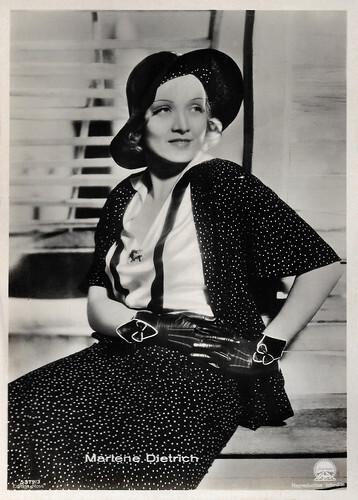
French postcard by Edition Ross, no. 5379/3, 1930-1931. Photo: Paramount. Marlene Dietrich in Morocco (Josef von Sternberg, 1930).
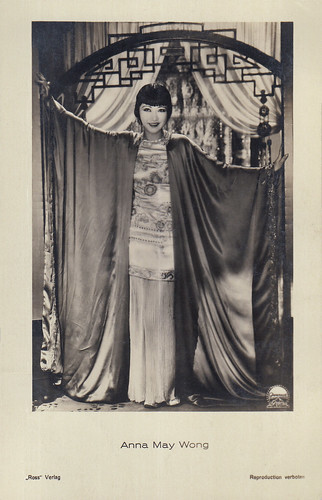
German postcard by Ross Verlag, no. 7227/1, 1932-1933. Photo: Paramount. Anna May Wong in Daughter of the Dragon (Lloyd Corrigan, 1931).
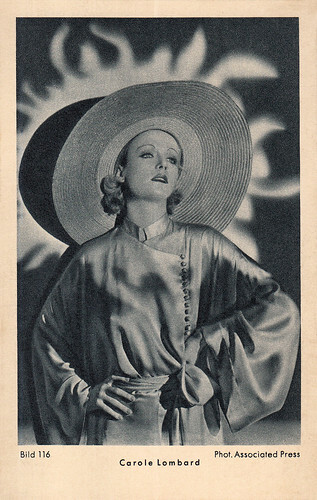
German postcard by Eidelsan, Serie II, Bild 116. Carole Lombard in No One Man (Lloyd Corrigan, 1932).
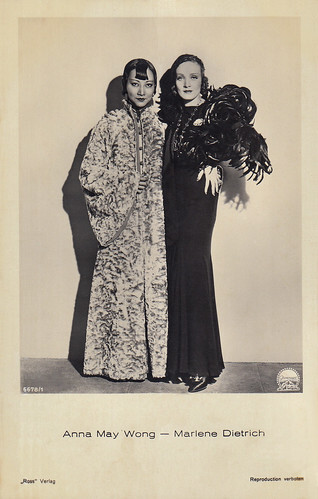
German postcard by Ross Verlag, no. 6678/1, 1931-1932. Marlene Dietrich and Anna May Wong in Shanghai Express (Josef von Sternberg, 1932).
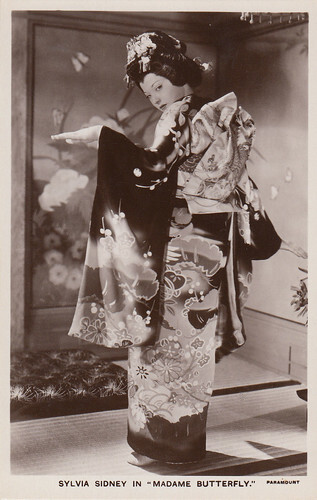
Dutch postcard by M. Bonnist & Zonen, Amsterdam, no. B226. Photo: Paramount. Sylvia Sidney , as the Japanese character Cho-Cho-San, in Madame Butterfly (Marion Gering, 1932).
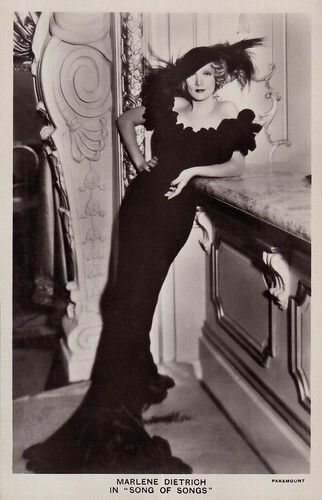
Dutch postcard by M. Bonnist & Zonen, Amsterdam, no. B251. Photo: Paramount. Marlene Dietrich in The Song of Songs (Rouben Mamoulian, 1933).
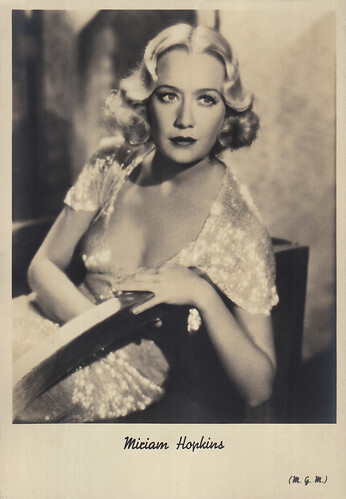
Italian postcard by Fotocelere, no. 15. Photo: M.G.M. Miriam Hopkins in Design for Living (Ernst Lubitsch, 1933).
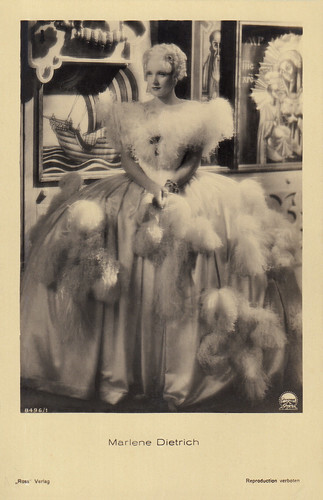
German postcard by Ross Verlag, no. 8496/1, 1933-1934. Photo: Paramount. Marlene Dietrich in The Scarlet Empress (Josef von Sternberg, 1934).
Travis Banton allegedly said about The Scarlett Empress: "Miss Dietrich’s costumes in that picture were expressive of the period’s fashions, without being mere stereotyped copies of sketches found in books. I placed myself mentally in the position of a designer of the middle eighteenth century".
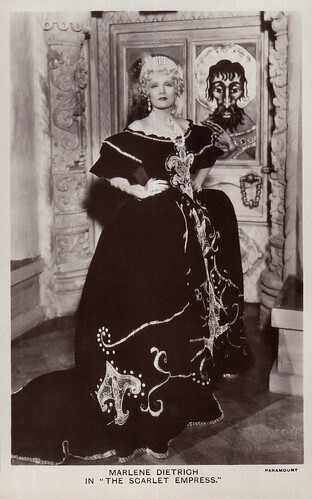
Dutch postcard by M. Bonnist & Zonen, Amsterdam, no. B350. Photo: Paramount. Marlene Dietrich in The Scarlett Empress (Josef von Sternberg, 1934).
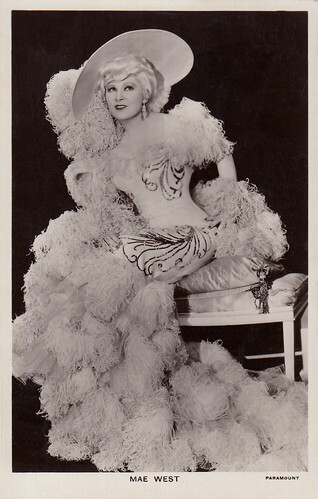
Dutch postcard by M. Bonnist & Zonen, Amsterdam, no. B367. Photo: Paramount. Mae West in Belle of the Nineties (Leo McCarey, 1934).
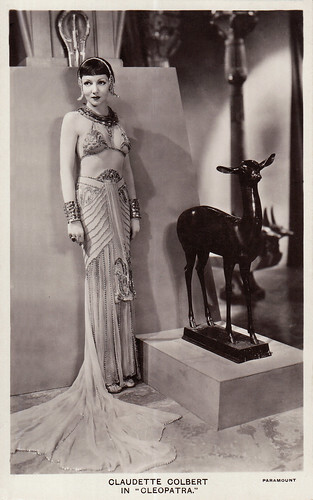
Dutch postcard by M. Bonnist & Zonen, Amsterdam, no. B363. Photo: Paramount. Claudette Colbert in Cleopatra (Cecil B. DeMille, 1934).
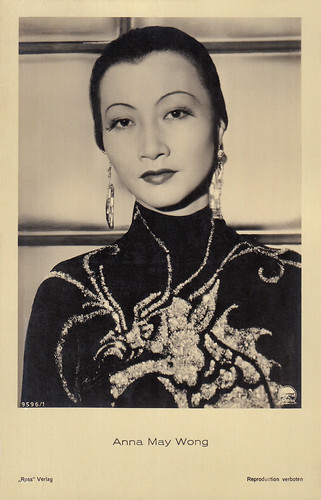
German postcard by Ross Verlag, no. 9596/1, 1935-1936. Photo: Paramount. Anna May Wong in Limehouse Blues (Alexander Hall, 1934).
According to the Costume Institute of the Metropolitan Museum of Art in New York, where the gown is now displayed: "The dragon motif adds a distinct Asian influence, dazzling in its execution in gold and silver sequins on luxurious satin."
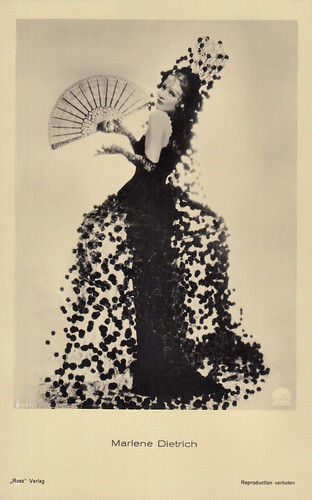
German postcard by Ross Verlag, no. 8991/1, 1933-1934. Photo: Paramount. Marlene Dietrich in The Devil Is a Woman (Josef von Sternberg, 1935).
Variety Magazine wrote: "Not even Garbo in the Orient has approached, for special effects, Dietrich in Spain. With fringe, lace, sequins, carnations, chenille, nets, embroideries, and shawls, Miss Dietrich is hung, wrapped, draped, swathed, and festooned. She emerges as a glorious achievement, a supreme consolidation of the sartorial, make-up, and photographic arts
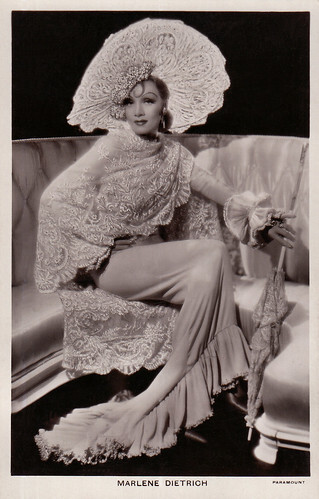
Dutch postcard by M. Bonnist & Zonen, Amsterdam, no. B395. Photo: Paramount. Marlene Dietrich in The Devil Is a Woman (Josef von Sternberg, 1935).
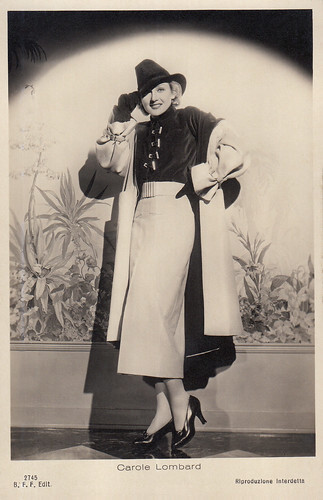
Italian postcard by Ballerini & Fratini, Firenze (B.F.F. Edit.), no. 2745. Carole Lombard .
On the back of a publicity portrait of Carole Lombard wearing this outfit, she is referred to as "Carole Lombard of Paramount’s Rumba". So, we can date it from about 1935, the year Rumba was released, although it seems that Lombard didn’t wear it in the movie. The caption for this ensemble was: "Lightweight beige tweed lined in burgundy corduroy carries out Travis Banton’s desire to create a costume equally appropriate for town or country wear".
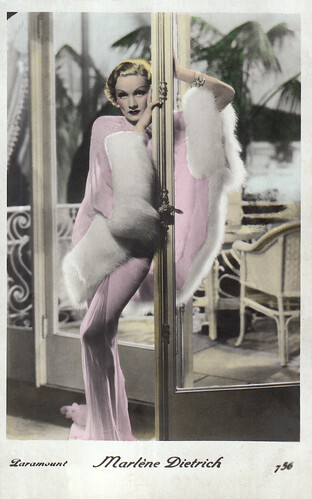
French postcard by Erpé, no. 756. Photo: Paramount. Marlene Dietrich in Desire (Frank Borzage, 1936).
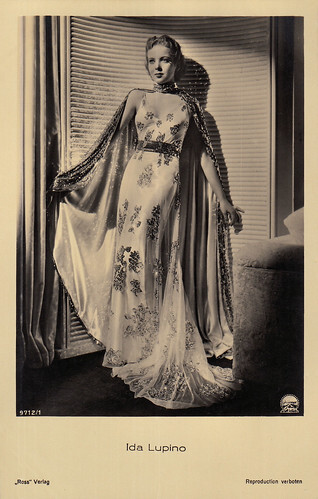
German postcard by Ross Verlag, no. 9712/1, 1935-1936. Photo: Paramount. Ida Lupino in Yours for the Asking (Alexander Hall, 1936).
This is how this outfit was then depicted on a publicity portrait: "White Souffle is the background of this formal gown. The embroidery is made of silver paillettes and corresponds to the long flowing cape which matches the girdle worn at the tightly fitted waist".
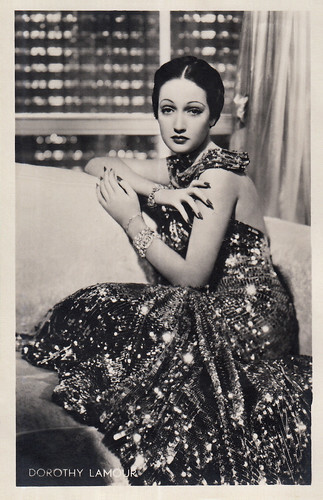
Dutch postcard. Dorothy Lamour in Swing High, Swing Low (Mitchell Leisen, 1937).
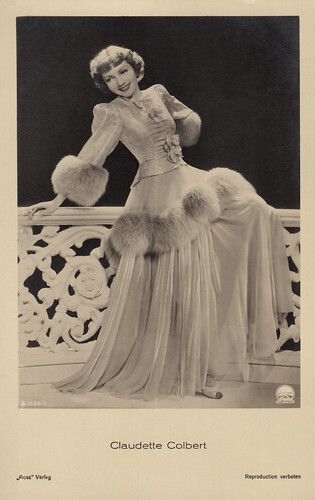
German postcard by Ross Verlag, no. A1138/1, 1937-1938. Photo: Paramount. Claudette Colbert in I Met Him in Paris (Wesley Ruggles, 1937).
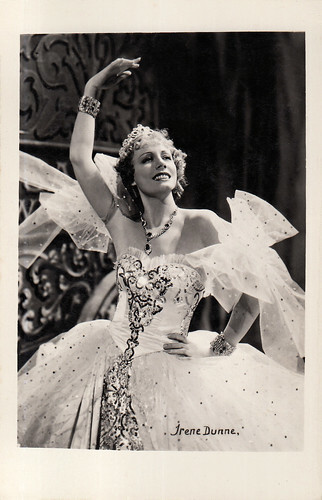
Postcard from the Dutch East Indies (now Indonesia). Irene Dunne in High, Wide and Handsome (Rouben Mamoulian, 1937).
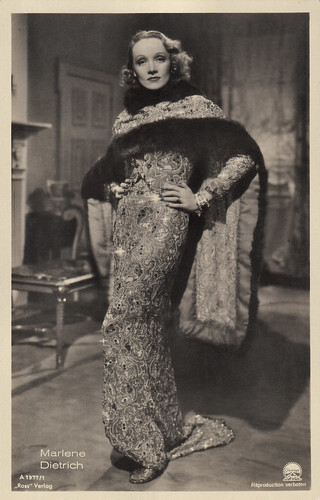
German postcard by Ross Verlag, no. A 1977/1, 1937-1938. Photo: Paramount. Marlene Dietrich in Angel (Ernst Lubitsch, 1937).
This is allegedly the most expensive gown Travis Banton ever designed. "It’s a three-piece jewel-encrusted evening gown consisting of a fitted bodice with three-quarter sleeves; full-length skirt with train and matching stole trimmed with sable. The garment is solidly embroidered in a paisley motif with gold crystal caviar beads, seed pearls, gold sequins, small rhinestones, gold bullion thread and paste rubies and emeralds". (Description from The Collection of Motion Picture Costume Design).Travis Banton once declared about it: "It was simple in lines, of Persian design, and looked like a piece of woven jewellery. A score of embroiderers worked on it for two and a half weeks".
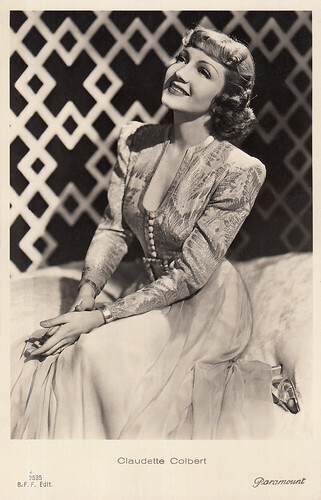
Italian postcard by Ballerini & Fratini, Firenze, no. 2535. Photo: Paramount. Claudette Colbert in Bluebeard’s Eight Wife (Ernst Lubitsch, 1938).
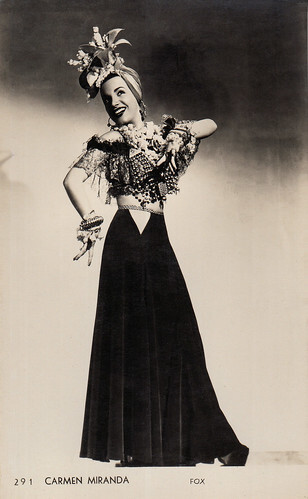
Spanish postcard, no. 291. Photo: Fox. Carmen Miranda in Down Argentine Way (Irving Cummings, 1940).
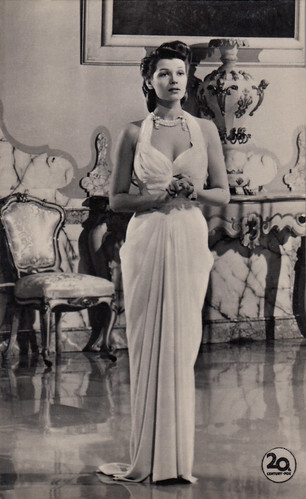
Spanish postcard by Sobe, no. 475. Photo: 20th Century Fox. Rita Hayworth in Blood and Sand (Rouben Mamoulian, 1941).
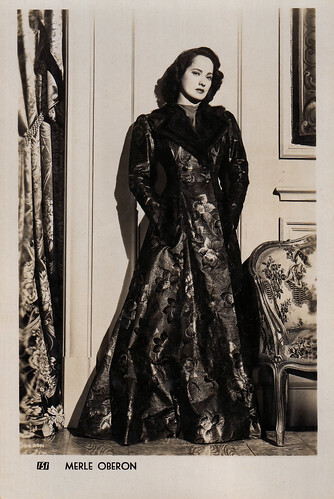
Spanish postcard no. 151. Merle Oberon in A Song to Remember (Charles Vidor, 1945).
Merle Oberon once said about Travis Banton: "He not only knew what the character ought to look like but also understood what an actress was the happiest wearing, which is very rare for a costume designer. As a result, I never found it necessary to make a single change on any of his drawings".
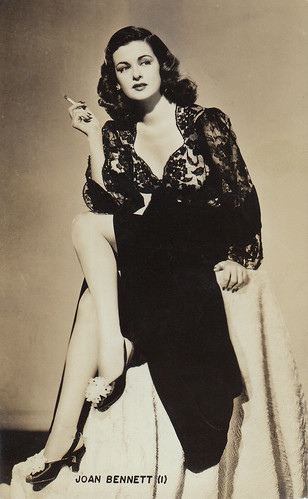
Vintage postcard. Joan Bennett in Scarlet Street (Fritz Lang, 1945).
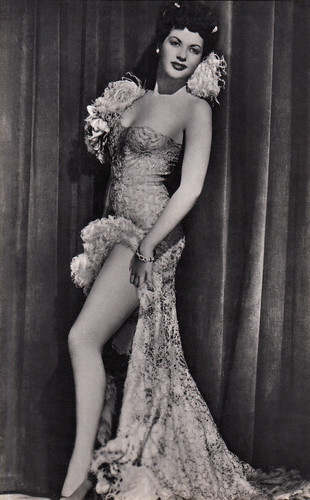
Spanish postcard, no. 3057. Yvonne De Carlo in Frontier Gal (Charles Lamont, 1945).
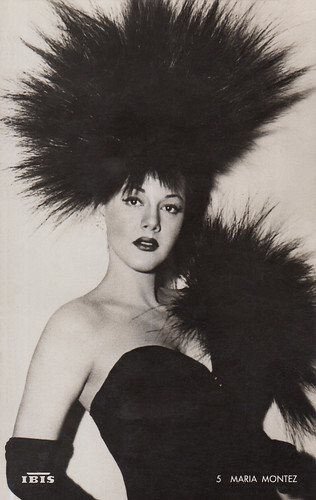
Spanish postcard by Ibis, no. 5. Maria Montez in Tangier (George Waggner, 1946).
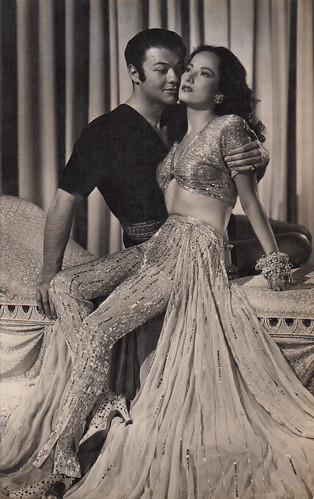
Spanish postcard by Archivo Bermejo, Barcelona. Merle Oberon and Turhan Bey in Night in Paradise (Arthur Lubin, 1946).
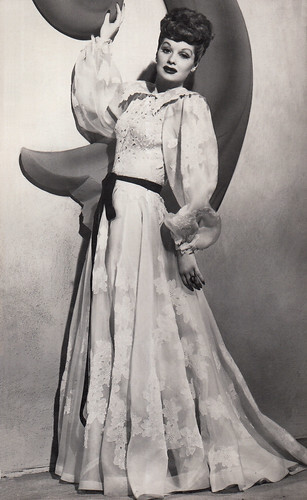
Spanish postcard by Belfo, no. 3584. Lucille Ball in Lover Come Back (William A. Seiter, 1946).
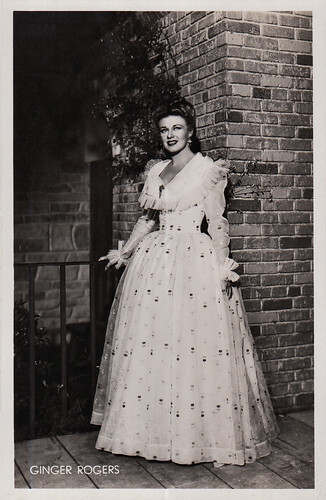
Dutch postcard by J. Sleding N.V., Amsterdam, no. 1051. Ginger Rogers in Magnificent Doll (Frank Borzage, 1946).
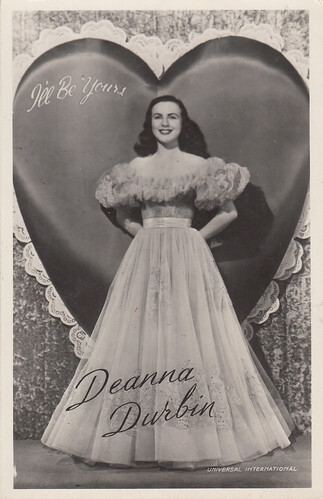
Dutch postcard, no. 3535. Photo: Universal International. Deanna Durbin in I’ll be Yours (William A. Seiter, 1947).
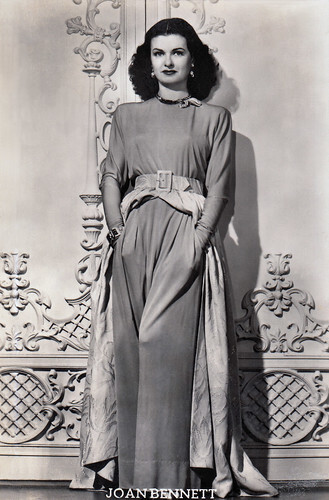
French or Belgian postcard. Joan Bennett in Secret Beyond the Door (Fritz Lang, 1947).
Text and postcards: Marlene Pilaete.
However, the star Travis Banton is most associated with is Marlene Dietrich . The actress, who was once wittily described by Hitchcock as "a professional costume designer", closely collaborated with him to create an unforgettable glamourous image. Travis Banton knew that even the most extreme creations would look good on her. As Margaret J. Bailey, author of the book 'Those Glorious Glamour Years', wrote: "Garments outrageous on anyone else were carried routinely by Dietrich. No other actress could sustain the heavy glamour load several of her outfits conveyed".
Travis Banton stayed at Paramount until 1938. He then worked for 20th Century Fox (1939-1941) and for Universal (1945-1948). In the 1950s, he notably designed Rosalind Russell ’s costumes for the Broadway play 'Auntie Mame' (1956-1958). He passed away on 2 February 1958. Edith Head, who succeeded Travis Banton as head of the Paramount costume design department, allegedly said about him: "He was a marvellous designer. Any talent I might have would have lain undiscovered if he hadn’t lighted the way for me. In my opinion, he was the greatest."

Mexican postcard by CIF, no. 1835. Thais Valdemar (wrongly captioned as Anna May Wong ) in The Dressmaker from Paris (Paul Bern, 1925).
At the time this dress was described as: "A tight-fitting gown of flesh colour silk, embroidered with pearls, diamonds and gold spangles, and edged with crystal fringes."

German postcard by Ross Verlag, no. 1992/1, 1927-1928. Photo: Parufamet. Esther Ralston in Fashions for Women (Dorothy Arzner, 1927).

German postcard by Ross Verlag, no. 3389/1, 1928-1929. Photo: Paramount Pictures. Alice White in Gentlemen Prefer Blondes (Malcolm St. Clair, 1928).

French postcard by Cinémagazine, Paris, no. 530. Ruth Taylor in Gentlemen Prefer Blondes (Malcolm St. Clair, 1928).

German postcard by Ross Verlag, no. 4105/2, 1929-1930. Photo: Paramount Pictures. Pola Negri in Three Sinners (Rowland V. Lee, 1928).

French postcard by Europe, no. 350. Photo: Paramount Pictures. Evelyn Brent in His Tiger Lady (Hobart Henley, 1928).
“The gown is worn over a silver tissue slip and is heavily embroidered with brilliants and crystal. It has large wing sleeves and bands of crystal fall from the brilliant fastening, in front. The turban of silver with which Miss Brent covers her hair adds the ultra chic touch to an elaborate costume.” (from an article published in December 1928 in the Australian Sunday Times).

Spanish postcard by La Novela Frivola Cinematografica, no. 25. Evelyn Brent in His Tiger Lady (Hobart Henley, 1928).

French postcard by Europe, no. 348. Clara Bow in The Fleet’s In (Malcolm St. Clair, 1929).

German postcard by Ross Verlag, no. 5139/1, 1930-1931. Photo: Paramount Pictures. Evelyn Brent on a publicity portrait for Interference (Lothar Mendes, Roy Pomeroy, 1928).

German postcard by Ross Verlag, no. 4986/1, 1929-1930. Photo: Paramount Pictures. Kay Francis in Behind the Make-Up (Robert Milton, 1930).

German postcard by Ross Verlag, no. 5544/1, 1930-1931. Photo: Paramount. Clara Bow in Her Wedding Night (Frank Tuttle, 1930).

German postcard by Ross Verlag, no. 5126/2, 1930-1931. Photo: Paramount. Marlene Dietrich in Morocco (Josef von Sternberg, 1930).

French postcard by Edition Ross, no. 5379/3, 1930-1931. Photo: Paramount. Marlene Dietrich in Morocco (Josef von Sternberg, 1930).

German postcard by Ross Verlag, no. 7227/1, 1932-1933. Photo: Paramount. Anna May Wong in Daughter of the Dragon (Lloyd Corrigan, 1931).

German postcard by Eidelsan, Serie II, Bild 116. Carole Lombard in No One Man (Lloyd Corrigan, 1932).

German postcard by Ross Verlag, no. 6678/1, 1931-1932. Marlene Dietrich and Anna May Wong in Shanghai Express (Josef von Sternberg, 1932).

Dutch postcard by M. Bonnist & Zonen, Amsterdam, no. B226. Photo: Paramount. Sylvia Sidney , as the Japanese character Cho-Cho-San, in Madame Butterfly (Marion Gering, 1932).

Dutch postcard by M. Bonnist & Zonen, Amsterdam, no. B251. Photo: Paramount. Marlene Dietrich in The Song of Songs (Rouben Mamoulian, 1933).

Italian postcard by Fotocelere, no. 15. Photo: M.G.M. Miriam Hopkins in Design for Living (Ernst Lubitsch, 1933).

German postcard by Ross Verlag, no. 8496/1, 1933-1934. Photo: Paramount. Marlene Dietrich in The Scarlet Empress (Josef von Sternberg, 1934).
Travis Banton allegedly said about The Scarlett Empress: "Miss Dietrich’s costumes in that picture were expressive of the period’s fashions, without being mere stereotyped copies of sketches found in books. I placed myself mentally in the position of a designer of the middle eighteenth century".

Dutch postcard by M. Bonnist & Zonen, Amsterdam, no. B350. Photo: Paramount. Marlene Dietrich in The Scarlett Empress (Josef von Sternberg, 1934).

Dutch postcard by M. Bonnist & Zonen, Amsterdam, no. B367. Photo: Paramount. Mae West in Belle of the Nineties (Leo McCarey, 1934).

Dutch postcard by M. Bonnist & Zonen, Amsterdam, no. B363. Photo: Paramount. Claudette Colbert in Cleopatra (Cecil B. DeMille, 1934).

German postcard by Ross Verlag, no. 9596/1, 1935-1936. Photo: Paramount. Anna May Wong in Limehouse Blues (Alexander Hall, 1934).
According to the Costume Institute of the Metropolitan Museum of Art in New York, where the gown is now displayed: "The dragon motif adds a distinct Asian influence, dazzling in its execution in gold and silver sequins on luxurious satin."

German postcard by Ross Verlag, no. 8991/1, 1933-1934. Photo: Paramount. Marlene Dietrich in The Devil Is a Woman (Josef von Sternberg, 1935).
Variety Magazine wrote: "Not even Garbo in the Orient has approached, for special effects, Dietrich in Spain. With fringe, lace, sequins, carnations, chenille, nets, embroideries, and shawls, Miss Dietrich is hung, wrapped, draped, swathed, and festooned. She emerges as a glorious achievement, a supreme consolidation of the sartorial, make-up, and photographic arts

Dutch postcard by M. Bonnist & Zonen, Amsterdam, no. B395. Photo: Paramount. Marlene Dietrich in The Devil Is a Woman (Josef von Sternberg, 1935).

Italian postcard by Ballerini & Fratini, Firenze (B.F.F. Edit.), no. 2745. Carole Lombard .
On the back of a publicity portrait of Carole Lombard wearing this outfit, she is referred to as "Carole Lombard of Paramount’s Rumba". So, we can date it from about 1935, the year Rumba was released, although it seems that Lombard didn’t wear it in the movie. The caption for this ensemble was: "Lightweight beige tweed lined in burgundy corduroy carries out Travis Banton’s desire to create a costume equally appropriate for town or country wear".

French postcard by Erpé, no. 756. Photo: Paramount. Marlene Dietrich in Desire (Frank Borzage, 1936).

German postcard by Ross Verlag, no. 9712/1, 1935-1936. Photo: Paramount. Ida Lupino in Yours for the Asking (Alexander Hall, 1936).
This is how this outfit was then depicted on a publicity portrait: "White Souffle is the background of this formal gown. The embroidery is made of silver paillettes and corresponds to the long flowing cape which matches the girdle worn at the tightly fitted waist".

Dutch postcard. Dorothy Lamour in Swing High, Swing Low (Mitchell Leisen, 1937).

German postcard by Ross Verlag, no. A1138/1, 1937-1938. Photo: Paramount. Claudette Colbert in I Met Him in Paris (Wesley Ruggles, 1937).

Postcard from the Dutch East Indies (now Indonesia). Irene Dunne in High, Wide and Handsome (Rouben Mamoulian, 1937).

German postcard by Ross Verlag, no. A 1977/1, 1937-1938. Photo: Paramount. Marlene Dietrich in Angel (Ernst Lubitsch, 1937).
This is allegedly the most expensive gown Travis Banton ever designed. "It’s a three-piece jewel-encrusted evening gown consisting of a fitted bodice with three-quarter sleeves; full-length skirt with train and matching stole trimmed with sable. The garment is solidly embroidered in a paisley motif with gold crystal caviar beads, seed pearls, gold sequins, small rhinestones, gold bullion thread and paste rubies and emeralds". (Description from The Collection of Motion Picture Costume Design).Travis Banton once declared about it: "It was simple in lines, of Persian design, and looked like a piece of woven jewellery. A score of embroiderers worked on it for two and a half weeks".

Italian postcard by Ballerini & Fratini, Firenze, no. 2535. Photo: Paramount. Claudette Colbert in Bluebeard’s Eight Wife (Ernst Lubitsch, 1938).

Spanish postcard, no. 291. Photo: Fox. Carmen Miranda in Down Argentine Way (Irving Cummings, 1940).

Spanish postcard by Sobe, no. 475. Photo: 20th Century Fox. Rita Hayworth in Blood and Sand (Rouben Mamoulian, 1941).

Spanish postcard no. 151. Merle Oberon in A Song to Remember (Charles Vidor, 1945).
Merle Oberon once said about Travis Banton: "He not only knew what the character ought to look like but also understood what an actress was the happiest wearing, which is very rare for a costume designer. As a result, I never found it necessary to make a single change on any of his drawings".

Vintage postcard. Joan Bennett in Scarlet Street (Fritz Lang, 1945).

Spanish postcard, no. 3057. Yvonne De Carlo in Frontier Gal (Charles Lamont, 1945).

Spanish postcard by Ibis, no. 5. Maria Montez in Tangier (George Waggner, 1946).

Spanish postcard by Archivo Bermejo, Barcelona. Merle Oberon and Turhan Bey in Night in Paradise (Arthur Lubin, 1946).

Spanish postcard by Belfo, no. 3584. Lucille Ball in Lover Come Back (William A. Seiter, 1946).

Dutch postcard by J. Sleding N.V., Amsterdam, no. 1051. Ginger Rogers in Magnificent Doll (Frank Borzage, 1946).

Dutch postcard, no. 3535. Photo: Universal International. Deanna Durbin in I’ll be Yours (William A. Seiter, 1947).

French or Belgian postcard. Joan Bennett in Secret Beyond the Door (Fritz Lang, 1947).
Text and postcards: Marlene Pilaete.
Published on December 28, 2024 22:00
December 27, 2024
The Disney Classic That Never Was: Chanticleer
In June 1960, Walt Disney told the Los Angeles Times that, following the release of One Hundred and One Dalmatians (1961), two animated films were in development: The Sword in the Stone (1963) and Chanticleer. Earlier conceptions of Chanticleer date back to the 1940s. The Disney film was never realised but it was an interesting project based on a legendary French stage play of which many wonderful postcards remain.
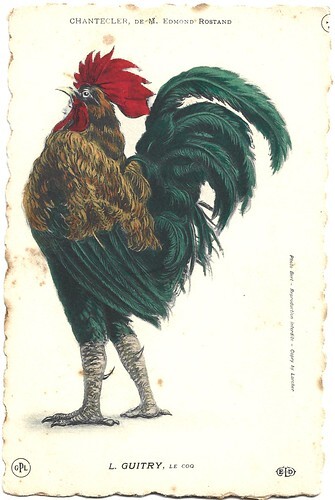
French postcard by ELD (Ed. Le Deley) / GPL. Photo: Bert. Lucien Guitry as Chantecler, Le coq (The Rooster) in the stage play 'Chantecler' by Edmond Rostand.
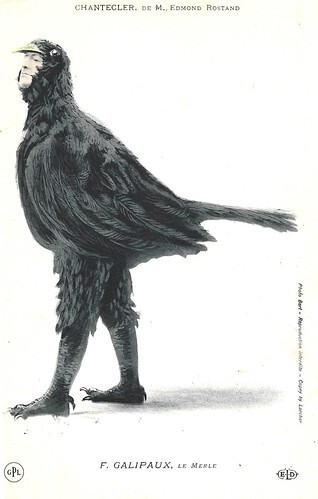
French postcard by ELD (Ed. Le Deley) / GPL. Photo: Bert. Félix Galipaux as Le Merle (The Blackbird) in the stage play 'Chantecler' by Edmond Rostand. French actor, playwright, and humorist Galipaux (1860-1931) was known for his comic stage monologues, such as 'Communication Téléphonique' (1906). A few of these monologues were recorded.
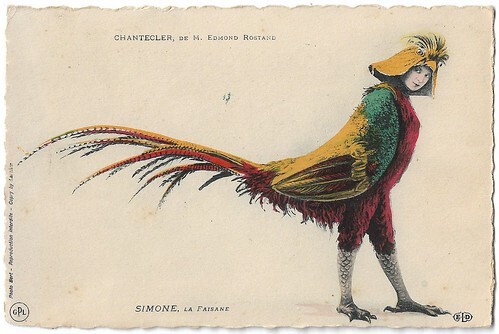
French postcard by ELD (Ed. Le Deley) / GPL. Photo: Bert. Mme Simone as La Faisane (The Pheasant) in the stage play 'Chantecler' (1910), written by Edmond Rostand. French actress and writer Pauline Benda (1877-1985), known as Madame Simone or simply Simone, made her debut in the theatre in 1902. She acted in plays by Luigi Pirandello and Henry Bataille, among others.
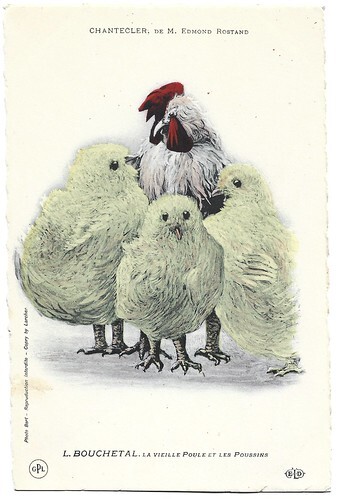
French postcard by ELD (Ed. Le Deley) / GPL. Photo: Bert. Léontine Bouchetal as La vieille Poule et les Poussins (The Old Hen and the Chicks) in the stage play 'Chantecler' (1910), written by Edmond Rostand. French stage actress Léontine Bouchetal (1872-1932) played the role of mère Marguerite in the premiere of 'Cyrano de Bergerac' in 1897. At her wedding in January 1904, the witnesses were Coquelin aîné, Jean Coquelin and the police prefect Louis Lépine.
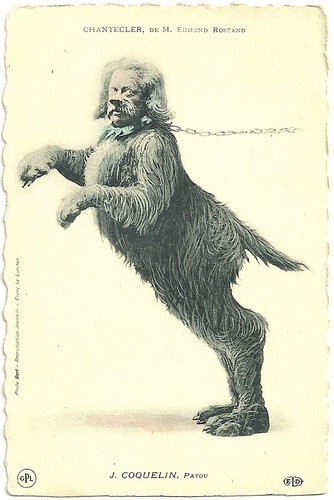
French postcard by ELD (Ed. Le Deley) / GPL. Photo: Bert. Jean Coquelin as the farmyard dog Patou in the stage play 'Chantecler' (1910), written by Edmond Rostand. Jean Coquelin (1865-1944) was the son of the famous stage actor Benoit Constant Coquelin. He played Raigoné in Edmond Rostand's 'Cyrano de Bergerac', the major play in which his father had performed. Coquelin and his father played together in the stage play 'La Dame de Monsoreau' (1860), after a novel by Alexandre Dumas. Between 1925 and 1943 he also appeared in several films.
The laughing stock of all domestic and wild animals
The Disney studio based the idea for Chanticleer on the stage play 'Chantecler'. Famous French auteur Edmond Rostand wrote this play in four acts in 1910. 'Chantecler' was first performed on 7 February 1910 at the Porte-Saint-Martin theatre. The lead roles were played by Lucien Guitry, Jean Coquelin, Félix Galipaux and Madame Simone.
Lucien Guitry starred as the rooster Chantecler. Guitry was considered the preeminent French actor of his day. For many years, he played opposite Sarah Bernhardt . He also appeared in silent films like Tosca (1908) and Ceux de chez nous (1915). He was married to Jeanne Desclois and Renée de Pont-Jest, and his son was the well-known actor-writer-director Sacha Guitry .
Chantecler is a coquerel who reigns over a barnyard. He is so convinced of his importance that he imagines his crowing will make the sun rise. But the arrival of a pheasant hen turns his life upside down. Love is revealed to him in such a way that he forgets to crow. So when the sun comes out, Chantecler becomes the laughingstock of all domestic and wild animals.
Especially the owls, the creatures of the night, hate him and force him to accept a public fight with another cock. The fight takes place in the guinea fowl's literary salon. After a near-death experience, Chantecler defends the barnyard against the threats of a sparrowhawk, thereby regaining some of his prestige. Unjustly neglected, but understanding that vanity is stronger than love in the cock, the pheasant nevertheless sacrifices herself for him and goes to meet a hunter in his place. A shot is fired, but it is the golden-voiced nightingale who is mortally wounded. The rooster's hoarse crow alone will continue to celebrate the dawn.
Opposite the proud cockerel Chantecler, there is the vile Merl. He represents the cynical city slicker, intrigue, jealousy and cowardry. Then there are the presumptuous Guinea Fowl, the loyal and friendly dog Patou, the Pheasant, representing female Beauty and the Modern Woman, the vain and stupid Peacock, the fragile and magic Nightingale, and the creatures of the night like the Toads (ugly and powerless, a critique by Rostand of theatre critics) and the Night Birds like the Owls, who hate the cockerel as they can only live during the night and he disturbs this.
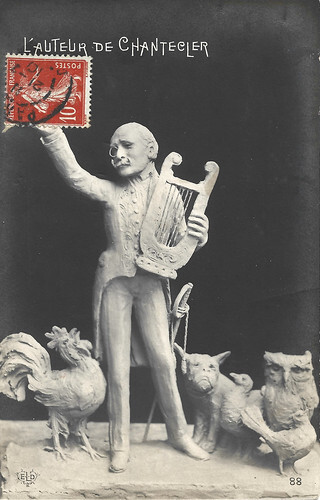
French postcard by E.L.D. (Ed. Le Deley), no. 88. Caption: L'auteur de 'Chantecler' (the author of Chantecler - Edmond Rostand).
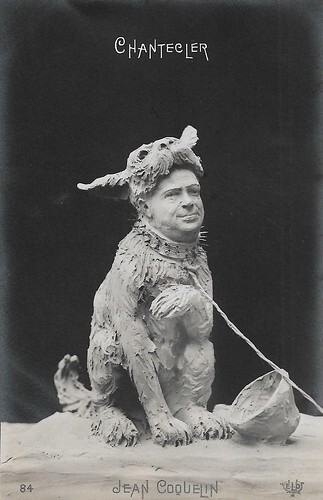
French postcard by ELD (Ed. Le Deley), no. 84. Jean Coquelin as the farmyard dog Patou in 'Chantecler' (1910), a play by Edmond Rostand.
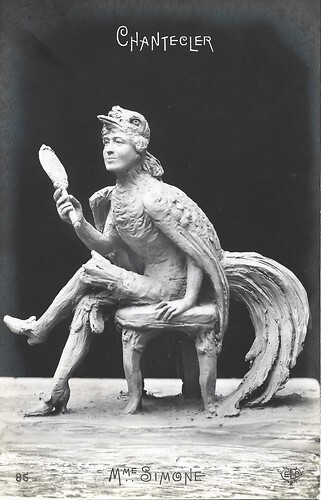
French postcard by ELD (Ed. Le Deley), no. 85. Mme Simone in the French stage play 'Chantecler' (1910), written by Edmond Rostand.
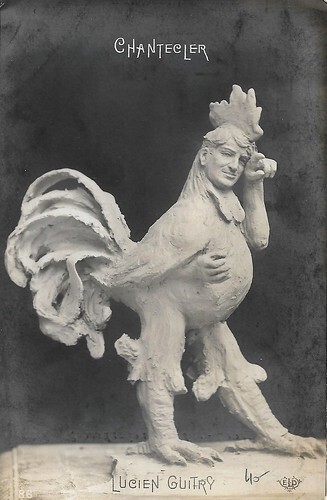
French postcard by ELD (Ed. Le Deley), no. 86. Lucien Guitry was the title character in the French stage play 'Chantecler' (1910), written by Edmond Rostand.
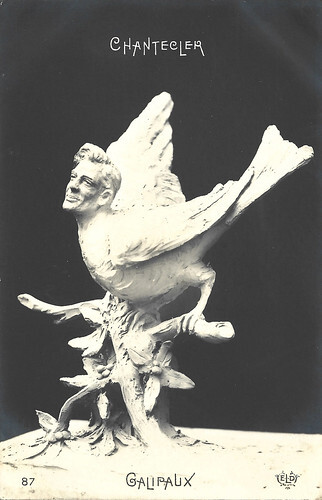
French postcard by ELD (Ed. Le Deley), no. 87. Félix Galipaux in the French stage play 'Chantecler' (1910), written by Edmond Rostand.
Very high expectations
After his successes with 'Cyrano de Bergerac' and 'L'Aiglon', the expectations for Edmond Rostand's next play were very high. Rostand took years to finish 'Chanticler' which involved over 70 characters and 195 costumes. The author himself designed all the sets and costumes and he almost crashed during the preparations of his gigantic enterprise. The play finally premiered on 7 February 1910 at the Théâtre de la Porte Saint-Martin in Paris, with a star cast including Lucien Guitry as Chantecler and Jean Coquelin as Patou.
The premiere audience was deluded and even felt insulted, as Rostand sharply criticised the hypocrisy, jealousy, intrigues, and presumptuousness of life in the city, as opposed to the countryside. Moreover, audiences were not accustomed to seeing the famous actors dressed up as animals, and some felt Guitry's performance was not his best. A revival in 1927, with Victor Francen as Chantecler, was better received. Afterwards, the play would be revived in and outside of France several times, while the Broadway version already took place in 1911, with Maud Adams starring.
Wikipedia offers the curious afterlife of the play: "In June 1960, Disney told the Los Angeles Times that, following the release of One Hundred and One Dalmatians, two animated projects were in development, which were Chanticleer and The Sword in the Stone. Around that same time, Disney's elder brother Roy O. Disney attempted to persuade him to discontinue their feature animation division, as enough films remained to make successful re-releases. The younger Disney refused, but, because of his plans to build another theme park in the United States, he would approve only one animated film to be released every four years.
Chanticleer was developed by Ken Anderson and Marc Davis, who aimed to produce a feature animated film in a more contemporary setting. They visited the Disney archives and decided to work on adapting the satirical tale after glancing at earlier conceptions dating back to the 1940s. Anderson, Davis, Milt Kahl, and director Wolfgang Reitherman spent months preparing elaborate storyboards for Chanticleer. Following a silent response to one pitch presentation, a voice from the back of the room said, "You can't make a personality out of a chicken!" When the time came to approve either Chanticleer or The Sword in the Stone, Disney remarked that the problem with making a rooster a protagonist was, "[you] don't feel like picking a rooster up and petting it."
In 1992, Edmond Rostand's story of Chantecler was loosely adapted into the American animated film Rock-a-Doodle (Don Bluth, Gary Goldman, Dan Kuenster, 1992) and set in Tennessee in 1957. Here the Grand Duke of Owls concocts to have Chanticleer ridiculed as he forgets to crow at the rising sun after a fierce battle, so the rooster leaves for town to become a singer. Meanwhile, the night birds set their hungry eyes on the farm birds... Glen Campbell gave his voice to Chanticleer and Christopher Plummer dubbed the Grand Duke of Owls. The film was neither a critical success nor a box office hit. However, it would be more successful during its home video release.
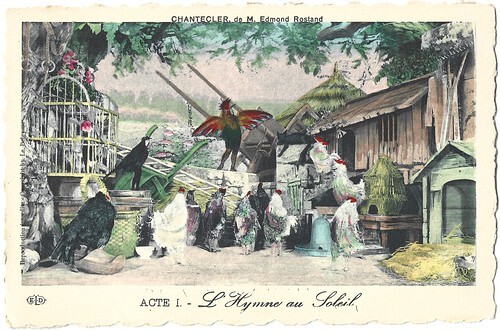
French postcard by E.L.D. (Ed. Le Deley). Scene from the stage play 'Chantecler', Act I, with Lucien Guitry as the Rooster. Caption: L'Hymne au Soleil (Anthem to the Sun).
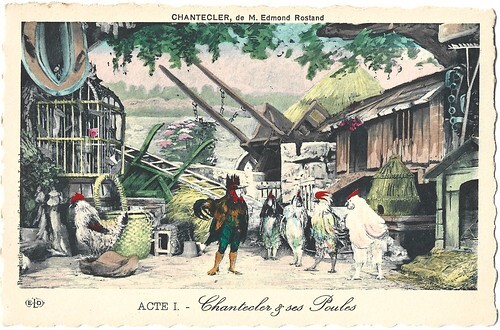
French postcard by E.L.D. (Ed. Le Deley). Scene from the stage play 'Chantecler', Act I, with Lucien Guitry as The Rooster. Caption: Chantecler et ses Poules (Chantecler and his hens).
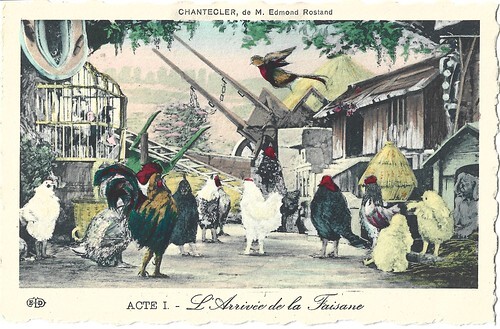
French postcard by E.L.D. (Ed. Le Deley). Scene from the stage play 'Chantecler', Act I. Caption: L'Arrivée de la Faisane (The arrival of the pheasant).
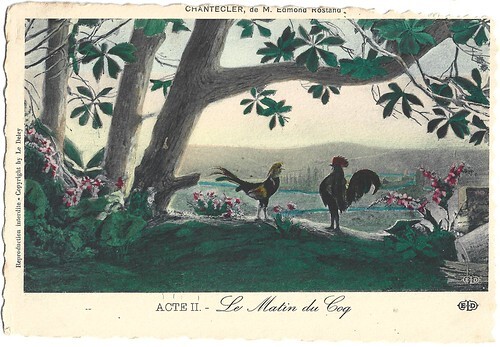
French postcard by E.L.D. (Ed. Le Deley). Scene from the stage play 'Chantecler', Act II, with Lucien Guitry in the title role and Mme Simone as the Pheasant. Caption: Le Matin du Coq (The Morning of the Rooster).
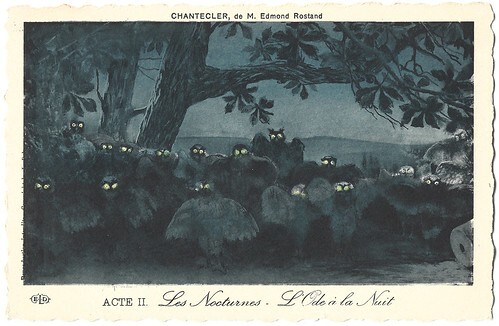
French postcard by E.L.D. (Ed. Le Deley). Scene from the stage play 'Chantecler', Act II. Caption: Les Nocturnes - L'Ode à la Nuit (Nocturnes - Ode to the Night).
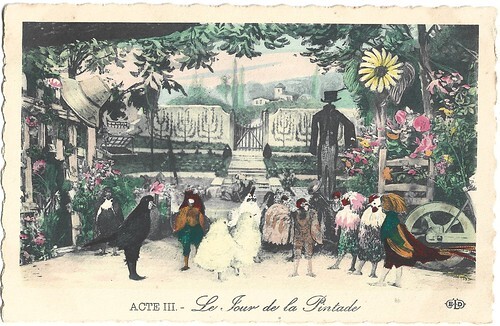
French postcard by E.L.D. (Ed. Le Deley). Photo Bert. Scene from the stage play 'Chantecler', Act III Caption: Le jour de la Pintade (The Day of the Guinea Fowl). Left to right: The Blackbird (Felix Galipaux), The Rooster (Lucien Guitry), The Old Hen & the Chicks (Léontine Bouchetal), and far right, The Pheasant (Mme Simone).
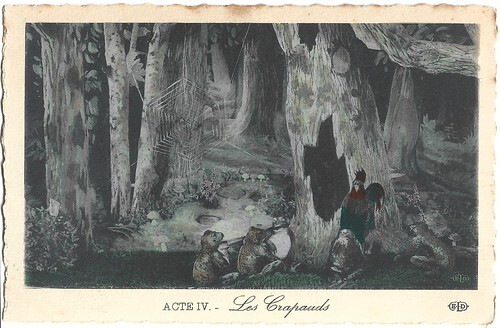
French postcard by E.L.D. (Ed. Le Deley). Photo Bert. Scene from the stage play 'Chantecler', Act IV. Caption: Les Crapauds (The Toads).
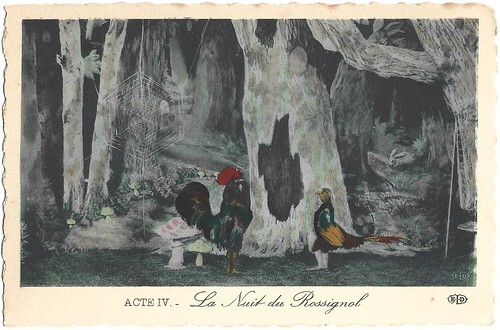
French postcard by E.L.D. (Ed. Le Deley). Photo Bert. Scene from the stage play 'Chantecler', Act IV. Caption: La Nuit du Rossignol (The Night of the Nightingale). In the foreground, Lucien Guitry as Chantecler and Mme Simone as The Pheasant.
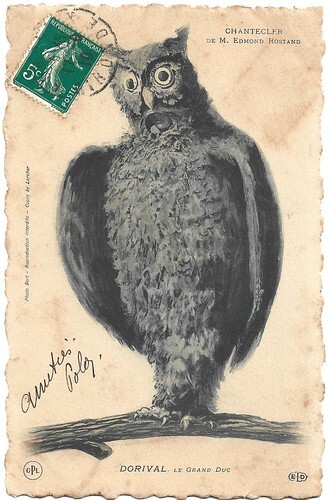
French postcard by ELD (Ed. Le Deley) / GPL. Photo: Bert. Dorival as Le Grand Duc (Grand Duke of Owls) in 'Chantecler' (1910).
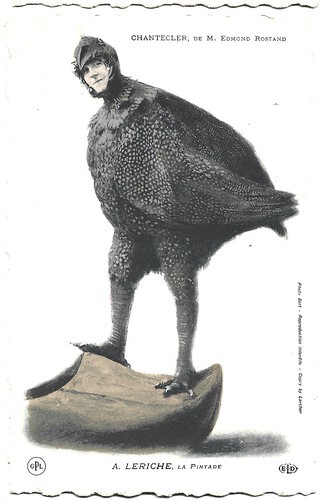
French postcard by ELD (Ed. Le Deley) / GPL. Photo: Bert. Augustine Leriche as La Pintade (The Guineafowl) in 'Chantecler' (1910). French stage actress and singer Augustine Leriche (1856-1938) performed at the Théâtre de l'Ambigu-Comique, Théâtre des Folies-Dramatiques, Théâtre du Châtelet, Gaîté-Lyrique, Théâtre de l'Athénée, and Théâtre du Palais-Royal. At the Porte-Saint-Martin, she created the role of the guinea fowl in 'Chantecler'.
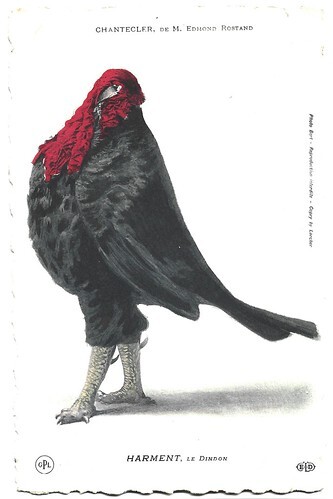
French postcard by ELD (Ed. Le Deley) / GPL. Photo: Bert. Henri Harment as Le Dindon (The Turkey) in 'Chantecler' (1910). In the 1910s, French stage actor Henri / Henry/ Harry Harment (1878-19..) alternated between the Théâtre de l'Ambigu-Comique and the Théâtre de la Porte Saint-Martin in plays such as 'La Flambée' by Henry Kistemaeckers, 'Le Mystère de la chambre jaune' by Gaston Leroux, and 'Les Flambeaux' by Henry Bataille. Onscreen, Harment debuted in La petite fonctionnaire (Georges Denola, 1912). He acted as Louis XVI opposite Diana Karenne as Marie-Antoinette in Le collier de la reine (Gaston Ravel, Tony Lekain, 1929). In the early 1930s, Harment also had supporting parts in Delphine (Roger Capellani, 1931) and in Une nuit à l'hôtel (Leo Mittler, 1932). Afterwards, he also scripted the Yvette Lebon vehicle Les mariages de Mademoiselle Lévy (André Hugon, 1936) and C'est lui que je veux (André Royet, 1937) - in the latter, he also acted.
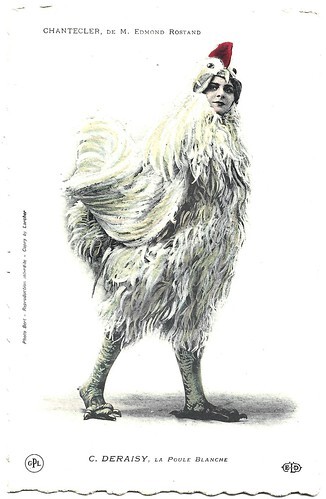
French postcard by ELD (Ed. Le Deley) / GPL. Photo: Bert. Carmen Deraisy as La Poule Blanche (The White Chicken) in 'Chantecler' (1910). French stage and screen actress Carmen Deraisy aka Carmen de Raisy (1883-1954) played the femme fatale Gioconda Danti in Gabriele D'Annunzio's play 'La Gioconda' (1905). After that, she did several performances at the Théâtre de l'Ambigu-Comique. In 1910 she started at the company Éclair to act in such films as La jolie dame de Narbonne (Victorin-Hippolyte Jasset, 1910) in which she had the lead right away. In 1911 she stepped over to Pathé, where she could be seen in La fiancée du château maudit (Albert Capellani, 1911), a Horror film about a bride who gets trapped in a room with a skeleton. Between 1911 and 1914, she acted in eight more Pathé films. She would return to the film set only once more, as a fortuneteller in the Harry Baur film Péchés de jeunesse (Maurice Tourneur, 1941).
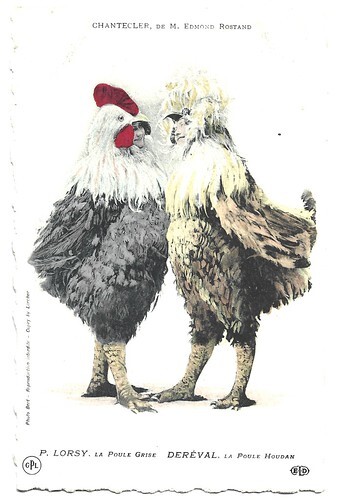
French postcard by ELD (Ed. Le Deley) / GPL. Photo: Bert. Paulette Lorsy and Madeleine Deréval as La Poule Grise and La Poule Houdan in 'Chantecler' (1910).French theatre and silent film actress Paulette Lorsy (1881-1929) performed in Paris's leading theatres, including the Porte-Saint-Martin, the Gymnase, the Ambigu, the Sarah-Bernardt and the Athénée, as well as in the provinces and abroad. She played in vaudeville and prose comedies, but also in such dramas as 'Cyrano de Bergerac. Lorsy started to act in film farces at Pathé Frères in 1909. She was matched with comedian Max Linder in 1910 and acted in numerous of his comedies. She also acted in the comedies with Rigadin (Prince), directed by Georges Denola. From 1915 to 1917, she acted in many short comedies directed by Henri Gambart.
Sources: Wikipedia (English and French) and IMDb.

French postcard by ELD (Ed. Le Deley) / GPL. Photo: Bert. Lucien Guitry as Chantecler, Le coq (The Rooster) in the stage play 'Chantecler' by Edmond Rostand.

French postcard by ELD (Ed. Le Deley) / GPL. Photo: Bert. Félix Galipaux as Le Merle (The Blackbird) in the stage play 'Chantecler' by Edmond Rostand. French actor, playwright, and humorist Galipaux (1860-1931) was known for his comic stage monologues, such as 'Communication Téléphonique' (1906). A few of these monologues were recorded.

French postcard by ELD (Ed. Le Deley) / GPL. Photo: Bert. Mme Simone as La Faisane (The Pheasant) in the stage play 'Chantecler' (1910), written by Edmond Rostand. French actress and writer Pauline Benda (1877-1985), known as Madame Simone or simply Simone, made her debut in the theatre in 1902. She acted in plays by Luigi Pirandello and Henry Bataille, among others.

French postcard by ELD (Ed. Le Deley) / GPL. Photo: Bert. Léontine Bouchetal as La vieille Poule et les Poussins (The Old Hen and the Chicks) in the stage play 'Chantecler' (1910), written by Edmond Rostand. French stage actress Léontine Bouchetal (1872-1932) played the role of mère Marguerite in the premiere of 'Cyrano de Bergerac' in 1897. At her wedding in January 1904, the witnesses were Coquelin aîné, Jean Coquelin and the police prefect Louis Lépine.

French postcard by ELD (Ed. Le Deley) / GPL. Photo: Bert. Jean Coquelin as the farmyard dog Patou in the stage play 'Chantecler' (1910), written by Edmond Rostand. Jean Coquelin (1865-1944) was the son of the famous stage actor Benoit Constant Coquelin. He played Raigoné in Edmond Rostand's 'Cyrano de Bergerac', the major play in which his father had performed. Coquelin and his father played together in the stage play 'La Dame de Monsoreau' (1860), after a novel by Alexandre Dumas. Between 1925 and 1943 he also appeared in several films.
The laughing stock of all domestic and wild animals
The Disney studio based the idea for Chanticleer on the stage play 'Chantecler'. Famous French auteur Edmond Rostand wrote this play in four acts in 1910. 'Chantecler' was first performed on 7 February 1910 at the Porte-Saint-Martin theatre. The lead roles were played by Lucien Guitry, Jean Coquelin, Félix Galipaux and Madame Simone.
Lucien Guitry starred as the rooster Chantecler. Guitry was considered the preeminent French actor of his day. For many years, he played opposite Sarah Bernhardt . He also appeared in silent films like Tosca (1908) and Ceux de chez nous (1915). He was married to Jeanne Desclois and Renée de Pont-Jest, and his son was the well-known actor-writer-director Sacha Guitry .
Chantecler is a coquerel who reigns over a barnyard. He is so convinced of his importance that he imagines his crowing will make the sun rise. But the arrival of a pheasant hen turns his life upside down. Love is revealed to him in such a way that he forgets to crow. So when the sun comes out, Chantecler becomes the laughingstock of all domestic and wild animals.
Especially the owls, the creatures of the night, hate him and force him to accept a public fight with another cock. The fight takes place in the guinea fowl's literary salon. After a near-death experience, Chantecler defends the barnyard against the threats of a sparrowhawk, thereby regaining some of his prestige. Unjustly neglected, but understanding that vanity is stronger than love in the cock, the pheasant nevertheless sacrifices herself for him and goes to meet a hunter in his place. A shot is fired, but it is the golden-voiced nightingale who is mortally wounded. The rooster's hoarse crow alone will continue to celebrate the dawn.
Opposite the proud cockerel Chantecler, there is the vile Merl. He represents the cynical city slicker, intrigue, jealousy and cowardry. Then there are the presumptuous Guinea Fowl, the loyal and friendly dog Patou, the Pheasant, representing female Beauty and the Modern Woman, the vain and stupid Peacock, the fragile and magic Nightingale, and the creatures of the night like the Toads (ugly and powerless, a critique by Rostand of theatre critics) and the Night Birds like the Owls, who hate the cockerel as they can only live during the night and he disturbs this.

French postcard by E.L.D. (Ed. Le Deley), no. 88. Caption: L'auteur de 'Chantecler' (the author of Chantecler - Edmond Rostand).

French postcard by ELD (Ed. Le Deley), no. 84. Jean Coquelin as the farmyard dog Patou in 'Chantecler' (1910), a play by Edmond Rostand.

French postcard by ELD (Ed. Le Deley), no. 85. Mme Simone in the French stage play 'Chantecler' (1910), written by Edmond Rostand.

French postcard by ELD (Ed. Le Deley), no. 86. Lucien Guitry was the title character in the French stage play 'Chantecler' (1910), written by Edmond Rostand.

French postcard by ELD (Ed. Le Deley), no. 87. Félix Galipaux in the French stage play 'Chantecler' (1910), written by Edmond Rostand.
Very high expectations
After his successes with 'Cyrano de Bergerac' and 'L'Aiglon', the expectations for Edmond Rostand's next play were very high. Rostand took years to finish 'Chanticler' which involved over 70 characters and 195 costumes. The author himself designed all the sets and costumes and he almost crashed during the preparations of his gigantic enterprise. The play finally premiered on 7 February 1910 at the Théâtre de la Porte Saint-Martin in Paris, with a star cast including Lucien Guitry as Chantecler and Jean Coquelin as Patou.
The premiere audience was deluded and even felt insulted, as Rostand sharply criticised the hypocrisy, jealousy, intrigues, and presumptuousness of life in the city, as opposed to the countryside. Moreover, audiences were not accustomed to seeing the famous actors dressed up as animals, and some felt Guitry's performance was not his best. A revival in 1927, with Victor Francen as Chantecler, was better received. Afterwards, the play would be revived in and outside of France several times, while the Broadway version already took place in 1911, with Maud Adams starring.
Wikipedia offers the curious afterlife of the play: "In June 1960, Disney told the Los Angeles Times that, following the release of One Hundred and One Dalmatians, two animated projects were in development, which were Chanticleer and The Sword in the Stone. Around that same time, Disney's elder brother Roy O. Disney attempted to persuade him to discontinue their feature animation division, as enough films remained to make successful re-releases. The younger Disney refused, but, because of his plans to build another theme park in the United States, he would approve only one animated film to be released every four years.
Chanticleer was developed by Ken Anderson and Marc Davis, who aimed to produce a feature animated film in a more contemporary setting. They visited the Disney archives and decided to work on adapting the satirical tale after glancing at earlier conceptions dating back to the 1940s. Anderson, Davis, Milt Kahl, and director Wolfgang Reitherman spent months preparing elaborate storyboards for Chanticleer. Following a silent response to one pitch presentation, a voice from the back of the room said, "You can't make a personality out of a chicken!" When the time came to approve either Chanticleer or The Sword in the Stone, Disney remarked that the problem with making a rooster a protagonist was, "[you] don't feel like picking a rooster up and petting it."
In 1992, Edmond Rostand's story of Chantecler was loosely adapted into the American animated film Rock-a-Doodle (Don Bluth, Gary Goldman, Dan Kuenster, 1992) and set in Tennessee in 1957. Here the Grand Duke of Owls concocts to have Chanticleer ridiculed as he forgets to crow at the rising sun after a fierce battle, so the rooster leaves for town to become a singer. Meanwhile, the night birds set their hungry eyes on the farm birds... Glen Campbell gave his voice to Chanticleer and Christopher Plummer dubbed the Grand Duke of Owls. The film was neither a critical success nor a box office hit. However, it would be more successful during its home video release.

French postcard by E.L.D. (Ed. Le Deley). Scene from the stage play 'Chantecler', Act I, with Lucien Guitry as the Rooster. Caption: L'Hymne au Soleil (Anthem to the Sun).

French postcard by E.L.D. (Ed. Le Deley). Scene from the stage play 'Chantecler', Act I, with Lucien Guitry as The Rooster. Caption: Chantecler et ses Poules (Chantecler and his hens).

French postcard by E.L.D. (Ed. Le Deley). Scene from the stage play 'Chantecler', Act I. Caption: L'Arrivée de la Faisane (The arrival of the pheasant).

French postcard by E.L.D. (Ed. Le Deley). Scene from the stage play 'Chantecler', Act II, with Lucien Guitry in the title role and Mme Simone as the Pheasant. Caption: Le Matin du Coq (The Morning of the Rooster).

French postcard by E.L.D. (Ed. Le Deley). Scene from the stage play 'Chantecler', Act II. Caption: Les Nocturnes - L'Ode à la Nuit (Nocturnes - Ode to the Night).

French postcard by E.L.D. (Ed. Le Deley). Photo Bert. Scene from the stage play 'Chantecler', Act III Caption: Le jour de la Pintade (The Day of the Guinea Fowl). Left to right: The Blackbird (Felix Galipaux), The Rooster (Lucien Guitry), The Old Hen & the Chicks (Léontine Bouchetal), and far right, The Pheasant (Mme Simone).

French postcard by E.L.D. (Ed. Le Deley). Photo Bert. Scene from the stage play 'Chantecler', Act IV. Caption: Les Crapauds (The Toads).

French postcard by E.L.D. (Ed. Le Deley). Photo Bert. Scene from the stage play 'Chantecler', Act IV. Caption: La Nuit du Rossignol (The Night of the Nightingale). In the foreground, Lucien Guitry as Chantecler and Mme Simone as The Pheasant.

French postcard by ELD (Ed. Le Deley) / GPL. Photo: Bert. Dorival as Le Grand Duc (Grand Duke of Owls) in 'Chantecler' (1910).

French postcard by ELD (Ed. Le Deley) / GPL. Photo: Bert. Augustine Leriche as La Pintade (The Guineafowl) in 'Chantecler' (1910). French stage actress and singer Augustine Leriche (1856-1938) performed at the Théâtre de l'Ambigu-Comique, Théâtre des Folies-Dramatiques, Théâtre du Châtelet, Gaîté-Lyrique, Théâtre de l'Athénée, and Théâtre du Palais-Royal. At the Porte-Saint-Martin, she created the role of the guinea fowl in 'Chantecler'.

French postcard by ELD (Ed. Le Deley) / GPL. Photo: Bert. Henri Harment as Le Dindon (The Turkey) in 'Chantecler' (1910). In the 1910s, French stage actor Henri / Henry/ Harry Harment (1878-19..) alternated between the Théâtre de l'Ambigu-Comique and the Théâtre de la Porte Saint-Martin in plays such as 'La Flambée' by Henry Kistemaeckers, 'Le Mystère de la chambre jaune' by Gaston Leroux, and 'Les Flambeaux' by Henry Bataille. Onscreen, Harment debuted in La petite fonctionnaire (Georges Denola, 1912). He acted as Louis XVI opposite Diana Karenne as Marie-Antoinette in Le collier de la reine (Gaston Ravel, Tony Lekain, 1929). In the early 1930s, Harment also had supporting parts in Delphine (Roger Capellani, 1931) and in Une nuit à l'hôtel (Leo Mittler, 1932). Afterwards, he also scripted the Yvette Lebon vehicle Les mariages de Mademoiselle Lévy (André Hugon, 1936) and C'est lui que je veux (André Royet, 1937) - in the latter, he also acted.

French postcard by ELD (Ed. Le Deley) / GPL. Photo: Bert. Carmen Deraisy as La Poule Blanche (The White Chicken) in 'Chantecler' (1910). French stage and screen actress Carmen Deraisy aka Carmen de Raisy (1883-1954) played the femme fatale Gioconda Danti in Gabriele D'Annunzio's play 'La Gioconda' (1905). After that, she did several performances at the Théâtre de l'Ambigu-Comique. In 1910 she started at the company Éclair to act in such films as La jolie dame de Narbonne (Victorin-Hippolyte Jasset, 1910) in which she had the lead right away. In 1911 she stepped over to Pathé, where she could be seen in La fiancée du château maudit (Albert Capellani, 1911), a Horror film about a bride who gets trapped in a room with a skeleton. Between 1911 and 1914, she acted in eight more Pathé films. She would return to the film set only once more, as a fortuneteller in the Harry Baur film Péchés de jeunesse (Maurice Tourneur, 1941).

French postcard by ELD (Ed. Le Deley) / GPL. Photo: Bert. Paulette Lorsy and Madeleine Deréval as La Poule Grise and La Poule Houdan in 'Chantecler' (1910).French theatre and silent film actress Paulette Lorsy (1881-1929) performed in Paris's leading theatres, including the Porte-Saint-Martin, the Gymnase, the Ambigu, the Sarah-Bernardt and the Athénée, as well as in the provinces and abroad. She played in vaudeville and prose comedies, but also in such dramas as 'Cyrano de Bergerac. Lorsy started to act in film farces at Pathé Frères in 1909. She was matched with comedian Max Linder in 1910 and acted in numerous of his comedies. She also acted in the comedies with Rigadin (Prince), directed by Georges Denola. From 1915 to 1917, she acted in many short comedies directed by Henri Gambart.
Sources: Wikipedia (English and French) and IMDb.
Published on December 27, 2024 22:00
December 26, 2024
Walt Disney characters by Tobler
In 2020, EFSP published two posts on the Tobler postcard series with Disney characters. The Tobler company was created by Emil Baumann and Theodor Tobler (1876–1941) in Bern, Switzerland, in 1908. Emil Baumann, the cousin of Theodor Tobler, created the unique Toblerone recipe consisting of milk chocolate including nougat, almonds, and honey. Theodor Tobler came up with the distinctive teardrop shape and packaging. The product's name is a portmanteau combining Tobler's name with the Italian word 'torrone' (a type of nougat). The Disney postcards could be collected in an album and were printed by Imp. Georges Lang in Paris. In this post, we share eighteen Tobler postcards which we never posted before.
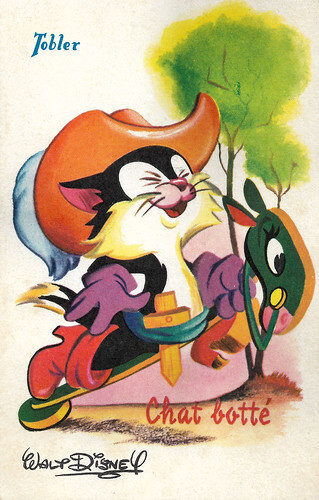
French postcard by Tobler. Image: Walt Disney. The French name of Puss in Boots is Chat botté.
Puss in Boots refers to a 1922 film directed by Walt Disney. The film was based on the story initially written by Giovanni Francesco Straparola and later retold by Charles Perrault.
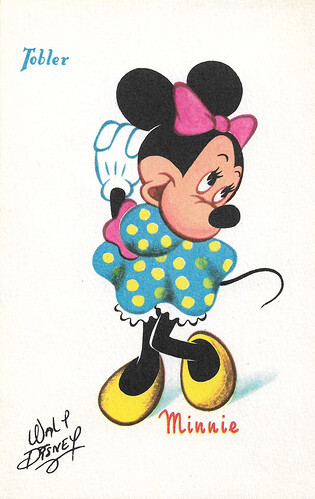
French postcard by Tobler. Image: The Walt Disney Company.
Minnie Mouse is an animated character who appears in several Disney productions, both comics and animated films. She is Mickey Mouse's longtime sweetheart and made her debut in 1928 with Mickey. Minnie Mouse wears white gloves, a red or pink bow, a blue (or pink or red) polka-dotted dress, white bloomers and yellow low-heeled shoes occasionally with ribbons on them.
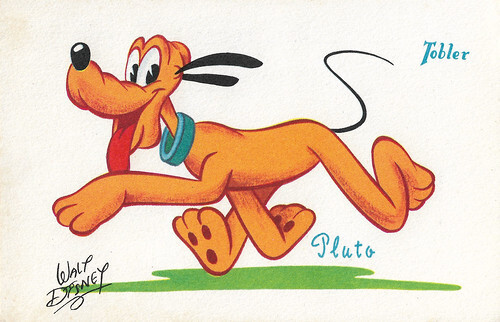
French postcard by Tobler. Image: The Walt Disney Company.
Pluto is an American cartoon character created by Walt Disney. He is a yellow-orange colour, medium-sized, short-haired dog with black ears. Unlike most Disney characters, Pluto is not anthropomorphic beyond some characteristics such as facial expression. The playful and often distracted dog first appeared in the cartoon The Chain Gang (1930).
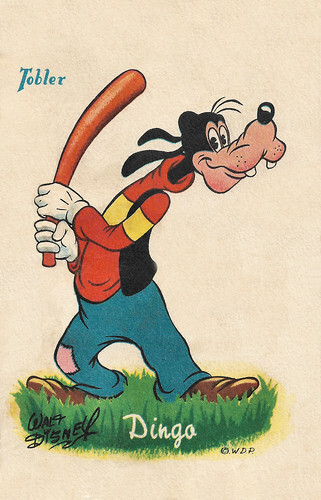
French postcard by Tobler. Image: The Walt Disney Company. Goofy is known in France as Dingo.
Goofy is an animated cartoon character created by Pinto Colvig, Walt Disney and Tom Palmer. Goofy is Mickey Mouse's best friend, an anthropomorphic dog whose appearance is based on the Australian dingo. He was conceived in 1932 and made his debut in Mickey's Revue (1932). Goofy is clumsy and slow-witted, but with a good-natured disposition and is defined by his misfit garments, his rumpled hat, and his signature guffaw ("a-hyuck"). Two Goofy shorts were nominated for an Oscar: How to Play Football (1944) and Aquamania (1961).
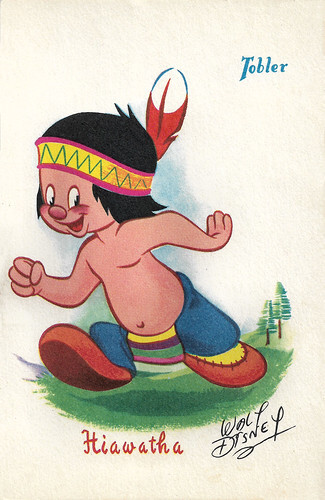
French postcard by Imp. Georges Lang, Paris, offered by Chocolats Tobler. Image: Walt Disney.
Little Hiawatha (or simply Hiawatha is a little Indian hunter who hunts for the game. He is the hero of the Silly Symphony Little Hiawatha (David Hand, 1937).
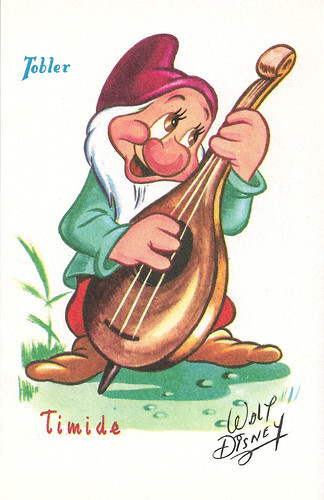
French postcard by Tobler. Image: The Walt Disney Company. Bashful in Snow White and the Seven Dwarfs (William Cottrell, David Hand, Wilfred Jackson, Larry Morey, Perce Pearce, Ben Sharpsteen, 1937).
Snow White and the Seven Dwarfs (1937) was produced by Walt Disney Productions and originally released by RKO Radio Pictures. It was the first full-length cel-animated feature film and the earliest Disney-animated feature film. Walt Disney turned the German fairy tale by the Grimm brothers into a charming family film that is still holding up very well more than 80 years later.
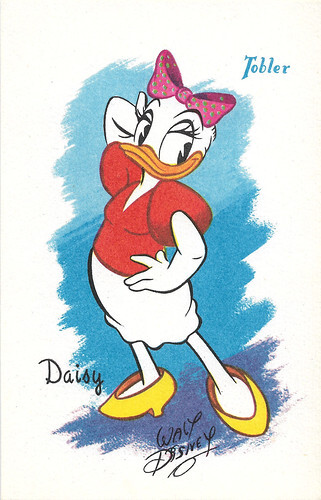
French postcard by Tobler. Image: The Walt Disney Company.
Daisy Duck is a cartoon and comic book character created in 1940 by Walt Disney Productions as the girlfriend of Donald Duck. Daisy was introduced in the short film Mr. Duck Steps Out (1940) and was incorporated into Donald's comic stories several months later. Carl Barks, the screenwriter and lead storyboard artist for the film, was inspired by the short, Don Donald (1937), which featured a Latin character named Donna Duck, to revive the concept of a female counterpart for Donald. Daisy appeared in a total of 15 films.
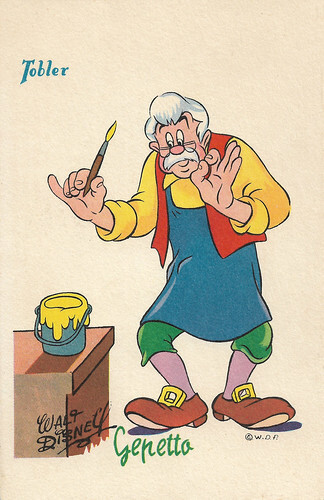
French postcard by Imp. Georges Lang, Paris, offered by Chocolats Tobler. Image: Walt Disney Productions.
The kindly, old woodcarver Geppetto is the creator of the wooden puppet Pinocchio in Disney's animation classic, Pinocchio (Hamilton Luske, Ben Sharpsteen, 1940). Per Geppetto's wish to have a son, Pinocchio is brought to life by the Blue Fairy.
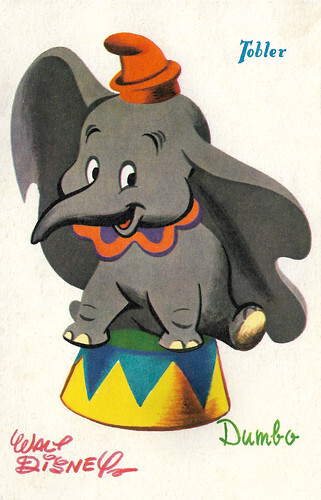
French postcard by Tobler. Image: The Walt Disney Company.
Walt Disney's Dumbo (1941) is a great animated film that deals with discrimination, self-esteem, and the importance of family and friendship. In the opening sequence, a stork delivers a baby elephant to Mrs. Jumbo, a veteran of the tough circus world. All the other elephants ridicule the newborn Jumbo for his gigantic ears. He is dubbed "Dumbo" and is shut out. After his mother has been locked up in a jaillike wagon for protecting him, Dumbo is all alone. Heartbreaking is the scene when Dumbo's mother in chains rocks him with her trunk from beyond the bars. Dumbo is relegated to the circus clown acts. It is up to his only friend, Timothy Q Mouse, to assist the little elephant to achieve his full potential. Dumbo learns that he can fly and becomes a star.
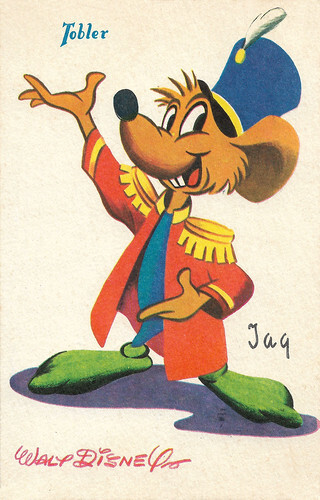
French postcard by Imp. Georges Lang, Paris, offered by Chocolats Tobler. Image: Walt Disney.
Timothy Q. Mouse is a Brooklyn-accented mouse in Disney's animated classic, Dumbo (Ben Sharpsteen, 1941). He becomes the guardian and mentor of Dumbo, the flying elephant.
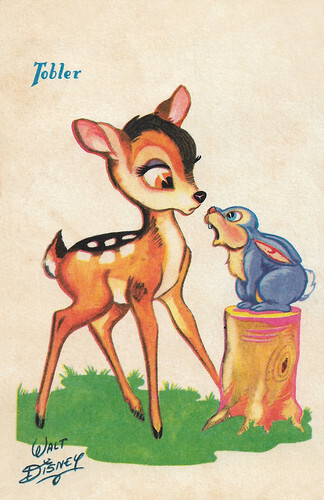
French postcard by Tobler. Image: Walt Disney.
Bambi (David Hand, 1942) was the fifth animated feature produced by Walt Disney. It is based on the book Bambi, a Life in the Woods by Austrian author Felix Salten. The film was released by RKO Radio Pictures in 1942 and received three Academy Award nominations: Best Sound (Sam Slyfield), Best Song (for Love Is a Song sung by Donald Novis), and Original Music Score.
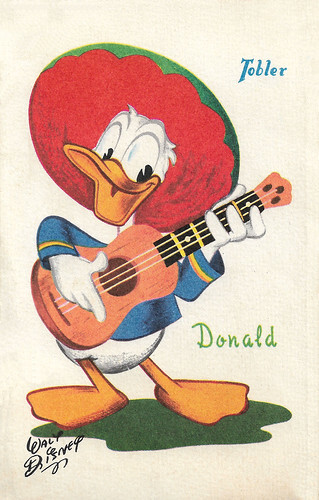
French postcard by Tobler. Image: The Walt Disney Company. Donald Duck with a sombrero like in The Three Caballeros (Norman Ferguson, Clyde Geronimi, Jack Kinney, Bill Roberts, 1944).
The Three Caballeros (Norman Ferguson, Clyde Geronimi, Jack Kinney, Bill Roberts, 1944) is an American animated musical film produced by Walt Disney Productions and released by RKO Radio Pictures. It is the seventh animated feature in the Disney Animated Canon, as well as the first animated Disney film to be a sequel (to Saludos Amigos). The film also marked Donald Duck's 10th anniversary and is the first Walt Disney feature to combine animation with live-action footage.
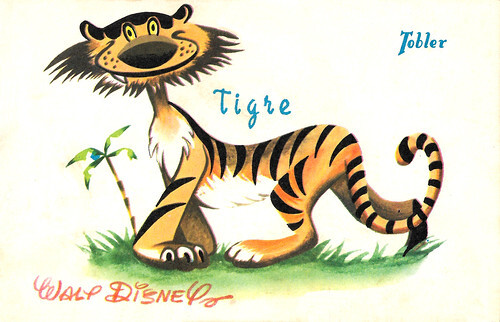
French postcard by Imp. Georges Lang, Paris, offered by Chocolats Tobler. Image: Walt Disney.
Raja, the Tiger is a Disney animated character who made his debut in the Goofy cartoon Tiger Trouble (Jack Kinney, 1945), scripted by Bill Peet. Milt Kahn did most of Raja's animation.
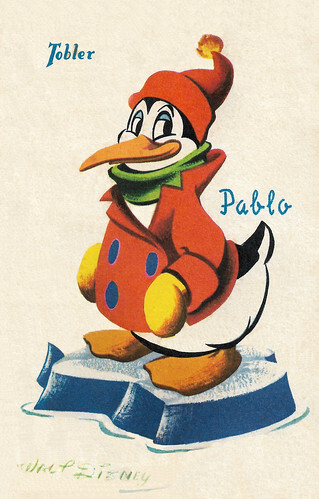
French postcard by Tobler. Image: The Walt Disney Company.
Pablo is the main character in The Cold-Blooded Penguin (Bill Roberts, 1945), a segment of Disney's animated feature film The Three Caballeros (1945), with Sterling Holloway as the narrator of his story. Pablo dislikes living in colder climates, unlike the other penguins who play with their activities as they normally do.
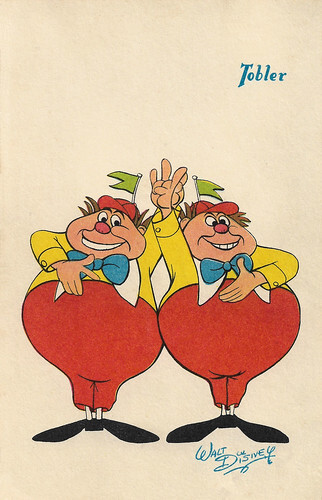
French postcard by Imp. Georges Lang, Paris, offered by Chocolats Tobler. Image: Walt Disney. Tweedle Dee and Tweedle Dum in Alice in Wonderland (Clyde Geronimi, Wilfred Jackson, Hamilton Luske, 1951).
Tweedle Dee and Tweedle Dum are minor characters in Walt Disney's animated film Alice in Wonderland (Clyde Geronimi, Wilfred Jackson, Hamilton Luske, 1951). They first appeared in an English nursery rhyme and in Lewis Carroll's 1871 book 'Through the Looking-Glass, and What Alice Found There'. They're playful and jolly, and a little annoying. Tweedle Dee and Tweedle Dum take particular delight in reciting poems and songs.
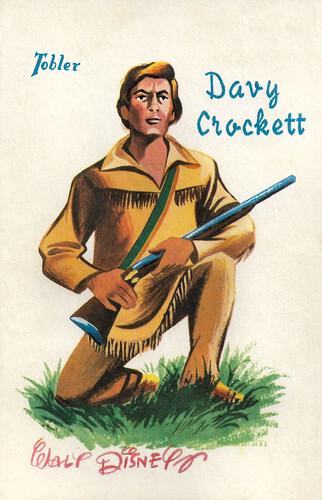
French postcard by Tobler. Image: The Walt Disney Company.
The Walt Disney feature Davy Crockett - King of the Wild Frontier (Norman Foster, 1955) was a compilation of Davy Crockett Indian Fighter and Davy Crockett at The Alamo, the 1st and 3rd of episodes of the Davy Crocket series that first aired on ABC TV's Disneyland (1954-1955). The 2nd episode, Davy Crockett Goes To Congress, was not included. The film depicts the legends (and myths) from the life of famed American frontiersman Davy Crockett (Fess Parker). Crockett and his friend George Russell (Buddy Ebsen) fight in the Creek Indian War and save the soldiers from being wiped out by the Creeks. The Appalachians of North Carolina where the Creek War skirmishes were filmed show beautiful mountain vistas and add realism to the film. Later, Crockett and Russell journey to Texas and fight with friends against the Mexican army in the famous battle at the Alamo. Originally, Buddy Ebsen was going to play Davy Crockett until Walt Disney saw Fess Parker in the Science-Fiction film Them! (Gordon Douglas. 1954). When he saw Parker, he said, "That's my Davy Crockett!"
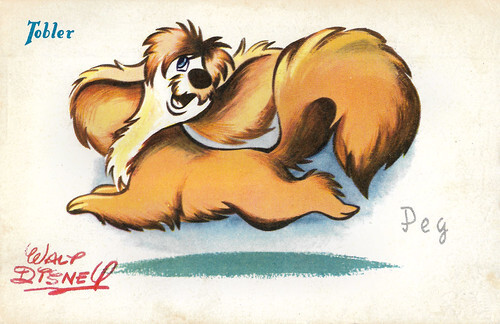
French postcard by Tobler. Image: The Walt Disney Company.
Peg is one of the animated dogs from the Dog Pound in the Disney classic Lady and the Tramp (1955). Based on Ward Greene's 1945 Cosmopolitan magazine story 'Happy Dan, the Cynical Dog', the film was directed by Hamilton Luske, Clyde Geronimi, and Wilfred Jackson. Peg is named after and slightly resembles her voice actress, Peggy Lee.
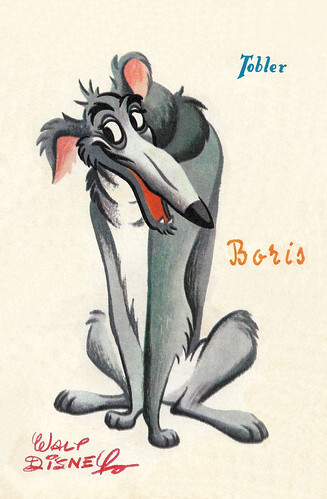
French postcard by Tobler. Image: The Walt Disney Company.
Boris is a minor protagonist and one of the dogs from the Dog Pound in Lady and the Tramp (1955), an American animated film produced by Walt Disney. Based on Ward Greene's Cosmopolitan magazine story 'Happy Dan, the Cynical Dog' (1945), it was directed by Hamilton Luske, Clyde Geronimi, and Wilfred Jackson. It is Disney's fifteenth major animated film.
Earlier EFSP posts on the Tobler series were Disney by Tobler, Part 1 and Disney by Tobler, Part 2.

French postcard by Tobler. Image: Walt Disney. The French name of Puss in Boots is Chat botté.
Puss in Boots refers to a 1922 film directed by Walt Disney. The film was based on the story initially written by Giovanni Francesco Straparola and later retold by Charles Perrault.

French postcard by Tobler. Image: The Walt Disney Company.
Minnie Mouse is an animated character who appears in several Disney productions, both comics and animated films. She is Mickey Mouse's longtime sweetheart and made her debut in 1928 with Mickey. Minnie Mouse wears white gloves, a red or pink bow, a blue (or pink or red) polka-dotted dress, white bloomers and yellow low-heeled shoes occasionally with ribbons on them.

French postcard by Tobler. Image: The Walt Disney Company.
Pluto is an American cartoon character created by Walt Disney. He is a yellow-orange colour, medium-sized, short-haired dog with black ears. Unlike most Disney characters, Pluto is not anthropomorphic beyond some characteristics such as facial expression. The playful and often distracted dog first appeared in the cartoon The Chain Gang (1930).

French postcard by Tobler. Image: The Walt Disney Company. Goofy is known in France as Dingo.
Goofy is an animated cartoon character created by Pinto Colvig, Walt Disney and Tom Palmer. Goofy is Mickey Mouse's best friend, an anthropomorphic dog whose appearance is based on the Australian dingo. He was conceived in 1932 and made his debut in Mickey's Revue (1932). Goofy is clumsy and slow-witted, but with a good-natured disposition and is defined by his misfit garments, his rumpled hat, and his signature guffaw ("a-hyuck"). Two Goofy shorts were nominated for an Oscar: How to Play Football (1944) and Aquamania (1961).

French postcard by Imp. Georges Lang, Paris, offered by Chocolats Tobler. Image: Walt Disney.
Little Hiawatha (or simply Hiawatha is a little Indian hunter who hunts for the game. He is the hero of the Silly Symphony Little Hiawatha (David Hand, 1937).

French postcard by Tobler. Image: The Walt Disney Company. Bashful in Snow White and the Seven Dwarfs (William Cottrell, David Hand, Wilfred Jackson, Larry Morey, Perce Pearce, Ben Sharpsteen, 1937).
Snow White and the Seven Dwarfs (1937) was produced by Walt Disney Productions and originally released by RKO Radio Pictures. It was the first full-length cel-animated feature film and the earliest Disney-animated feature film. Walt Disney turned the German fairy tale by the Grimm brothers into a charming family film that is still holding up very well more than 80 years later.

French postcard by Tobler. Image: The Walt Disney Company.
Daisy Duck is a cartoon and comic book character created in 1940 by Walt Disney Productions as the girlfriend of Donald Duck. Daisy was introduced in the short film Mr. Duck Steps Out (1940) and was incorporated into Donald's comic stories several months later. Carl Barks, the screenwriter and lead storyboard artist for the film, was inspired by the short, Don Donald (1937), which featured a Latin character named Donna Duck, to revive the concept of a female counterpart for Donald. Daisy appeared in a total of 15 films.

French postcard by Imp. Georges Lang, Paris, offered by Chocolats Tobler. Image: Walt Disney Productions.
The kindly, old woodcarver Geppetto is the creator of the wooden puppet Pinocchio in Disney's animation classic, Pinocchio (Hamilton Luske, Ben Sharpsteen, 1940). Per Geppetto's wish to have a son, Pinocchio is brought to life by the Blue Fairy.

French postcard by Tobler. Image: The Walt Disney Company.
Walt Disney's Dumbo (1941) is a great animated film that deals with discrimination, self-esteem, and the importance of family and friendship. In the opening sequence, a stork delivers a baby elephant to Mrs. Jumbo, a veteran of the tough circus world. All the other elephants ridicule the newborn Jumbo for his gigantic ears. He is dubbed "Dumbo" and is shut out. After his mother has been locked up in a jaillike wagon for protecting him, Dumbo is all alone. Heartbreaking is the scene when Dumbo's mother in chains rocks him with her trunk from beyond the bars. Dumbo is relegated to the circus clown acts. It is up to his only friend, Timothy Q Mouse, to assist the little elephant to achieve his full potential. Dumbo learns that he can fly and becomes a star.

French postcard by Imp. Georges Lang, Paris, offered by Chocolats Tobler. Image: Walt Disney.
Timothy Q. Mouse is a Brooklyn-accented mouse in Disney's animated classic, Dumbo (Ben Sharpsteen, 1941). He becomes the guardian and mentor of Dumbo, the flying elephant.

French postcard by Tobler. Image: Walt Disney.
Bambi (David Hand, 1942) was the fifth animated feature produced by Walt Disney. It is based on the book Bambi, a Life in the Woods by Austrian author Felix Salten. The film was released by RKO Radio Pictures in 1942 and received three Academy Award nominations: Best Sound (Sam Slyfield), Best Song (for Love Is a Song sung by Donald Novis), and Original Music Score.

French postcard by Tobler. Image: The Walt Disney Company. Donald Duck with a sombrero like in The Three Caballeros (Norman Ferguson, Clyde Geronimi, Jack Kinney, Bill Roberts, 1944).
The Three Caballeros (Norman Ferguson, Clyde Geronimi, Jack Kinney, Bill Roberts, 1944) is an American animated musical film produced by Walt Disney Productions and released by RKO Radio Pictures. It is the seventh animated feature in the Disney Animated Canon, as well as the first animated Disney film to be a sequel (to Saludos Amigos). The film also marked Donald Duck's 10th anniversary and is the first Walt Disney feature to combine animation with live-action footage.

French postcard by Imp. Georges Lang, Paris, offered by Chocolats Tobler. Image: Walt Disney.
Raja, the Tiger is a Disney animated character who made his debut in the Goofy cartoon Tiger Trouble (Jack Kinney, 1945), scripted by Bill Peet. Milt Kahn did most of Raja's animation.

French postcard by Tobler. Image: The Walt Disney Company.
Pablo is the main character in The Cold-Blooded Penguin (Bill Roberts, 1945), a segment of Disney's animated feature film The Three Caballeros (1945), with Sterling Holloway as the narrator of his story. Pablo dislikes living in colder climates, unlike the other penguins who play with their activities as they normally do.

French postcard by Imp. Georges Lang, Paris, offered by Chocolats Tobler. Image: Walt Disney. Tweedle Dee and Tweedle Dum in Alice in Wonderland (Clyde Geronimi, Wilfred Jackson, Hamilton Luske, 1951).
Tweedle Dee and Tweedle Dum are minor characters in Walt Disney's animated film Alice in Wonderland (Clyde Geronimi, Wilfred Jackson, Hamilton Luske, 1951). They first appeared in an English nursery rhyme and in Lewis Carroll's 1871 book 'Through the Looking-Glass, and What Alice Found There'. They're playful and jolly, and a little annoying. Tweedle Dee and Tweedle Dum take particular delight in reciting poems and songs.

French postcard by Tobler. Image: The Walt Disney Company.
The Walt Disney feature Davy Crockett - King of the Wild Frontier (Norman Foster, 1955) was a compilation of Davy Crockett Indian Fighter and Davy Crockett at The Alamo, the 1st and 3rd of episodes of the Davy Crocket series that first aired on ABC TV's Disneyland (1954-1955). The 2nd episode, Davy Crockett Goes To Congress, was not included. The film depicts the legends (and myths) from the life of famed American frontiersman Davy Crockett (Fess Parker). Crockett and his friend George Russell (Buddy Ebsen) fight in the Creek Indian War and save the soldiers from being wiped out by the Creeks. The Appalachians of North Carolina where the Creek War skirmishes were filmed show beautiful mountain vistas and add realism to the film. Later, Crockett and Russell journey to Texas and fight with friends against the Mexican army in the famous battle at the Alamo. Originally, Buddy Ebsen was going to play Davy Crockett until Walt Disney saw Fess Parker in the Science-Fiction film Them! (Gordon Douglas. 1954). When he saw Parker, he said, "That's my Davy Crockett!"

French postcard by Tobler. Image: The Walt Disney Company.
Peg is one of the animated dogs from the Dog Pound in the Disney classic Lady and the Tramp (1955). Based on Ward Greene's 1945 Cosmopolitan magazine story 'Happy Dan, the Cynical Dog', the film was directed by Hamilton Luske, Clyde Geronimi, and Wilfred Jackson. Peg is named after and slightly resembles her voice actress, Peggy Lee.

French postcard by Tobler. Image: The Walt Disney Company.
Boris is a minor protagonist and one of the dogs from the Dog Pound in Lady and the Tramp (1955), an American animated film produced by Walt Disney. Based on Ward Greene's Cosmopolitan magazine story 'Happy Dan, the Cynical Dog' (1945), it was directed by Hamilton Luske, Clyde Geronimi, and Wilfred Jackson. It is Disney's fifteenth major animated film.
Earlier EFSP posts on the Tobler series were Disney by Tobler, Part 1 and Disney by Tobler, Part 2.
Published on December 26, 2024 22:00
December 25, 2024
Christus (1916)
On the 2nd Day of Christmas, a post on the Italian silent film Christus/Christ (1916). This Cines production directed by count Giulio Antamoro and filmed in Palestine and Egypt was a worldwide success. Alberto Pasquali played Jesus and Leda Gys played Mary.
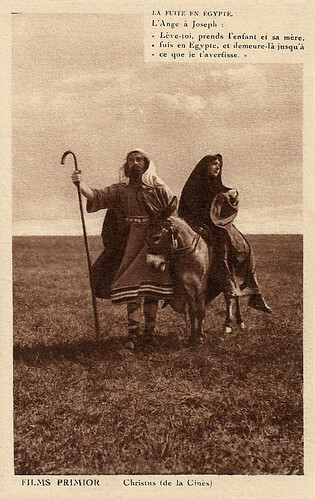
French postcard by Les Films Primior, Paris. Photo: Cines. Publicity still for Christus (Giulio Antamoro, 1916). Translation of the caption: 'The Flight to Egypt: Get up, take your child and his mother, fly to Egypt and stay there until I warn you.'
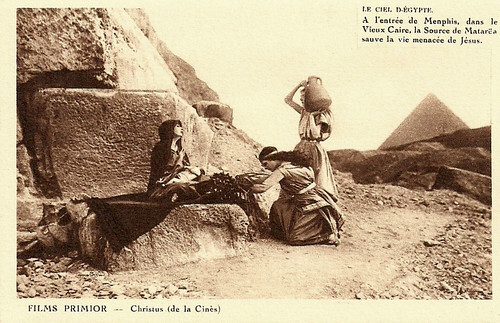
French postcard by Les Films Primior, Paris. Photo: Cines. Publicity still for Christus (Giulio Antamoro, 1916). Caption: 'The Sky over Egypt. At the entrance of Memphis, in Old Cairo, the Well of Matarea saves the menaced life of Jesus.'
Shot on location
In 1915-1916, so right in the middle of the First World War, Italian director Count Giulio Cesare Antamoro went to Palestine and Egypt, on behalf of the film company Cines. He went there with a crew and an impressive cast to film Christ (1916).
Earlier, the Kalem production From the Manger to the Cross (Sidney Olcott, 1912) had faithfully reproduced the sketches by James Tissot, drawn on location in Egypt and Palestine.
Antamoro wanted to film the life of Christ on location. His Christus (1916) became a worldwide success, because of the quotations from famous artworks such as Fra Angelico's 'Annunciation', Leonardo da Vinci's 'Last Supper' and Michelangelo's 'Pietà', but also because of the location shots.
The press drew a direct relationship between the authenticity of Giulio Antamoro's film and that of the earlier sketches by James Tissot.
Even more than in the Kalem production, the Cines crew exploited the monuments and scenery in Egypt for the film, bending the Biblical tales to make it more spectacular.
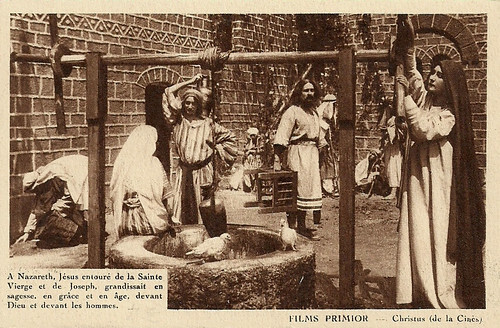
French postcard by Les Films Primior, Paris. Photo: Cines. Publicity still for Christus (Giulio Antamoro, 1916). Caption: 'In Nazareth, surrounded by the Holy Virgin and Joseph, Jesus grows up in wisdom, in grace and in age, before God and before mankind.' On the right, Leda Gys plays the Holy Virgin.
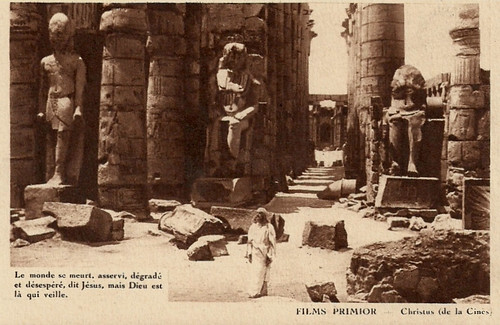
French postcard by Les Films Primior, Paris. Photo: Cines. Alberto Pasquali as Jesus in Christus (Giulio Antamoro, 1916). Caption: 'The world is dying, oppressed, degraded and in despair, Jesus, says, but God is there who guards.'
The holy family
Arriving in Egypt after their Flight from Jerusalem, the Holy Family passes the pyramids of Gizeh and the famous Sphinx in Christ (1916).
We notice Mary in Memphis under Cairo, where she receives food and drinks after the Flight to Egypt. Afterwards, we see the Holy Family near a row of sphinxes at Karnak.
Later in the film, when Jesus has grown up, he reflects on the decay of the world. Director Giulio Antamoro then shows Jesus (Alberto Pasquali) walking through the majestic ruins of Luxor.
There is no Biblical reason for this scene, but Giulio Antamoro thus combines literal decay with spiritual decay. Besides, in 1915-1916 there were more ancient buildings in Egypt than in Palestine to exploit, and thus Antamoro used Egypt's monumentality.
For the average cinema visitor in Europe during the First World War, the vision of ancient ruins must have created associations with the modern ruins in Northern France and Belgium, daily visible in cinema newsreels.
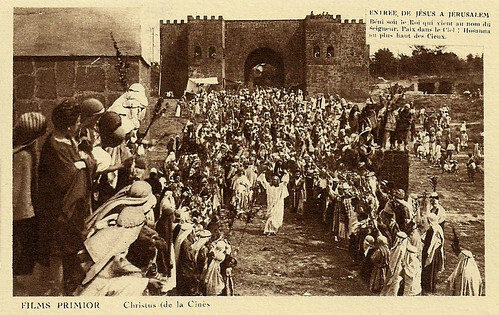
French postcard by Films Primior, Paris. Photo: Cines. Publicity still for Christus (Giulio Antamoro, 1916). Entry of Christ into Jerusalem. On Palm Sunday, the Sunday before Easter, Christians celebrate Christ's triumphant entry into Jerusalem.
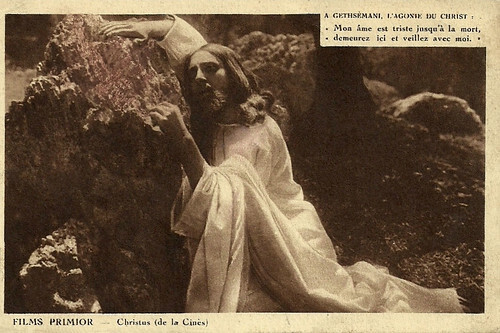
French postcard by Films Primior, Paris. Photo: Cines. Publicity still for Christus (Giulio Antamoro, 1916). Christ (Alberto Pasquali) agonising in the gardens of Gethsemane.
Additional shooting
The leading roles in Christus (1916) were acted by Alberto Pasquali (Christ), Leda Gys (Mary), Amleto Novelli (Pilate), and Augusto Mastripietri (Judas), while Renato Visca played the young Jesus.
When additional shooting was necessary in 1916, Enrico Guazzoni, the director of Quo Vadis? (1912), Marcantonio e Cleopatra (1913) and Cajus Julius Caesar (1914), was in charge, while Antamoro wasn't available anymore.
Janiss Garza at AllMovie reviewed the result as: "static, pretentious and dated (yes, even for 1917 (sic)). In addition, the titles - at least in the English version - were long and wordy, which was anathema to moviegoers of the 'teens."
However, Christus (1916) was an international success. A tagline read: "Greatest screen success Europe has known is acclaimed with new honours in America." Two other films with the same title were released in 1914 and 1919 but both are missing now.
Cines' Christus was eventually restored by producer Goffredo Lombardo, the founder of Titanus and the son of Leda Gys . The restored film was shown at the 2000 Venice Film Festival.
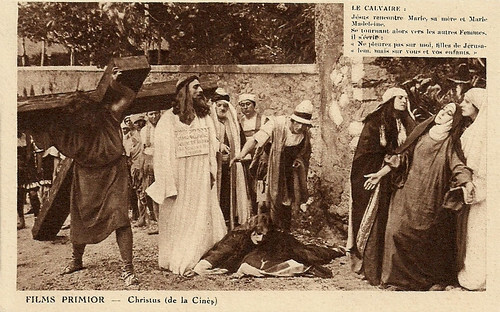
French postcard by Les Films Primior, Paris. Christ towards Mount Calvary and the Crucifixion. While Simon of Cyrene is carrying the cross, Jesus (Alberto Pasquali) meets his mother Mary ( Leda Gys ) and Mary Magdalene (Aurelia Cattaneo), on the way to Mount Calvary. Translation of the caption: 'The Calvary: Jesus meets his mother Mary and Mary Magdalene. Turning towards the other women, he speaks: Don't weep for me, daughters of Jerusalem, but for you and your children.'
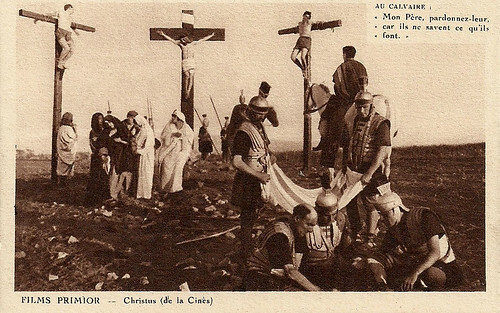
French postcard by Films Primior, Paris. Christ's Crucifixion on Mount Calvary. Translation of the caption: 'Father, forgive them, for they know not what they do.'
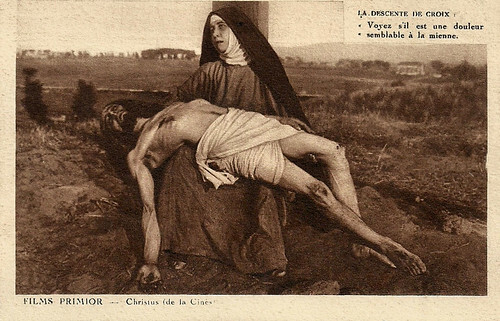
French postcard by Films Primior, Paris. The Pietà with Jesus (Alberto Pasquali) and Mary ( Leda Gys ). Translation of the caption: 'The descent of the cross. See if there is any sorrow like mine.'
Sources: Janiss Garza (AllMovie - page now defunct), Mario Gauci (IMDb - page now defunct) and IMDb.

French postcard by Les Films Primior, Paris. Photo: Cines. Publicity still for Christus (Giulio Antamoro, 1916). Translation of the caption: 'The Flight to Egypt: Get up, take your child and his mother, fly to Egypt and stay there until I warn you.'

French postcard by Les Films Primior, Paris. Photo: Cines. Publicity still for Christus (Giulio Antamoro, 1916). Caption: 'The Sky over Egypt. At the entrance of Memphis, in Old Cairo, the Well of Matarea saves the menaced life of Jesus.'
Shot on location
In 1915-1916, so right in the middle of the First World War, Italian director Count Giulio Cesare Antamoro went to Palestine and Egypt, on behalf of the film company Cines. He went there with a crew and an impressive cast to film Christ (1916).
Earlier, the Kalem production From the Manger to the Cross (Sidney Olcott, 1912) had faithfully reproduced the sketches by James Tissot, drawn on location in Egypt and Palestine.
Antamoro wanted to film the life of Christ on location. His Christus (1916) became a worldwide success, because of the quotations from famous artworks such as Fra Angelico's 'Annunciation', Leonardo da Vinci's 'Last Supper' and Michelangelo's 'Pietà', but also because of the location shots.
The press drew a direct relationship between the authenticity of Giulio Antamoro's film and that of the earlier sketches by James Tissot.
Even more than in the Kalem production, the Cines crew exploited the monuments and scenery in Egypt for the film, bending the Biblical tales to make it more spectacular.

French postcard by Les Films Primior, Paris. Photo: Cines. Publicity still for Christus (Giulio Antamoro, 1916). Caption: 'In Nazareth, surrounded by the Holy Virgin and Joseph, Jesus grows up in wisdom, in grace and in age, before God and before mankind.' On the right, Leda Gys plays the Holy Virgin.

French postcard by Les Films Primior, Paris. Photo: Cines. Alberto Pasquali as Jesus in Christus (Giulio Antamoro, 1916). Caption: 'The world is dying, oppressed, degraded and in despair, Jesus, says, but God is there who guards.'
The holy family
Arriving in Egypt after their Flight from Jerusalem, the Holy Family passes the pyramids of Gizeh and the famous Sphinx in Christ (1916).
We notice Mary in Memphis under Cairo, where she receives food and drinks after the Flight to Egypt. Afterwards, we see the Holy Family near a row of sphinxes at Karnak.
Later in the film, when Jesus has grown up, he reflects on the decay of the world. Director Giulio Antamoro then shows Jesus (Alberto Pasquali) walking through the majestic ruins of Luxor.
There is no Biblical reason for this scene, but Giulio Antamoro thus combines literal decay with spiritual decay. Besides, in 1915-1916 there were more ancient buildings in Egypt than in Palestine to exploit, and thus Antamoro used Egypt's monumentality.
For the average cinema visitor in Europe during the First World War, the vision of ancient ruins must have created associations with the modern ruins in Northern France and Belgium, daily visible in cinema newsreels.

French postcard by Films Primior, Paris. Photo: Cines. Publicity still for Christus (Giulio Antamoro, 1916). Entry of Christ into Jerusalem. On Palm Sunday, the Sunday before Easter, Christians celebrate Christ's triumphant entry into Jerusalem.

French postcard by Films Primior, Paris. Photo: Cines. Publicity still for Christus (Giulio Antamoro, 1916). Christ (Alberto Pasquali) agonising in the gardens of Gethsemane.
Additional shooting
The leading roles in Christus (1916) were acted by Alberto Pasquali (Christ), Leda Gys (Mary), Amleto Novelli (Pilate), and Augusto Mastripietri (Judas), while Renato Visca played the young Jesus.
When additional shooting was necessary in 1916, Enrico Guazzoni, the director of Quo Vadis? (1912), Marcantonio e Cleopatra (1913) and Cajus Julius Caesar (1914), was in charge, while Antamoro wasn't available anymore.
Janiss Garza at AllMovie reviewed the result as: "static, pretentious and dated (yes, even for 1917 (sic)). In addition, the titles - at least in the English version - were long and wordy, which was anathema to moviegoers of the 'teens."
However, Christus (1916) was an international success. A tagline read: "Greatest screen success Europe has known is acclaimed with new honours in America." Two other films with the same title were released in 1914 and 1919 but both are missing now.
Cines' Christus was eventually restored by producer Goffredo Lombardo, the founder of Titanus and the son of Leda Gys . The restored film was shown at the 2000 Venice Film Festival.

French postcard by Les Films Primior, Paris. Christ towards Mount Calvary and the Crucifixion. While Simon of Cyrene is carrying the cross, Jesus (Alberto Pasquali) meets his mother Mary ( Leda Gys ) and Mary Magdalene (Aurelia Cattaneo), on the way to Mount Calvary. Translation of the caption: 'The Calvary: Jesus meets his mother Mary and Mary Magdalene. Turning towards the other women, he speaks: Don't weep for me, daughters of Jerusalem, but for you and your children.'

French postcard by Films Primior, Paris. Christ's Crucifixion on Mount Calvary. Translation of the caption: 'Father, forgive them, for they know not what they do.'

French postcard by Films Primior, Paris. The Pietà with Jesus (Alberto Pasquali) and Mary ( Leda Gys ). Translation of the caption: 'The descent of the cross. See if there is any sorrow like mine.'
Sources: Janiss Garza (AllMovie - page now defunct), Mario Gauci (IMDb - page now defunct) and IMDb.
Published on December 25, 2024 22:00
December 24, 2024
Christmas 2024 with the stars
We wish you all: Gelukkig kerstfeest! Frohe Weihnachten! God Jul! Joyeux Noël! ¡Feliz Navidad! Buon Natale! Feliz Natal! Sretan Božić! Веселого Різдва! Καλά Χριστούγεννα! Boldog karácsonyt! Gleðileg jól! Nollaig Shona! Priecīgus Ziemassvētkus! Linksmų Kalėdų! Среќен Божиќ God jul! Wesołych Świąt! Crăciun fericit! С Рождеством Срећан Божић veselé Vianoce! Vesel božič! Nadolig Llawen! Gëzuar Krishtlindjet! Eguberri! Merry Christmas!
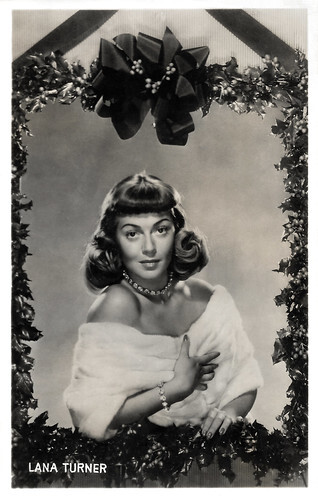
Dutch postcard, no. 123. Photo: Metro-Goldwyn-Mayer.
Blonde and voluptuous Lana Turner (1921-1995) was one of the most glamorous superstars of Hollywood's golden era. In the mid-1940s, she was one of the highest-paid women in the United States, and one of MGM's biggest stars, with her films earning the studio over $50 million during her eighteen-year contract with them. Unfortunately, her tumultuous private life sometimes overshadowed her professional accomplishments.
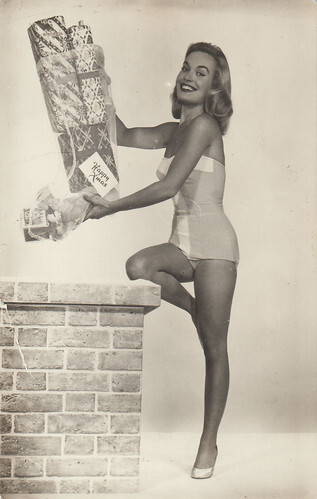
Spanish postcard by Ediciones Europacolor, no. 240. Collection: Marlene Pilaete.
Stunning Shirley Eaton (1937) played a cockney bombshell in British films throughout the 1950s and 1960s. She became famous as golden girl Jill Masterson in the third 007 adventure Goldfinger (1964). Five years later, Eaton retired.
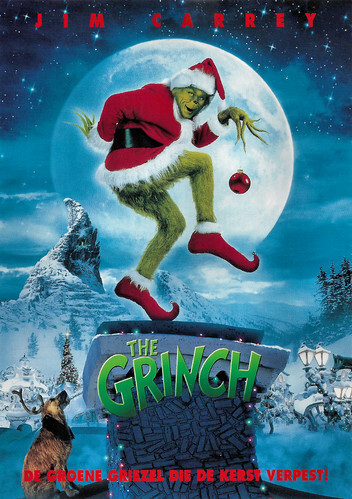
Dutch postcard by Imagine / United International Pictures (UIP). Photo: Universal. Jim Carrey as The Grinch in How the Grinch Stole Christmas (Ron Howard, 2000). Caption: De groene griezel die de kerst verpest (The green creep that crushes Christmas).
Arguably the top screen comedian of the 1990s, Canadian-born entertainer Jim Carrey (1962) has combined equal parts of his idol Jerry Lewis, his spiritual ancestor Harry Ritz, and the loose-limbed Ray Bolger into a gleefully uninhibited screen image that is uniquely his own. He rose to fame in the sketch comedy series In Living Color (1990) and leading roles in the comedies Ace Ventura: Pet Detective (1994), Dumb and Dumber (1994), and The Mask (1994) established him as a bankable film star.
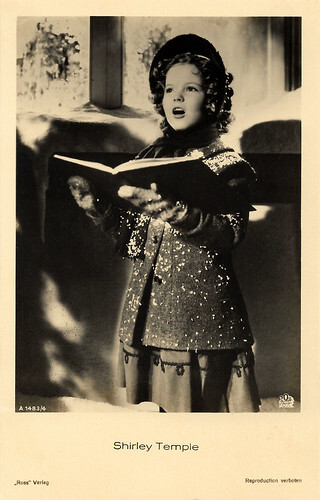
German postcard by Ross Verlag, no. A 1483/4, 1937-1938. Photo: 20th Century Fox.
Shirley Temple (1928-2014) was an American film and television actress, singer, dancer, and public servant, but everybody knows her as the most famous child star of the 1930s. Shirley could do it all: act, sing, and dance, and all at the age of five! Four years in a row, between 1935 and 1938, she was the top box-office draw for Hollywood. As an adult, she entered politics and became a diplomat, serving as United States Ambassador to Ghana and later to Czechoslovakia, and as Chief of Protocol of the United States.
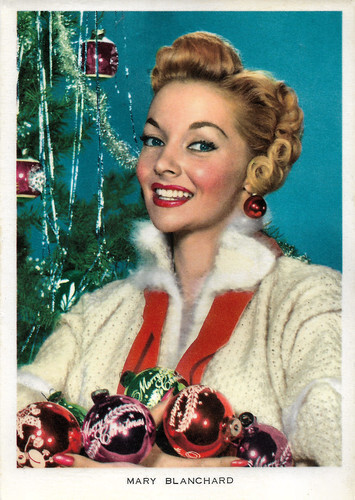
Italian postcard by Nannina, Milano.
Petite American actress Mari Blanchard (1927–1970) was known for her roles as a B movie femme fatale in American films of the 1950s and early 1960s.
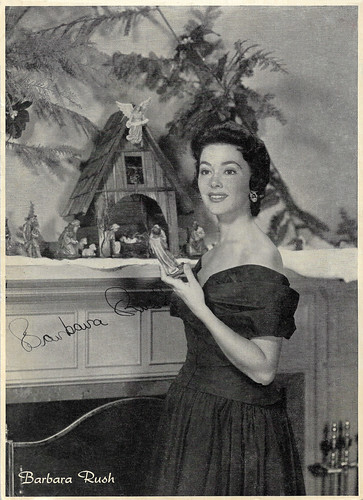
Big autograph card.
Beautiful brunette actress Barbara Rush (1927) was the epitome of poise, charm, style, and grace in Hollywood films of the 1950s. In 1954, she won the Golden Globe Award as Most Promising Female Newcomer for the Science-Fiction film It Came from Outer Space (1953). She played the female lead in such films as The Young Philadelphians, The Young Lions, and Hombre. Later in her career, Rush guest-starred on TV in such series as Peyton Place, All My Children and 7th Heaven.

French postcard by Sip, no. 2500. Caption: Reutlinger, Paris. Sent by mail in 1909. Miss Campton .
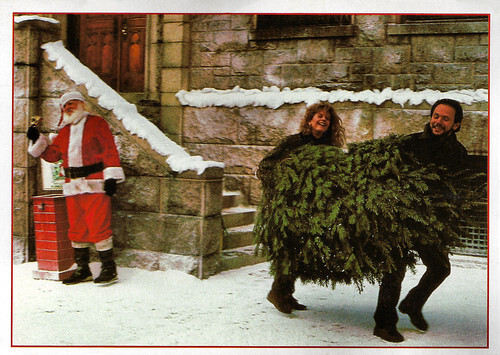
British postcard by Odeon Cinemas. Photo: Meg Ryan and Billy Crystal in When Harry met Sally... (Rob Reiner, 1989). Caption: Season's Greetings from Harry and Sally and everyone at Odeon Cinemas. The hit comedy of the year, Billy Crystal, Meg Ryan, When Harry met Sally..., a new comedy by Rob Reiner. . "A clear winner", Jonathan King - The Sun. "Touching, hilarious, honest...There hasn't been a more satisfying film this year"- 20/20. At Odeon Cinemas from Jan 5th.
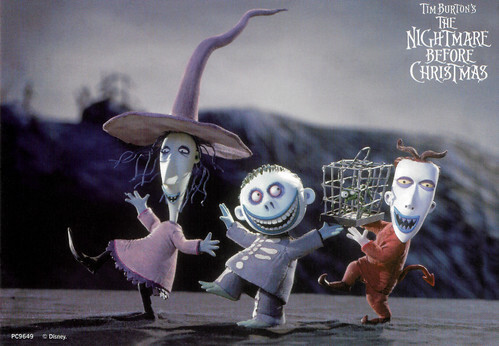
British postcard by Pyramid Posters, Leicester, no. PC 9649. Image: Disney. Spooky kids in The Nightmare Before Christmas (Henry Selick, 1993).
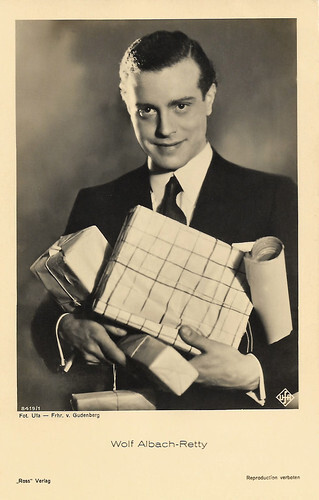
German postcard by Ross Verlag, no. 8419/1, 1933-1934. Photo: Ufa / Frhr. von Gudenberg. Wolf Albach-Retty .
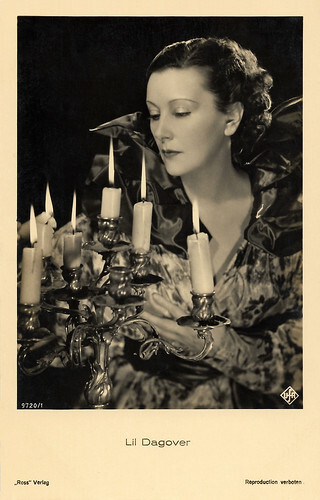
German postcard by Ross Verlag, no. 9720/1, 1935-1936. Photo: Ufa. Lil Dagover .
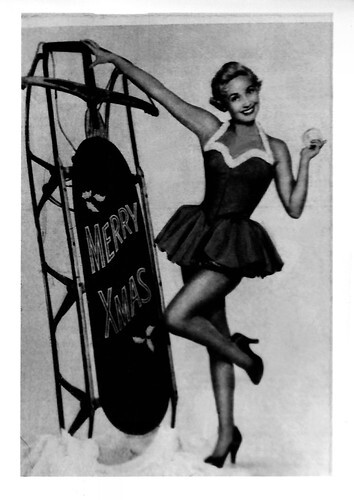
Small Dutch collectors card. Jane Powell .
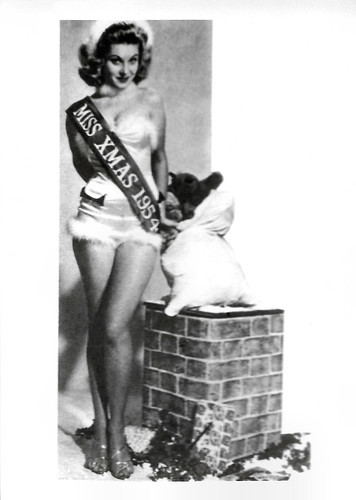
Small Dutch collectors card. Belinda Lee .
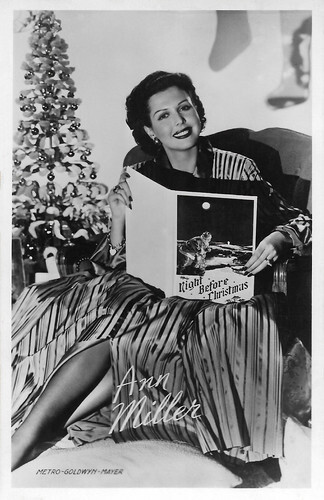
Vintage postcard, no. A.X. 292. Photo: Metro-Goldwyn-Mayer. Ann Miller .
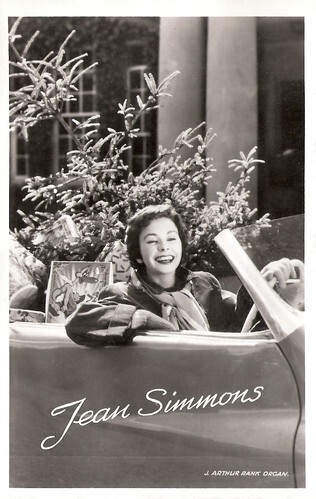
Dutch postcard by Uitg. Takken, Utrecht. Photo: J. Arthur Rank Organ. Jean Simmons .
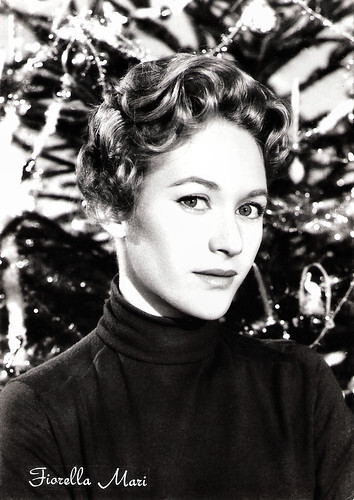
Italian postcard by Rotalfoto, Milano, no. 611.
Italian actress Forella Mari (1928) was the leading lady in a dozen European films of the 1950s. She retired at the end of the decade.
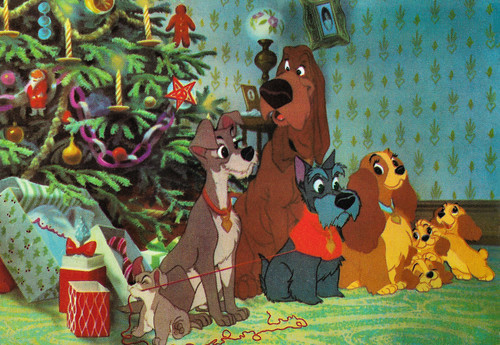
French postcard by Editions Crès, Paris, no. 202, 1964. Caption: The Reunion. Image: Walt Disney Productions. Publicity still for Lady and the Tramp (Clyde Geronimi, Wilfred Jackson, Hamilton Luske, 1955).
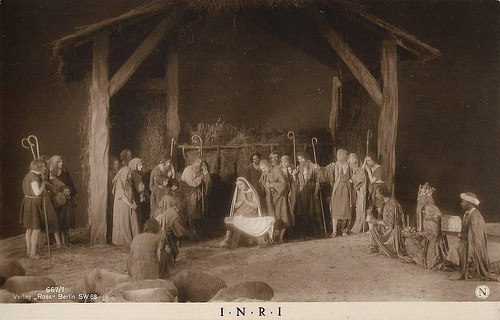
German postcard. Ross Verlag, no. 667/1. Photo: Neumann. The Nativity Scene with Henny Porten as Mary in the Biblical film I.N.R.I. (Robert Wiene, 1923).
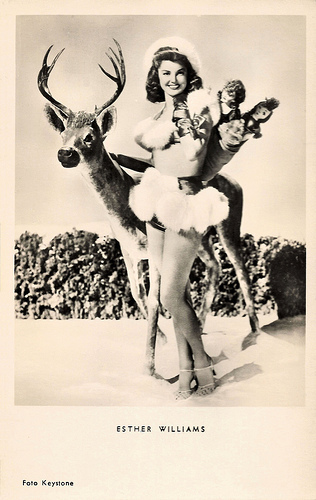
Esther Williams. German postcard by Kunst und Bild, Berlin, no. A 190. Photo: Keystone.
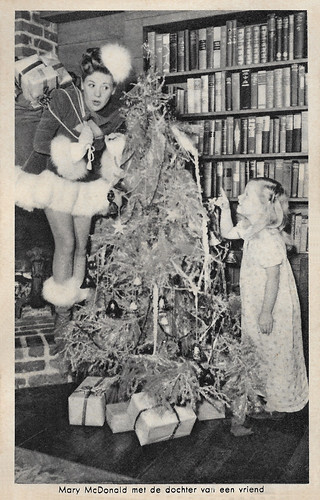
Dutch postcard. Caption: Marie McDonald with a friend's daughter.
American singer and actress Marie McDonald (1923–1965) was nicknamed 'The Body'. During World War II, she became one of Hollywood's most popular pin-up girls.
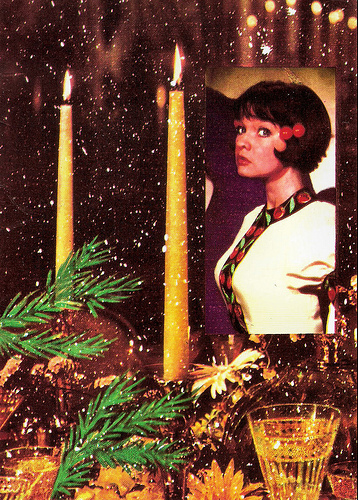
Margareta Pislaru . Romanian postcard by Casa Filmului Acin.
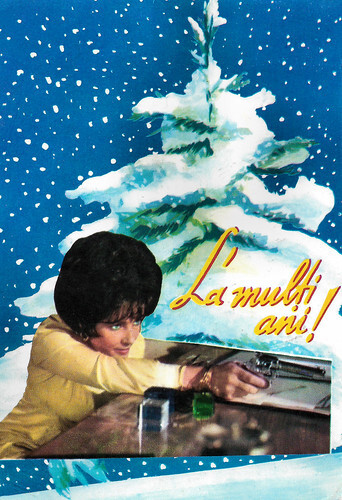
Romanian postcard by Casa Filmului Acin, no. 126. Elizabeth Taylor in The Comedians (Peter Glenville, 1967). Sent by mail in 1971.
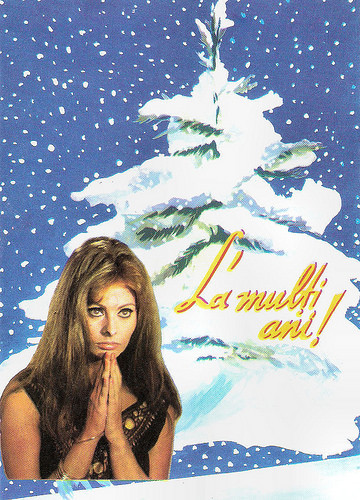
Sophia Loren . Romanian postcard by Casa Filmului Acin.
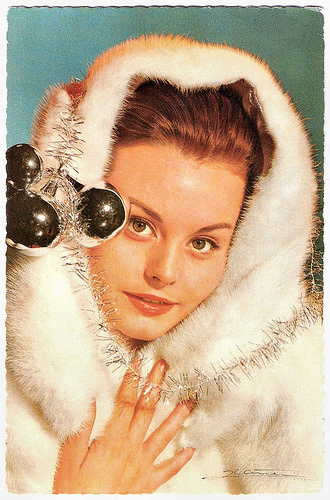
Rocío Dúrcal . Spanish postcard by Ediciones Tarjet-Fher / Ediciones Mandolina, no. 216. Photo: Epoca Films.
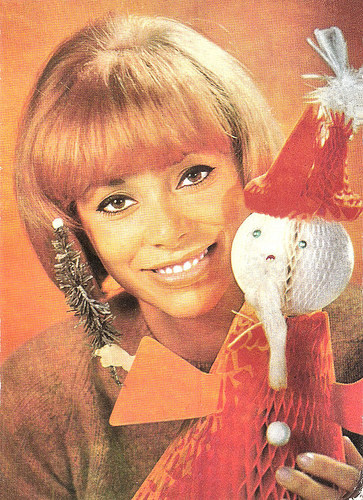
Mireille Darc . Romanian postcard by Casa Filmului Acin, no. 436.
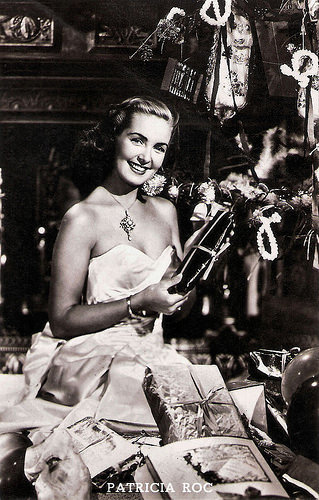
Patricia Roc . Dutch postcard. Photo: British Lion.
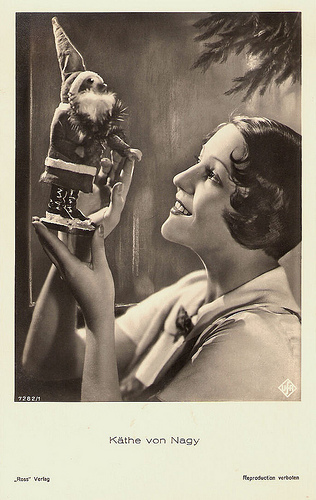
Käthe von Nagy . German postcard by Ross Verlag, no. 7282/1. Photo: Ufa. Released in Italy by Ed. Ballerini & Fratini, Firenze.
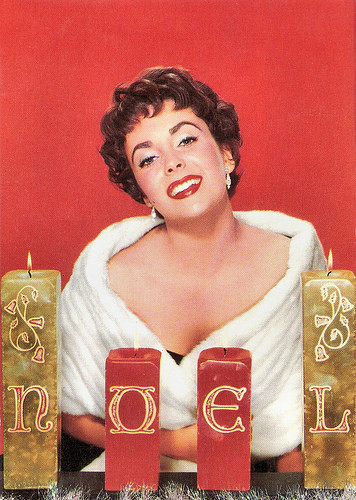
Elizabeth Taylor . French postcard by Editions P.I., Paris, no. 1051. Photo: John Everton / Ufa.
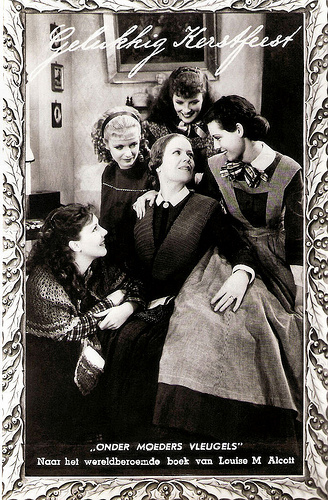
Dutch postcard by the Rialto Theatre, Amsterdam, 1934. Photo: Remaco Radio Picture. Publicity still for Little Women (George Cukor, 1933). In the picture are Katharine Hepburn , Joan Bennett , Frances Dee , Jean Parker, and Spring Byington. The Dutch title of the film and the book by Louise M. Alcott is Onder moeders vleugels.
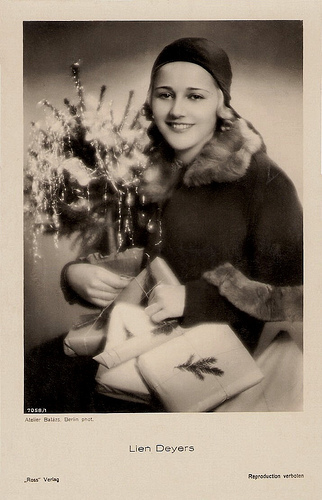
Lien Deyers . German postcard by Ross Verlag, no. 7058/1, 1932-1933. Photo: Atelier Balász, Berlin.
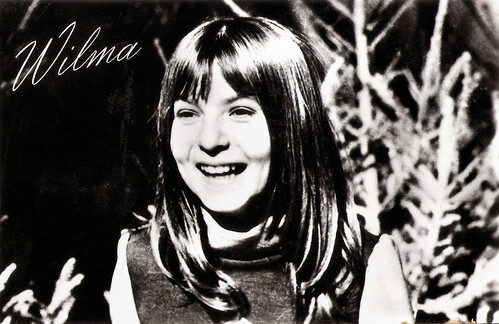
Dutch postcard by Muziek Parade, Amsterdam, no. AX 7249.
In the late 1960s and the early 1970s, sweet, little Wilma (1957) was a popular Dutch child star. At 11, she had hits in both the Netherlands and Germany and also appeared in some Schlager films.
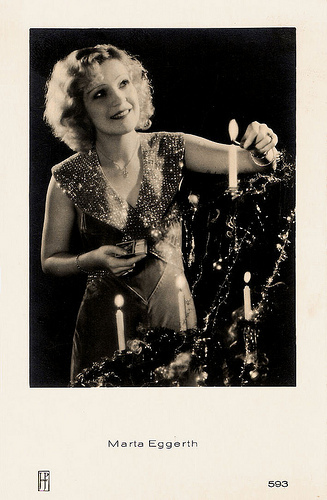
Marta Eggerth . Dutch postcard by JosPe, no. 593.
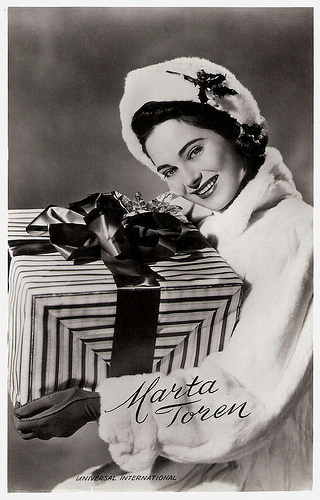
Marta Toren . Dutch postcard, no. 3374. Photo: Universal International / Fotoarchief Film en Toneel.
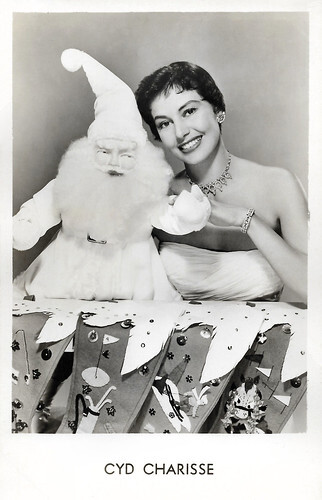
Vintage postcard, no. 2022.
Cyd Charisse 1921-2008) was born to be a dancer. She became one of the top female dancers in the golden era of the musical. Her films include Singin' in the Rain (1952), The Band Wagon (1953), Brigadoon (1954) and Silk Stockings (1957). She was one of the few actresses to have danced with both Fred Astaire and Gene Kelly.
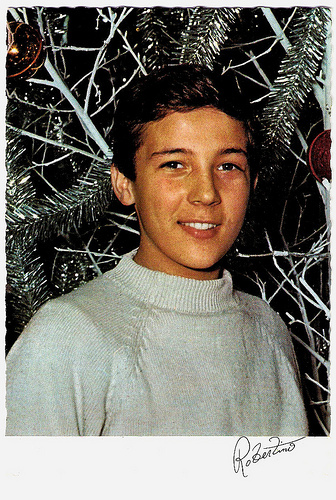
Robertino . French postcard by Editions Publistar, Marseille, no. 811. Photo: President.

Kermit. Dutch postcard by Interstat, Amsterdam. Photo: The Jim Henson Company.
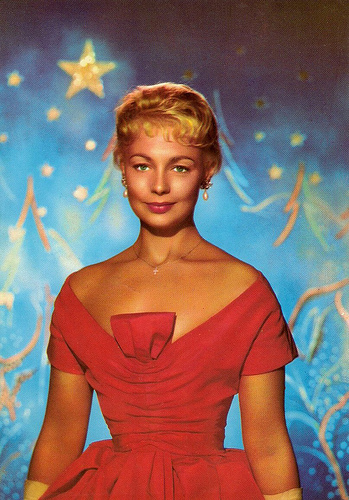
Dany Robin . French postcard by Editions P.I., Paris, no. 1004. Photo: Sam Lévin.
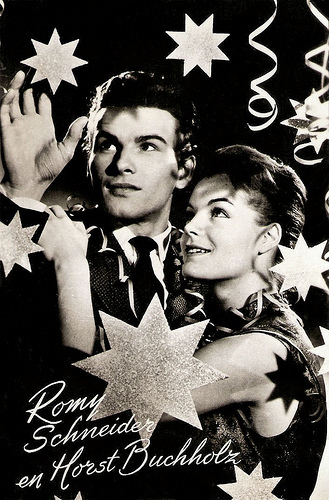
Romy Schneider & Horst Buchholz . Dutch postcard by Uitg. Takken, Utrecht, no. 3572.
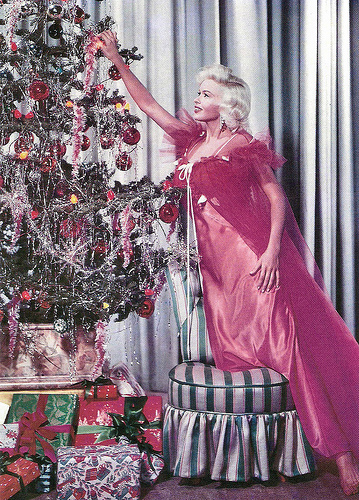
Jayne Mansfield. French postcard by Edition a la carte. Photo: Filmhistorisches Bildarchiv Peter W. Engelmeier.
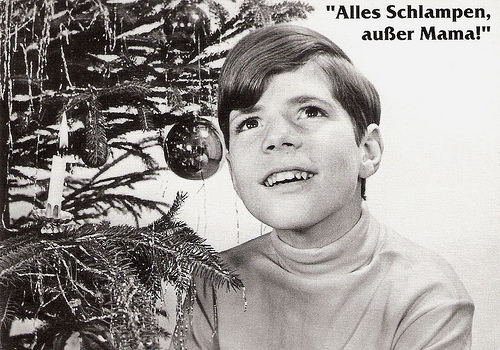
Heintje Simons . German postcard by Modern Times. Photo: Interfoto. Caption: Alles schlampen, ausser mama (All bitches, except mama).
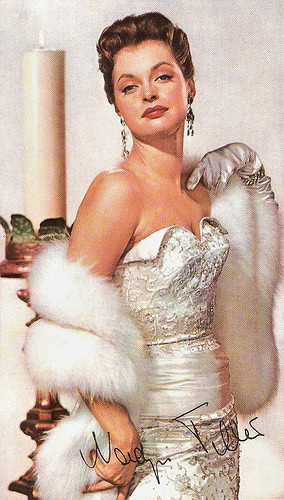
Nadja Tiller . German promotion card for Luxor.

German postcard by Rotophot in the Film Sterne series, no. 542/1. Photo: Messter-Film. Viggo Larsen in Der Sohn des Hannibal/The Son of Hannibal (Viggo Larsen, 1918).
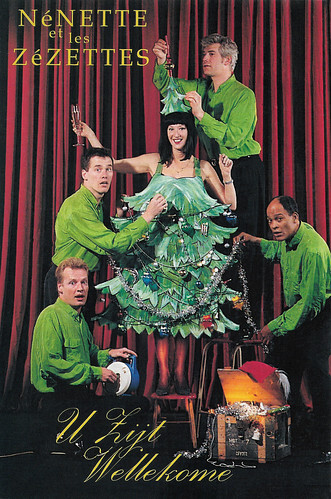
Dutch postcard by Het Maastheater, Rotterdam. Photo: Hans de Jong, Rotterdam. Caption: Nénette et Les Zezettes. You are welcome.
Loes Luca (1953) is a Dutch actress and comedienne known for the act Nénette et les Zézettes and for comedy films such as Abel/Voyeur (1986), Ja zuster, nee zuster/Yes Nurse! No Nurse! (2002), De Marathon (2012), Huisvrouwen bestaan niet/No Such Thing as Housewives (2017), Mi vida/My Life (2019) and Ome Cor (2022).
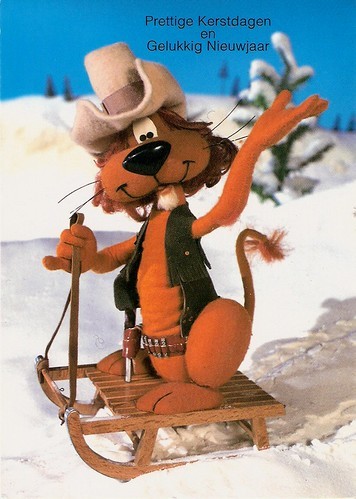
Dutch postcard by Gebr. Spanjersberg, Capelle ad IJssel / Brasschaat. Image: Joop Geesink's Dollywood, 1988. Loekie de Leeuw . Caption: Merry Christmas and Happy New Year. Sent by mail in 1989.

Dutch postcard, no. 123. Photo: Metro-Goldwyn-Mayer.
Blonde and voluptuous Lana Turner (1921-1995) was one of the most glamorous superstars of Hollywood's golden era. In the mid-1940s, she was one of the highest-paid women in the United States, and one of MGM's biggest stars, with her films earning the studio over $50 million during her eighteen-year contract with them. Unfortunately, her tumultuous private life sometimes overshadowed her professional accomplishments.

Spanish postcard by Ediciones Europacolor, no. 240. Collection: Marlene Pilaete.
Stunning Shirley Eaton (1937) played a cockney bombshell in British films throughout the 1950s and 1960s. She became famous as golden girl Jill Masterson in the third 007 adventure Goldfinger (1964). Five years later, Eaton retired.

Dutch postcard by Imagine / United International Pictures (UIP). Photo: Universal. Jim Carrey as The Grinch in How the Grinch Stole Christmas (Ron Howard, 2000). Caption: De groene griezel die de kerst verpest (The green creep that crushes Christmas).
Arguably the top screen comedian of the 1990s, Canadian-born entertainer Jim Carrey (1962) has combined equal parts of his idol Jerry Lewis, his spiritual ancestor Harry Ritz, and the loose-limbed Ray Bolger into a gleefully uninhibited screen image that is uniquely his own. He rose to fame in the sketch comedy series In Living Color (1990) and leading roles in the comedies Ace Ventura: Pet Detective (1994), Dumb and Dumber (1994), and The Mask (1994) established him as a bankable film star.

German postcard by Ross Verlag, no. A 1483/4, 1937-1938. Photo: 20th Century Fox.
Shirley Temple (1928-2014) was an American film and television actress, singer, dancer, and public servant, but everybody knows her as the most famous child star of the 1930s. Shirley could do it all: act, sing, and dance, and all at the age of five! Four years in a row, between 1935 and 1938, she was the top box-office draw for Hollywood. As an adult, she entered politics and became a diplomat, serving as United States Ambassador to Ghana and later to Czechoslovakia, and as Chief of Protocol of the United States.

Italian postcard by Nannina, Milano.
Petite American actress Mari Blanchard (1927–1970) was known for her roles as a B movie femme fatale in American films of the 1950s and early 1960s.

Big autograph card.
Beautiful brunette actress Barbara Rush (1927) was the epitome of poise, charm, style, and grace in Hollywood films of the 1950s. In 1954, she won the Golden Globe Award as Most Promising Female Newcomer for the Science-Fiction film It Came from Outer Space (1953). She played the female lead in such films as The Young Philadelphians, The Young Lions, and Hombre. Later in her career, Rush guest-starred on TV in such series as Peyton Place, All My Children and 7th Heaven.

French postcard by Sip, no. 2500. Caption: Reutlinger, Paris. Sent by mail in 1909. Miss Campton .

British postcard by Odeon Cinemas. Photo: Meg Ryan and Billy Crystal in When Harry met Sally... (Rob Reiner, 1989). Caption: Season's Greetings from Harry and Sally and everyone at Odeon Cinemas. The hit comedy of the year, Billy Crystal, Meg Ryan, When Harry met Sally..., a new comedy by Rob Reiner. . "A clear winner", Jonathan King - The Sun. "Touching, hilarious, honest...There hasn't been a more satisfying film this year"- 20/20. At Odeon Cinemas from Jan 5th.

British postcard by Pyramid Posters, Leicester, no. PC 9649. Image: Disney. Spooky kids in The Nightmare Before Christmas (Henry Selick, 1993).

German postcard by Ross Verlag, no. 8419/1, 1933-1934. Photo: Ufa / Frhr. von Gudenberg. Wolf Albach-Retty .

German postcard by Ross Verlag, no. 9720/1, 1935-1936. Photo: Ufa. Lil Dagover .

Small Dutch collectors card. Jane Powell .

Small Dutch collectors card. Belinda Lee .

Vintage postcard, no. A.X. 292. Photo: Metro-Goldwyn-Mayer. Ann Miller .

Dutch postcard by Uitg. Takken, Utrecht. Photo: J. Arthur Rank Organ. Jean Simmons .

Italian postcard by Rotalfoto, Milano, no. 611.
Italian actress Forella Mari (1928) was the leading lady in a dozen European films of the 1950s. She retired at the end of the decade.

French postcard by Editions Crès, Paris, no. 202, 1964. Caption: The Reunion. Image: Walt Disney Productions. Publicity still for Lady and the Tramp (Clyde Geronimi, Wilfred Jackson, Hamilton Luske, 1955).

German postcard. Ross Verlag, no. 667/1. Photo: Neumann. The Nativity Scene with Henny Porten as Mary in the Biblical film I.N.R.I. (Robert Wiene, 1923).

Esther Williams. German postcard by Kunst und Bild, Berlin, no. A 190. Photo: Keystone.

Dutch postcard. Caption: Marie McDonald with a friend's daughter.
American singer and actress Marie McDonald (1923–1965) was nicknamed 'The Body'. During World War II, she became one of Hollywood's most popular pin-up girls.

Margareta Pislaru . Romanian postcard by Casa Filmului Acin.

Romanian postcard by Casa Filmului Acin, no. 126. Elizabeth Taylor in The Comedians (Peter Glenville, 1967). Sent by mail in 1971.

Sophia Loren . Romanian postcard by Casa Filmului Acin.

Rocío Dúrcal . Spanish postcard by Ediciones Tarjet-Fher / Ediciones Mandolina, no. 216. Photo: Epoca Films.

Mireille Darc . Romanian postcard by Casa Filmului Acin, no. 436.

Patricia Roc . Dutch postcard. Photo: British Lion.

Käthe von Nagy . German postcard by Ross Verlag, no. 7282/1. Photo: Ufa. Released in Italy by Ed. Ballerini & Fratini, Firenze.

Elizabeth Taylor . French postcard by Editions P.I., Paris, no. 1051. Photo: John Everton / Ufa.

Dutch postcard by the Rialto Theatre, Amsterdam, 1934. Photo: Remaco Radio Picture. Publicity still for Little Women (George Cukor, 1933). In the picture are Katharine Hepburn , Joan Bennett , Frances Dee , Jean Parker, and Spring Byington. The Dutch title of the film and the book by Louise M. Alcott is Onder moeders vleugels.

Lien Deyers . German postcard by Ross Verlag, no. 7058/1, 1932-1933. Photo: Atelier Balász, Berlin.

Dutch postcard by Muziek Parade, Amsterdam, no. AX 7249.
In the late 1960s and the early 1970s, sweet, little Wilma (1957) was a popular Dutch child star. At 11, she had hits in both the Netherlands and Germany and also appeared in some Schlager films.

Marta Eggerth . Dutch postcard by JosPe, no. 593.

Marta Toren . Dutch postcard, no. 3374. Photo: Universal International / Fotoarchief Film en Toneel.

Vintage postcard, no. 2022.
Cyd Charisse 1921-2008) was born to be a dancer. She became one of the top female dancers in the golden era of the musical. Her films include Singin' in the Rain (1952), The Band Wagon (1953), Brigadoon (1954) and Silk Stockings (1957). She was one of the few actresses to have danced with both Fred Astaire and Gene Kelly.

Robertino . French postcard by Editions Publistar, Marseille, no. 811. Photo: President.

Kermit. Dutch postcard by Interstat, Amsterdam. Photo: The Jim Henson Company.

Dany Robin . French postcard by Editions P.I., Paris, no. 1004. Photo: Sam Lévin.

Romy Schneider & Horst Buchholz . Dutch postcard by Uitg. Takken, Utrecht, no. 3572.

Jayne Mansfield. French postcard by Edition a la carte. Photo: Filmhistorisches Bildarchiv Peter W. Engelmeier.

Heintje Simons . German postcard by Modern Times. Photo: Interfoto. Caption: Alles schlampen, ausser mama (All bitches, except mama).

Nadja Tiller . German promotion card for Luxor.

German postcard by Rotophot in the Film Sterne series, no. 542/1. Photo: Messter-Film. Viggo Larsen in Der Sohn des Hannibal/The Son of Hannibal (Viggo Larsen, 1918).

Dutch postcard by Het Maastheater, Rotterdam. Photo: Hans de Jong, Rotterdam. Caption: Nénette et Les Zezettes. You are welcome.
Loes Luca (1953) is a Dutch actress and comedienne known for the act Nénette et les Zézettes and for comedy films such as Abel/Voyeur (1986), Ja zuster, nee zuster/Yes Nurse! No Nurse! (2002), De Marathon (2012), Huisvrouwen bestaan niet/No Such Thing as Housewives (2017), Mi vida/My Life (2019) and Ome Cor (2022).

Dutch postcard by Gebr. Spanjersberg, Capelle ad IJssel / Brasschaat. Image: Joop Geesink's Dollywood, 1988. Loekie de Leeuw . Caption: Merry Christmas and Happy New Year. Sent by mail in 1989.
Published on December 24, 2024 22:00
December 23, 2024
Hugh Grant
With his bumbling English charm, Hugh Grant (1960) achieved international stardom in the romantic comedy Four Weddings and a Funeral (1994). The handsome Brit with his floppy hair and posh accent delivered more endearing comic performances in hits like Notting Hill (1999), Bridget Jones's Diary (2001) and About a Boy (2002). Privately, Grant also proved to have enough sense of humour to survive a media frenzy.

Italian postcard by World Collection, no. P.c. 688.
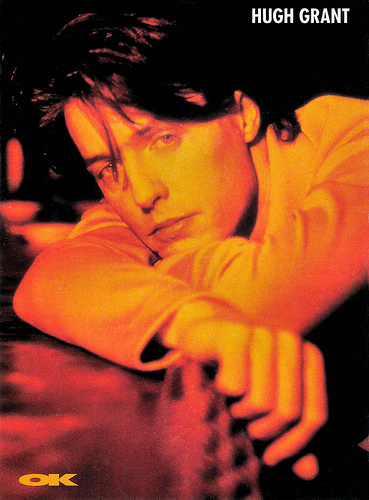
French postcard by OK Podium. Photo: J-M Graber.

British postcard by Heroes Publishing LTD, London, no. SPC 2773.
A sexually conflicted Edwardian
Hugh John Mungo Grant was born in Hammersmith, London, in 1960. He was the second son of Fynvola Susan MacLean, a schoolteacher, and James Murray Grant, a carpet sales representative. His elder brother, James Grant, is a successful banker. From 1969 to 1978, Hugh attended the independent Latymer Upper School in Hammersmith on a scholarship and played 1st XV rugby, cricket and football for the school. In 1979, he won the Galsworthy scholarship to New College, Oxford where he starred in his first film, Privileged (Michael Hoffman, 1982), produced by the Oxford University Film Foundation.
Viewing acting as nothing more than a creative outlet, he joined the Oxford University Dramatic Society and starred in a successful touring production of 'Twelfth Night' by William Shakespeare . To obtain his Equity card, he joined the Nottingham Playhouse, a regional theatre. Bored with small acting parts, he created his own comedy revue called 'The Jockeys of Norfolk' with friends Chris Lang and Andy Taylor. The group toured London's pub comedy circuit and proved a hit at the Edinburgh Festival. Their sketch on the Nativity told as an Ealing comedy, gained them a spot on the BBC2 TV show Edinburgh Nights. During this time, Grant also appeared in theatre productions of plays such as 'An Inspector Calls', Oscar Wilde's 'Lady Windermere's Fan', and Shakespeare's 'Coriolanus'.
His first leading film role came as a sexually conflicted Edwardian in Maurice (James Ivory, 1987), adapted from E. M. Forster's novel. He and co-star James Wilby shared the Volpi Cup for best actor at the Venice Film Festival for their portrayals of lovers Clive Durham and Maurice Hall. Despite such acclaim, Grant's next films were largely forgettable affairs except for The Lair of the White Worm (Ken Russell, 1988). Grant attained some cult status as a lord attempting to foil the murderous charms of a campy, trampy vampire (Amanda Donahoe). He had supporting parts in the BAFTA Award-nominated White Mischief (Michael Radford, 1987) and in Dawning (Robert Knights, 1988), opposite Anthony Hopkins .
His classic good looks made him a natural for romantic leads. He played Lord Byron in the Spanish production Remando al viento/Rowing with the Wind (Gonzalo Suárez, 1988). During the shooting of this Goya Award-winning film, Grant met model and actress Elizabeth Hurley, who was cast in a supporting role as Byron's former lover Claire Clairmont. Their subsequent relationship created much media attention. He portrayed another real-life figure, Frédéric Chopin, in Impromptu (James Lapine, 1991) opposite Judy Davis as George Sand. He also played Julie Andrews ' gay son in the ABC made-for-television film Our Sons (John Erman, 1991).
In Roman Polanski's Bitter Moon (1992), he portrayed a fastidious and proper British tourist married to Kristin Scott Thomas, who finds himself enticed by the sexual hedonism of a seductive French woman (Emmanuelle Seigner) and her embittered, paraplegic American husband (Peter Coyote). His work in the award-winning Merchant-Ivory drama The Remains of the Day (James Ivory, 1993) went largely unnoticed.
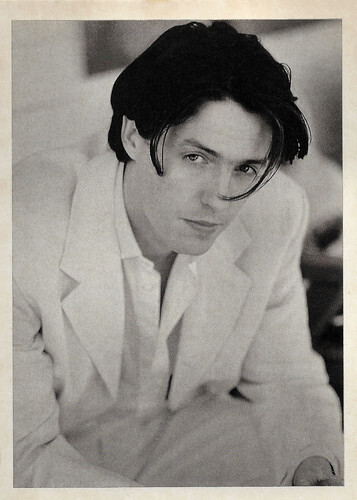
Canadian postcard by Canadian Postcard, no. A-255.
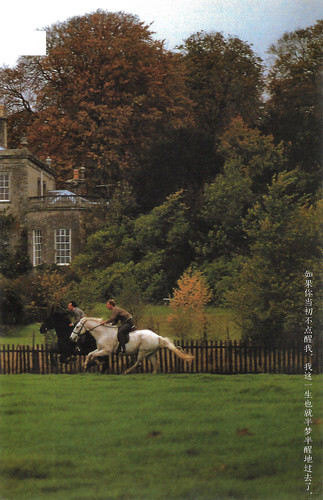
Chinese postcard. Hugh Grant and James Wilby in Maurice (James Ivory, 1987).
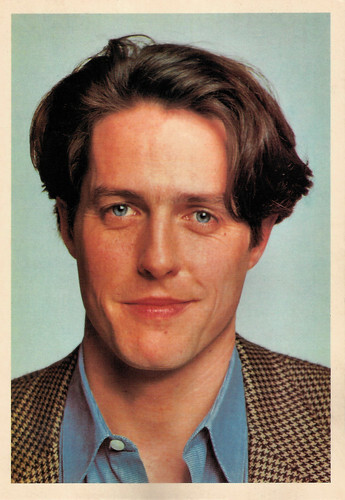
Spanish postcard in the Colección 'Estrellas de actualidad' by CACITEL, S.L., 1990, no. 101.
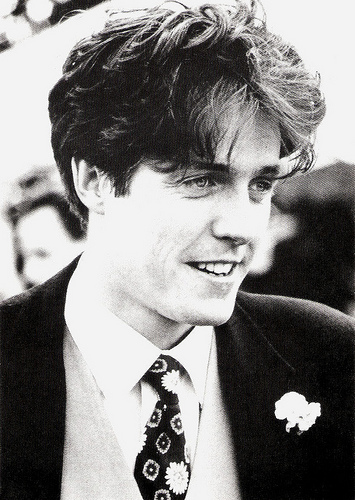
Danish postcard by Forlaget Holger Danske, no. 931.
A bohemian and debonair bachelor
At 32, Hugh Grant became an overnight international star when he played bohemian and debonair bachelor Charles in Four Weddings and a Funeral (Mike Newell 1994), opposite Andie MacDowell. The romantic comedy, written by Richard Curtis, became the highest-grossing British film to date with a worldwide box office over $244 million. Among the numerous awards for the film, Grant earned his first and only Golden Globe Award and a BAFTA Award. He signed a two-year production deal with Castle Rock Entertainment and became the founder and director of the UK-based Simian Films Limited. He appointed Elizabeth Hurley as the head of development to look for prospective projects. Simian Films produced two Grant vehicles in the 1990s but closed its US office in 2002.
Grant was one of the choices to play James Bond in GoldenEye (Martin Campbell, 1995), but he eventually lost out to Pierce Brosnan . He did play Emma Thompson's suitor in Sense and Sensibility (Ang Lee, 1995), the Academy Award-winning film version of Jane Austen's classic 1811 novel and Grant was a cartographer in 1917 Wales in The Englishman Who Went Up a Hill But Came Down a Mountain (Christopher Monger, 1995). He also performed in the Academy Award-winning Restoration (Michael Hoffman, 1995) with Robert Downey Jr. On 27 June 1995, Grant was arrested in Los Angeles, California, for lewd conduct after police checking into a ‘suspicious parked car’ found him with Divine Brown, a prostitute, in the front seat. He pleaded no contest and was fined $1,180, and placed on two years' summary probation.
The arrest occurred about two weeks before the release of Grant's first major studio film, Nine Months (Chris Columbus, 1995), which he was scheduled to promote on several American television shows. The Tonight Show with Jay Leno had him booked for the same week. In the much-watched interview, Grant was noted for not making excuses for the incident after Leno asked him, "What the hell were you thinking?" Grant answered, "I think you know in life what's a good thing to do and what's a bad thing, and I did a bad thing. And there you have it." The comedy Nine Months was almost universally panned by critics, but it proved a hit at the box office. Grant made his debut as a film producer with the thriller Extreme Measures (Michael Apted, 1996), a commercial and critical failure.
After a three-year hiatus, he paired with Julia Roberts in Notting Hill (Roger Michell, 1999), made by much of the same team that was responsible for Four Weddings and a Funeral. This new Working Title production displaced Four Weddings and a Funeral as the biggest British hit in the history of cinema, with earnings equalling $363 million worldwide. The comedy helped to restore some of Grant’s lustre.
He also released his second production output, a fish-out-of-water mob comedy Mickey Blue Eyes (Kelly Makin, 1999), that year. More successful was Small Time Crooks (Woody Allen, 2000) in which Grant played an unsympathetic art dealer. After 13 years together, Grant and Elizabeth Hurley split up in May 2000, but two years later Grant became godfather to Hurley's son Damian (2002).
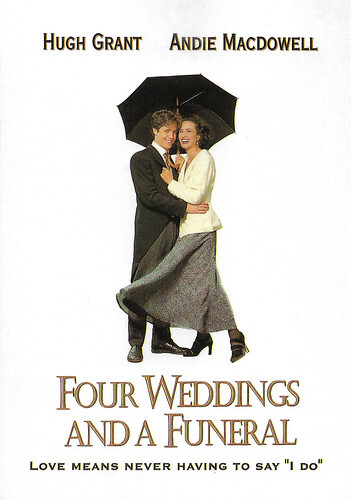
Spanish postcard by Clasicos Cinema, no. 166. Hugh Grant and Andie McDowell in Four Weddings and a Funeral (Mike Newell, 1994). Caption: Love means never having to say "I do".
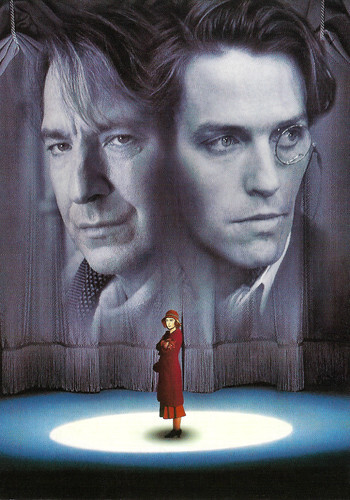
British Freecard by London Card Guide LTD, London. Alan Rickman and Hugh Grant in An Awfully Big Adventure (Mike Newell, 1995).

Italian postcard by Citrus Promotion, no. 0423. Photo: Universal / Working Title. Julia Roberts and Hugh Grant in Notting Hill (Richard Curtis, 1999).

Italian postcard by Citrus Promotion, no. 0426. Photo: Universal / Working Title. Julia Roberts and Hugh Grant in Notting Hill (Richard Curtis, 1999).
The bugger bugged
Hugh Grant played a charming but womanising book publisher in Bridget Jones's Diary (Sharon Maguire, 2001). The film, featuring Renée Zellweger and adapted from Helen Fielding's novel, was an international hit, earning $281 million worldwide. Grant also appeared as another womaniser, Will Freeman, in About a Boy (Paul Weitz, 2002), the film adaptation of Nick Hornby's best-seller At AllMovie , Michael Hastings notes: "Hugh Grant is one of the few actors since Cary Grant who can remain likeable even as he's committing near-despicable acts of dishonesty." The film earned Grant his third Golden Globe nomination, while the London Film Critics Circle named Grant its Best British Actor. About a Boy also marked a notable change in Grant's boyish look. Now 41, he had lost weight and also abandoned his trademark floppy hair. Grant was paired with Sandra Bullock in Warner Bros.'s Two Weeks Notice (Marc Lawrence, 2002), which made $199 million internationally but was panned by critics.
It was followed by the ensemble comedy, Love Actually (Richard Curtis, 2003), headlined by Grant as the British Prime Minister. A Christmas release by Working Title Films, the film was promoted as ‘the ultimate romantic comedy’ and accumulated $246 million at the international box office. In 2004, Grant reprised his role as Daniel Cleaver for a small part in Bridget Jones: The Edge of Reason (Beebon Kidron, 2004), which, like its predecessor, made more than $262 million commercially. Gone from the screen for two years, Grant then reteamed with Paul Weitz for the black comedy American Dreamz (2006), in which he portrayed the acerbic host of an American Idol-like reality show. American Dreamz failed financially but Grant’s self-loathing performance was generously praised. In 2007, Grant starred opposite Drew Barrymore in Music and Lyrics (Marc Lawrence, 2007), a parody of pop culture and the music industry. Grant learned to sing, play the piano, dance (a few mannered steps) and studied the mannerisms of prominent musicians to prepare for his role as a has-been pop singer, based loosely on Andrew Ridgeley.
He co-starred with Sarah Jessica Parker in the romantic comedy Did You Hear About the Morgans? (Marc Lawrence, 2009), which was a commercial as well as a critical failure. In April 2011, he published an article in the New Statesman ‘The Bugger, Bugged’ about a conversation with Paul McMullan, former journalist and paparazzo for News of the World . In unguarded comments which were secretly taped by Grant, McMullan alleged that editors at the Daily Mail and News of the World had ordered journalists to engage in illegal phone tapping and had done so with the full knowledge of senior British politicians. Wikipedia describes how “Grant's article attracted considerable interest, due to both the revelatory content of the taped conversation, and the novelty of Grant himself ‘turning the tables’ on a tabloid journalist”. The later revelation that the voicemail of the by then murdered Millie Dowler had been hacked, and evidence for her murder enquiry had been deleted, turned the coverage from media interest to widespread public and eventually political outrage. "Grant became something of a spokesman against Murdoch's News Corporation, culminating in a bravura performance on BBC television's Question Time in July 2011".
In November 2011, it was announced that Grant had become a father to a baby girl, Tabitha, earlier that autumn. The identity of the mother, with whom Grant had a 'fleeting affair' according to his publicist, was not at first announced; however, it was later revealed to be a Chinese woman, Tinglan Hong. In an interview on The Ellen DeGeneres Show in April 2012, Grant revealed that his daughter's Chinese name is Xiao Xi, meaning ‘happy surprise’. Grant and Hong reportedly briefly reunited in 2012. In February 2013, Hugh Grant announced that they had recently welcomed a son named Felix Chang. In the cinema, Hugh Grant played six evil characters in the epic drama film Cloud Atlas (Tom Tykwer, Andy Wachowski, Lana Wachowski, 2012). Then he appeared in another romantic comedy, The Rewrite (Marc Lawrence, 2014) with Marisa Tomei, and in the action comedy The Man from U.N.C.L.E. (Guy Ritchie, 2015), based on the legendary TV series. In 2016, he played the husband of the title character in the film Florence Foster Jenkins (Stephen Frears, 2016) starring Meryl Streep . His performance drew raves from film critics. Roger Ebert: "(Frears) coaxed Hugh Grant out of semi-retirement to play Jenkins’ devoted common-law husband St. Clair Bayfield. It’s a good thing he did, too, since Grant gives one of his finest performances ever." He was nominated for his first individual Screen Actors Guild Award and also earned nominations for a BAFTA, a Golden Globe, a Critics' Choice Award, a Satellite Award and a European Film Award.
Hugh Grant's next appearance was as Phoenix Buchanan, a villain in the live-action animated comedy Paddington 2 (Paul King, 2017) which was a commercial and critical success. In 2018, Grant returned to television after 25 years, as Jeremy Thorpe in the BBC miniseries A Very English Scandal, which marked his second collaboration with director Stephen Frears. The miniseries, and in particular Grant, were widely and highly praised. Also praised was another against-type role as a seedy and unscrupulous private investigator in The Gentlemen (Guy Ritchie, 2019), his second collaboration with the director following The Man From U.N.C.L.E. In 2023, Grant reunited with Ritchie for the action Operation Fortune: Ruse de Guerre (Guy Ritchie, 2023 alongside Jason Statham and Aubrey Plaza. Also in 2023, Grant appeared as an Oompa-Loompa in Wonka (Paul King, 2023), a film which serves as a prequel to the Roald Dahl novel 'Charlie and the Chocolate Factory', exploring Willy Wonka's origins. Grant is set to star in the upcoming Horror film Heretic (Scott Beck, Bryan Woods, 2024) and will reprise his role as Daniel Cleaver in the romantic comedy Bridget Jones: Mad About the Boy (Michael Morris, 2025).
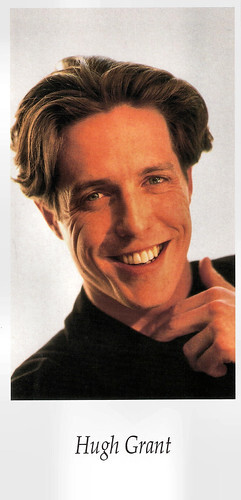
Belgian postcard by MultiChoice Kaleidoscope. Photo: Isopress / Outline (Heisler).
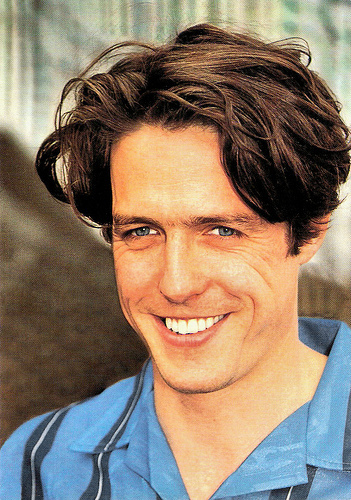
Italian postcard by World Collection, no. 541.
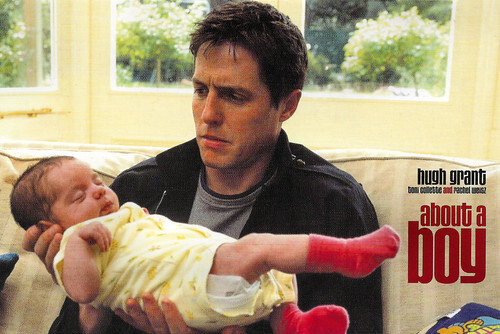
Australian Freecard by AvantCard, no. 6848. Hugh Grant in About a Boy (Paul Weitz, 2002).

Dutch postcard by Boomerang Freecards, Amsterdam, no. P23-04. Hugh Grant in Bridget Jones - The Edge of Reason (Beebon Kidron, 2004). Caption: Will you join us for the film?
Sources: Roger Ebert (RogerEbert.com), Rebecca Flint Marx (AllMovie - page now defunct), (IMDb), Michael Hastings (AllMovie - page now defunct), FilmReference.com, Wikipedia, and .

Italian postcard by World Collection, no. P.c. 688.

French postcard by OK Podium. Photo: J-M Graber.

British postcard by Heroes Publishing LTD, London, no. SPC 2773.
A sexually conflicted Edwardian
Hugh John Mungo Grant was born in Hammersmith, London, in 1960. He was the second son of Fynvola Susan MacLean, a schoolteacher, and James Murray Grant, a carpet sales representative. His elder brother, James Grant, is a successful banker. From 1969 to 1978, Hugh attended the independent Latymer Upper School in Hammersmith on a scholarship and played 1st XV rugby, cricket and football for the school. In 1979, he won the Galsworthy scholarship to New College, Oxford where he starred in his first film, Privileged (Michael Hoffman, 1982), produced by the Oxford University Film Foundation.
Viewing acting as nothing more than a creative outlet, he joined the Oxford University Dramatic Society and starred in a successful touring production of 'Twelfth Night' by William Shakespeare . To obtain his Equity card, he joined the Nottingham Playhouse, a regional theatre. Bored with small acting parts, he created his own comedy revue called 'The Jockeys of Norfolk' with friends Chris Lang and Andy Taylor. The group toured London's pub comedy circuit and proved a hit at the Edinburgh Festival. Their sketch on the Nativity told as an Ealing comedy, gained them a spot on the BBC2 TV show Edinburgh Nights. During this time, Grant also appeared in theatre productions of plays such as 'An Inspector Calls', Oscar Wilde's 'Lady Windermere's Fan', and Shakespeare's 'Coriolanus'.
His first leading film role came as a sexually conflicted Edwardian in Maurice (James Ivory, 1987), adapted from E. M. Forster's novel. He and co-star James Wilby shared the Volpi Cup for best actor at the Venice Film Festival for their portrayals of lovers Clive Durham and Maurice Hall. Despite such acclaim, Grant's next films were largely forgettable affairs except for The Lair of the White Worm (Ken Russell, 1988). Grant attained some cult status as a lord attempting to foil the murderous charms of a campy, trampy vampire (Amanda Donahoe). He had supporting parts in the BAFTA Award-nominated White Mischief (Michael Radford, 1987) and in Dawning (Robert Knights, 1988), opposite Anthony Hopkins .
His classic good looks made him a natural for romantic leads. He played Lord Byron in the Spanish production Remando al viento/Rowing with the Wind (Gonzalo Suárez, 1988). During the shooting of this Goya Award-winning film, Grant met model and actress Elizabeth Hurley, who was cast in a supporting role as Byron's former lover Claire Clairmont. Their subsequent relationship created much media attention. He portrayed another real-life figure, Frédéric Chopin, in Impromptu (James Lapine, 1991) opposite Judy Davis as George Sand. He also played Julie Andrews ' gay son in the ABC made-for-television film Our Sons (John Erman, 1991).
In Roman Polanski's Bitter Moon (1992), he portrayed a fastidious and proper British tourist married to Kristin Scott Thomas, who finds himself enticed by the sexual hedonism of a seductive French woman (Emmanuelle Seigner) and her embittered, paraplegic American husband (Peter Coyote). His work in the award-winning Merchant-Ivory drama The Remains of the Day (James Ivory, 1993) went largely unnoticed.

Canadian postcard by Canadian Postcard, no. A-255.

Chinese postcard. Hugh Grant and James Wilby in Maurice (James Ivory, 1987).

Spanish postcard in the Colección 'Estrellas de actualidad' by CACITEL, S.L., 1990, no. 101.

Danish postcard by Forlaget Holger Danske, no. 931.
A bohemian and debonair bachelor
At 32, Hugh Grant became an overnight international star when he played bohemian and debonair bachelor Charles in Four Weddings and a Funeral (Mike Newell 1994), opposite Andie MacDowell. The romantic comedy, written by Richard Curtis, became the highest-grossing British film to date with a worldwide box office over $244 million. Among the numerous awards for the film, Grant earned his first and only Golden Globe Award and a BAFTA Award. He signed a two-year production deal with Castle Rock Entertainment and became the founder and director of the UK-based Simian Films Limited. He appointed Elizabeth Hurley as the head of development to look for prospective projects. Simian Films produced two Grant vehicles in the 1990s but closed its US office in 2002.
Grant was one of the choices to play James Bond in GoldenEye (Martin Campbell, 1995), but he eventually lost out to Pierce Brosnan . He did play Emma Thompson's suitor in Sense and Sensibility (Ang Lee, 1995), the Academy Award-winning film version of Jane Austen's classic 1811 novel and Grant was a cartographer in 1917 Wales in The Englishman Who Went Up a Hill But Came Down a Mountain (Christopher Monger, 1995). He also performed in the Academy Award-winning Restoration (Michael Hoffman, 1995) with Robert Downey Jr. On 27 June 1995, Grant was arrested in Los Angeles, California, for lewd conduct after police checking into a ‘suspicious parked car’ found him with Divine Brown, a prostitute, in the front seat. He pleaded no contest and was fined $1,180, and placed on two years' summary probation.
The arrest occurred about two weeks before the release of Grant's first major studio film, Nine Months (Chris Columbus, 1995), which he was scheduled to promote on several American television shows. The Tonight Show with Jay Leno had him booked for the same week. In the much-watched interview, Grant was noted for not making excuses for the incident after Leno asked him, "What the hell were you thinking?" Grant answered, "I think you know in life what's a good thing to do and what's a bad thing, and I did a bad thing. And there you have it." The comedy Nine Months was almost universally panned by critics, but it proved a hit at the box office. Grant made his debut as a film producer with the thriller Extreme Measures (Michael Apted, 1996), a commercial and critical failure.
After a three-year hiatus, he paired with Julia Roberts in Notting Hill (Roger Michell, 1999), made by much of the same team that was responsible for Four Weddings and a Funeral. This new Working Title production displaced Four Weddings and a Funeral as the biggest British hit in the history of cinema, with earnings equalling $363 million worldwide. The comedy helped to restore some of Grant’s lustre.
He also released his second production output, a fish-out-of-water mob comedy Mickey Blue Eyes (Kelly Makin, 1999), that year. More successful was Small Time Crooks (Woody Allen, 2000) in which Grant played an unsympathetic art dealer. After 13 years together, Grant and Elizabeth Hurley split up in May 2000, but two years later Grant became godfather to Hurley's son Damian (2002).

Spanish postcard by Clasicos Cinema, no. 166. Hugh Grant and Andie McDowell in Four Weddings and a Funeral (Mike Newell, 1994). Caption: Love means never having to say "I do".

British Freecard by London Card Guide LTD, London. Alan Rickman and Hugh Grant in An Awfully Big Adventure (Mike Newell, 1995).

Italian postcard by Citrus Promotion, no. 0423. Photo: Universal / Working Title. Julia Roberts and Hugh Grant in Notting Hill (Richard Curtis, 1999).

Italian postcard by Citrus Promotion, no. 0426. Photo: Universal / Working Title. Julia Roberts and Hugh Grant in Notting Hill (Richard Curtis, 1999).
The bugger bugged
Hugh Grant played a charming but womanising book publisher in Bridget Jones's Diary (Sharon Maguire, 2001). The film, featuring Renée Zellweger and adapted from Helen Fielding's novel, was an international hit, earning $281 million worldwide. Grant also appeared as another womaniser, Will Freeman, in About a Boy (Paul Weitz, 2002), the film adaptation of Nick Hornby's best-seller At AllMovie , Michael Hastings notes: "Hugh Grant is one of the few actors since Cary Grant who can remain likeable even as he's committing near-despicable acts of dishonesty." The film earned Grant his third Golden Globe nomination, while the London Film Critics Circle named Grant its Best British Actor. About a Boy also marked a notable change in Grant's boyish look. Now 41, he had lost weight and also abandoned his trademark floppy hair. Grant was paired with Sandra Bullock in Warner Bros.'s Two Weeks Notice (Marc Lawrence, 2002), which made $199 million internationally but was panned by critics.
It was followed by the ensemble comedy, Love Actually (Richard Curtis, 2003), headlined by Grant as the British Prime Minister. A Christmas release by Working Title Films, the film was promoted as ‘the ultimate romantic comedy’ and accumulated $246 million at the international box office. In 2004, Grant reprised his role as Daniel Cleaver for a small part in Bridget Jones: The Edge of Reason (Beebon Kidron, 2004), which, like its predecessor, made more than $262 million commercially. Gone from the screen for two years, Grant then reteamed with Paul Weitz for the black comedy American Dreamz (2006), in which he portrayed the acerbic host of an American Idol-like reality show. American Dreamz failed financially but Grant’s self-loathing performance was generously praised. In 2007, Grant starred opposite Drew Barrymore in Music and Lyrics (Marc Lawrence, 2007), a parody of pop culture and the music industry. Grant learned to sing, play the piano, dance (a few mannered steps) and studied the mannerisms of prominent musicians to prepare for his role as a has-been pop singer, based loosely on Andrew Ridgeley.
He co-starred with Sarah Jessica Parker in the romantic comedy Did You Hear About the Morgans? (Marc Lawrence, 2009), which was a commercial as well as a critical failure. In April 2011, he published an article in the New Statesman ‘The Bugger, Bugged’ about a conversation with Paul McMullan, former journalist and paparazzo for News of the World . In unguarded comments which were secretly taped by Grant, McMullan alleged that editors at the Daily Mail and News of the World had ordered journalists to engage in illegal phone tapping and had done so with the full knowledge of senior British politicians. Wikipedia describes how “Grant's article attracted considerable interest, due to both the revelatory content of the taped conversation, and the novelty of Grant himself ‘turning the tables’ on a tabloid journalist”. The later revelation that the voicemail of the by then murdered Millie Dowler had been hacked, and evidence for her murder enquiry had been deleted, turned the coverage from media interest to widespread public and eventually political outrage. "Grant became something of a spokesman against Murdoch's News Corporation, culminating in a bravura performance on BBC television's Question Time in July 2011".
In November 2011, it was announced that Grant had become a father to a baby girl, Tabitha, earlier that autumn. The identity of the mother, with whom Grant had a 'fleeting affair' according to his publicist, was not at first announced; however, it was later revealed to be a Chinese woman, Tinglan Hong. In an interview on The Ellen DeGeneres Show in April 2012, Grant revealed that his daughter's Chinese name is Xiao Xi, meaning ‘happy surprise’. Grant and Hong reportedly briefly reunited in 2012. In February 2013, Hugh Grant announced that they had recently welcomed a son named Felix Chang. In the cinema, Hugh Grant played six evil characters in the epic drama film Cloud Atlas (Tom Tykwer, Andy Wachowski, Lana Wachowski, 2012). Then he appeared in another romantic comedy, The Rewrite (Marc Lawrence, 2014) with Marisa Tomei, and in the action comedy The Man from U.N.C.L.E. (Guy Ritchie, 2015), based on the legendary TV series. In 2016, he played the husband of the title character in the film Florence Foster Jenkins (Stephen Frears, 2016) starring Meryl Streep . His performance drew raves from film critics. Roger Ebert: "(Frears) coaxed Hugh Grant out of semi-retirement to play Jenkins’ devoted common-law husband St. Clair Bayfield. It’s a good thing he did, too, since Grant gives one of his finest performances ever." He was nominated for his first individual Screen Actors Guild Award and also earned nominations for a BAFTA, a Golden Globe, a Critics' Choice Award, a Satellite Award and a European Film Award.
Hugh Grant's next appearance was as Phoenix Buchanan, a villain in the live-action animated comedy Paddington 2 (Paul King, 2017) which was a commercial and critical success. In 2018, Grant returned to television after 25 years, as Jeremy Thorpe in the BBC miniseries A Very English Scandal, which marked his second collaboration with director Stephen Frears. The miniseries, and in particular Grant, were widely and highly praised. Also praised was another against-type role as a seedy and unscrupulous private investigator in The Gentlemen (Guy Ritchie, 2019), his second collaboration with the director following The Man From U.N.C.L.E. In 2023, Grant reunited with Ritchie for the action Operation Fortune: Ruse de Guerre (Guy Ritchie, 2023 alongside Jason Statham and Aubrey Plaza. Also in 2023, Grant appeared as an Oompa-Loompa in Wonka (Paul King, 2023), a film which serves as a prequel to the Roald Dahl novel 'Charlie and the Chocolate Factory', exploring Willy Wonka's origins. Grant is set to star in the upcoming Horror film Heretic (Scott Beck, Bryan Woods, 2024) and will reprise his role as Daniel Cleaver in the romantic comedy Bridget Jones: Mad About the Boy (Michael Morris, 2025).

Belgian postcard by MultiChoice Kaleidoscope. Photo: Isopress / Outline (Heisler).

Italian postcard by World Collection, no. 541.

Australian Freecard by AvantCard, no. 6848. Hugh Grant in About a Boy (Paul Weitz, 2002).

Dutch postcard by Boomerang Freecards, Amsterdam, no. P23-04. Hugh Grant in Bridget Jones - The Edge of Reason (Beebon Kidron, 2004). Caption: Will you join us for the film?
Sources: Roger Ebert (RogerEbert.com), Rebecca Flint Marx (AllMovie - page now defunct), (IMDb), Michael Hastings (AllMovie - page now defunct), FilmReference.com, Wikipedia, and .
Published on December 23, 2024 22:00
Paul van Yperen's Blog
- Paul van Yperen's profile
- 13 followers
Paul van Yperen isn't a Goodreads Author
(yet),
but they
do have a blog,
so here are some recent posts imported from
their feed.



